
HEARNE & ROBERTS I M c BRIDE MEETS MEYER I BIG EARS FESTIVAL I RHAPSODY IN BLUE, REIMAGINED I 2024 FESTIVAL DIRECTORY SPRING 2024, VOLUME 41, NUMBER 2 $5.95 CHAMBERMUSIC
Bridgehampton Chamber Music
Marya Martin, Artistic Director
Bridgehampton Chamber Music brings the world’s finest artists to Long Island’s East End each summer, presenting imaginative programs that invigorate, surprise, and move audiences. Join us for a summer of transformative concerts.

Michael Lawrence, Executive Director
212 .741 .9073
| www.bcmf.org
bcm festival
Festival recordings available on iTunes and at www.bcmf.org
Photo:
Etorre Causa © 2024 BCM
TRANSFORMATIONS
July 14 –Aug 11, 2024 41st Summer
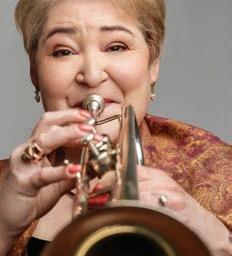
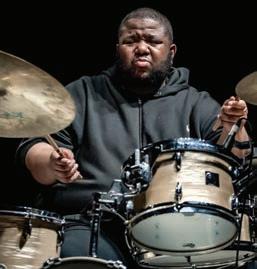
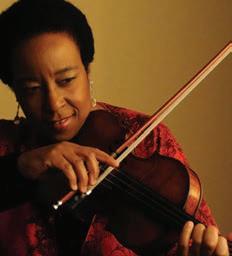



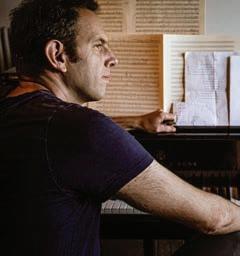

Out March 22 on XAS Records
FEATURING
Miguel Zenón alto saxophone
prismquartet.com/xas
PRISM Quartet Booking Inquiries
Trudy Chan, Black Tea Music
tc@blackteamusic.com
A new body of work exploring the ties between Black and Jewish Americans
EIGHT NEW WORKS BY Yotam
Haber, David Krakauer, Myra Melford & Erica Hunt, Diane Monroe, Ursula Rucker, Tyshawn Sorey, Susan Watts, and Fred Wesley
PERFORMED BY PRISM Quartet (saxes), David Gilmore (guitar), David Krakauer (clarinet), Diane Monroe (violin), Ursula Rucker (vocals, poetry), Tyshawn Sorey (drums, percussion), Susan Watts (vocals, trumpet), and more.
WORLD PREMIERE CONCERTS
June 8: 8:30 pm
World Cafe Live, Philadelphia
June 9: 7 pm
Roulette, Brooklyn
FREE PANEL DISCUSSIONS WITH ARTISTS
May 28, 6 pm
Weitzman Museum, Philadelphia
May 30, 4 pm
Temple University, Philadelphia
TICKETS/INFO
$10–$35 (pay-what-you-wish) at generate.prismquartet.com

PRISM Quartet Generate Music GENERATE MUSIC
PRISM Quartet Heritage/Evolution
Volume 3
Melissa Aldana tenor saxophone
Tim Ries tenor saxophone, flute Terell Stafford trumpet
PRISM Quartet Heritage/ /Evolution Volume 3 FEATU R ING Melissa Aldana Tim Ries Terell Stafford
Zenón MUSIC BY Melissa Aldana Matthew Levy
Sondheim Terell Stafford
Miguel
Stephen
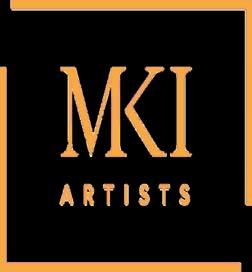

STRING QUARTETS
COMPOSER-PERFORMERS
Ariel Quartet
Arod Quartet
Quatuor Danel
Hagen Quartet
Miró Quartet
Pacifica Quartet
Parker Quartet
Shanghai Quartet
Ying Quartet
PIANO TRIO
Gryphon Trio
VOCAL ENSEMBLE
Cantus
WOODWIND QUINTET
WindSync
Gabriel Kahane
Jessie Montgomery
CONDUCTOR
Jacomo Bairos STRINGS
William Hagen
Andrei Ioniță
Rachel Barton Pine
PIANO
Rodolfo Leone
Jeffrey Kahane
Jon Kimura Parker
Orion Weiss
VOCALISTS




Gabriel Kahane
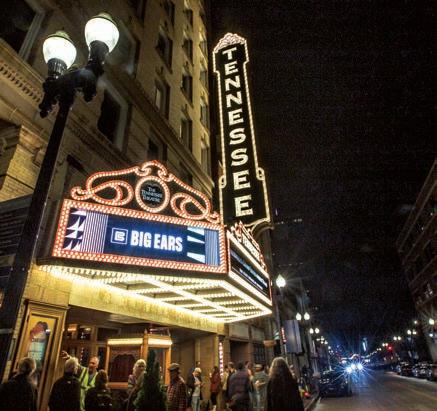
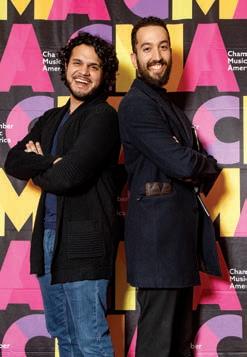
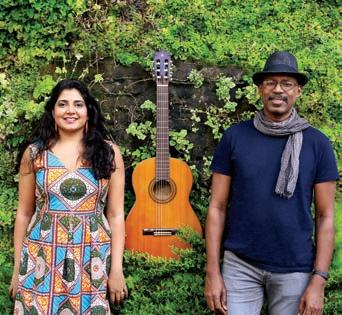
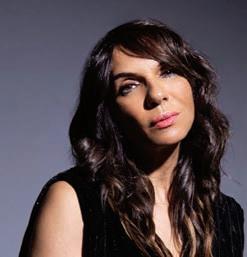
How Ashley Capps fell in love with all sorts of music, and found a way to present its full range through his Big Ears Festival.
21 SPECIAL SECTION 45 2024 DIRECTORY OF FESTIVALS, SCHOOLS, AND WORKSHOPS COLUMNS 34 CMA DUOS: Ted Hearne & Matana Roberts The composer-performers talk about changing landscapes—for their art forms, and on the literal lands we inhabit. BY Peter Margasak DEPARTMENTS 5 CMA LETTER: Bright Moments and Big News BY Kevin Kwan Loucks 6 CMA NEWS: New Ways to Celebrate National Chamber Music Month 9 AWARDS, IN MEMORIAM, SEGUES 10 AMERICAN ENSEMBLE: Kavita Shah, Khemia Ensemble, Sinta Quartet, Caili O’Doherty, Erez Aviram, Poiesis Quartet 72 CMA SCORES: Jon Irabagon’s Recharge the Blade 78 ANGELA ANSWERS: Whatever Happened to My Summer Break? BY Angela Myles Beeching 79 ENDNOTE: The Game Within the Game BY Jasper Shogo Dutz FEATURES 18 Off the Page
Lab opens up the process of creating new musical works, and reframes the often-solitary work of the composer. BY Emery Kerekes 21 Works-in-Progress, Ideas in Motion & Fresh Recognition
and reflections from CMA’s 46th-annual National Conference. 26 Finding My Rhapsody
a
BY Lara Downes 30 When Christian Met Edgar (Thanks to Ray)
BY Steve Smith
Listening Large
BY Larry Blumenfeld A Publication of Chamber Music America SPRING 2024, VOLUME 41, NUMBER 2
Concept
Photos
How
celebrated pianist, radio presenter, and arts activist found a home in George Gershwin’s centuryold classic.
A new album from bassists Christian McBride and Edgar Meyer is rooted in a surprising shared history.
40
40 26 CHAMBERMUSIC 10 ON THE COVER: Lake George Music Festival PHOTOGRAPH BY Stephanie Bartik
Photos: Cora Wagoner (Big Ears); Ebru Yildiz (Downes); Becky Yee (CMA Conference); Helder Dias (Shah)






CH AMBER MUSIC
Official publication of Chamber Music America
12 W. 32nd Street New York, NY 10001 (212) 242-2022 www.chambermusicamerica.org
Larry Blumenfeld editorial director
Andrew Frank managing editor
Steve Futterman research
Red Herring Design design
Brenden O’Hanlon advertising
CHAMBER MUSIC AMERICA
Kevin Kwan Loucks chief executive officer
Jenny Ouellette chief operating officer
Geysa Castro director of membership services
Susan Dadian associate director of grant programs
José R. Feliciano director of grant programs
Orchid McRae associate director of marketing and communications
Erica Murase associate director of development
Fabian Robinson conference and events manager
CJ Salvani membership services/ accounting associate
Ben Schonhorn social media assistant
Elva Tang grant programs administrative assistant
Ofir Tomer development associate
Adriana Vergara grant programs associate
Bright Moments and Big News
Months past the invigorating experience of our 2024 National Conference in New York City, I remain filled with a deeply resonant sense of renewal and anticipation.
The energy and enthusiasm that permeated every panel session, performance, and interaction with friends, new and old, underscored the vibrant spirit of our national chamber music community. One of my favorite aspects of the conference was the wealth of visionary leaders and artists who graced our stages and podiums. From the thought-provoking insights shared by keynote speakers Paola Prestini, Michael Abels, Terri Lyne Carrington, and Dr. Maria Rosario Jackson, to the electrifying showcases, masterclasses, new music readings, jam sessions, and our Cleveland Quartet Jubilee, each element was its own unique testament to the power of collaboration and innovation happening throughout our field all year long.
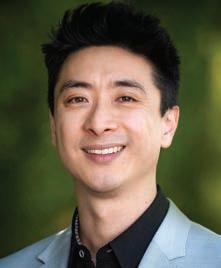
The Awards Ceremony, during which we unveiled six new awards in CMA’s portfolio, was a particularly special moment; it marked a significant milestone in our journey toward recognizing excellence and fostering diversity within our community. These awards, nominated and voted on by you, our esteemed members, serve as a powerful reminder of the boundless potential of chamber music to inspire, connect, and uplift.
I am excited to share some news that promises to reshape our collective trajectory in even more exciting ways. While New York City remains the official hub of Chamber Music America, our identity as a national service organization mandates our physical presence in communities beyond that city’s boundaries. It is with great pride that I announce that the 2025 National Conference will make its home in the vibrant city of Houston, TX, February 13-16, 2025! This transition signifies a crucial stride towards fostering equitable access and a stronger sense of unity among our national constituency.
With its dynamic cultural landscape and vibrant arts community, Houston offers a wealth of possibilities for collaboration, innovation, and growth. Together with esteemed partners such as the Shepherd School of Music at Rice University, the University of North Texas, and DACAMERA, among others, we are opening ourselves up to new perspectives, new alliances, and new opportunities to advance the cause of chamber music on a national scale. We are embracing the spirit of adventure and possibility that defines our field.
I look forward to welcoming you all to Houston in 2025, where together we will begin writing the next chapter in the story of chamber music—one filled with promise, potential, and endless possibilities.
With gratitude,
Kevin Kwan Loucks Chief Executive Officer
5
Chamber Music (ISSN 1071-1791), the official publication of Chamber Music America, is published quarterly, in Winter, Spring, Summer and Fall by Chamber Music America, 12 West 32nd St., New York, NY 10001. ��2024 Chamber Music America. Chamber Music magazine subscription price for one year ($35.00) is included in membership dues. Periodical postage paid at New York, NY and additional mailing offices. Postmaster: send address changes to Chamber Music, 12 West 32nd St., New York, NY 10001. Articles, reviews, and letters reflect the viewpoint of their individual authors; publication by Chamber Music does not imply official endorsement by CMA. Partial support for Chamber Music magazine is provided by a grant from the National Endowment for the Arts.
CMA Letter
CHAMBER MUSIC AMERICA BOARD OF DIRECTORS
chair
Bryan Young
president
Jennifer Grim
vice presidents
Mimi Hwang
Oliver Ragsdale, Jr.
secretary
John Zion treasurer
Jennie Oh Brown
chief executive
officer
Kevin Kwan Loucks
Dawn Berry-Walker
Jenny Bilfield
Nicholas Csicsko
Noah DeGarmo
Aaron P. Dworkin
Carlton Ford
Janet Green
Jennifer Grim
Natalie Haas
Juliana Han
Julian Hernandez
Edward Kim
Calvin Lee
Adriana Linares
Karim Nagi
Nicholas Phan
James E. Rocco
Sophia Contreras
Schwartz
Daniel Seeff
Wendy Sharp
Christopher Shih
Helen Sung
Samuel Torres
Dwight Trible
Melissa White
Pat Zagelow
Jeffrey Zeigler
Big Ways to Celebrate Small
National Chamber Music Month returns this May for its 13th year, with new ways to share in the joys and power of small ensemble music.
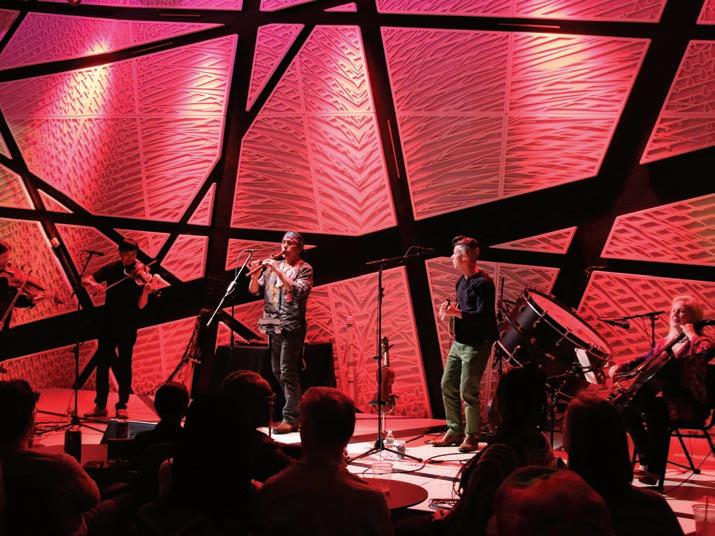
In 2011, Chamber Music America designated the month of May as National Chamber Music Month— an annual celebration of small ensemble music in its many forms, styles, and genres. Each year, we devote the month to highlighting the diverse accomplishments of our field, with the dual goals of building community and expanding public recognition of the artform and its vital social impact. This
year, we’re “Celebrating Small”—drawing special attention to the unique joys, opportunities, advantages, and challenges of the small ensemble format in a complex cultural time.
“Our community—chamber music artists, presenters, managers, educators, and others—work tirelessly, and often thanklessly, to propel the field,” said CMA CEO Kevin Kwan Loucks. “May is a time to celebrate those efforts and
6 SPRING 2024
News
ETHEL and Robert Mirabal perform at a National Chamber Music Month event in 2023.
recognize the successes. We hope you will join us in the revelry and let it energize your kick-off to summer.”
This year’s National Chamber Music Month is one of our most ambitious ever. Throughout the month, we’ll celebrate small ensemble music both online and in-person with a wide array of programming—and new perks.
◾ In South Bend, IN, we’re partnering with the Fischoff National Chamber Music Association to present a panel discussion in conjunction with the organization’s Lift Every Voice concert, celebrating historically underrepresented voices in the chamber music world. The discussion, moderated by CMA’s Kevin Kwan Loucks, will take place before the award ceremony and concert on Thursday,
May 9 at 6:00 PM and will be available to members to stream. Panelists will include lead administrators and educators from Indiana University and the University of Illinois.
◾ In Houston, TX, we’ll hold a free and open-to-the-public panel discussion on diversity, equity, and inclusion and the Houston chamber music community. Panelists will include flutist and CMA Board President Jennifer Grim as well as clarinetist Julian Hernandez, a Houston resident and founding member of WindSync. This event will also be streamed to members nationwide.
◾ In New York, NY, we’ll host a Members’ Mixer following a special presentation for our Ensemble Forward Program grantees.
◾ And on social media, we’ll showcase the stories of CMA members, feature the groundbreaking work of our grantees, and hold special ticket and membership giveaways
Details for these events will be made public as they become available; sign up for our revamped Accent newsletter and follow us on social media to stay upto-date. CMA members are encouraged to share their May events with CMA by tagging @chambermusicamerica on Instagram and Facebook, or write to us at CMAnews@chambermusicamerica.org
Not yet a member? During National Chamber Music Month, we’ll be offering exclusive promotions and added membership perks and incentives. Find out more at chambermusicamerica.org.
May is National Chamber Music Month
ELEBRATE
S LL Chamber Music America
7


CMA’S 2024 ENSEMBLE OF THE YEAR
DALÍ QUARTET
“brilliant accuracy” [Beethoven, op. 59, #3]
Washington Classical Review
“The Dalí then brought down the house with the allegramente rustico, a ferocious, dance-like rondo” Boston Musical Intelligencer
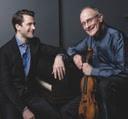
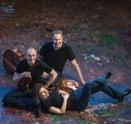
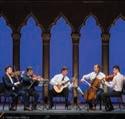






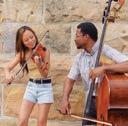
Arts and Letters
2024 New Members and Award Winners in Music
New Members
Terence Blanchard • Anthony Braxton • Libby Larsen
Steven Mackey • Roscoe Mitchell • John Williams
American Honorary Member
Rosanne Cash
Charles Ives Living
Sean Shepherd
Arts and Letters Awards
Michael Fiday • Keith Fitch
Stephen A. Taylor • Amy Williams
Virgil Thomson Award in Vocal Music
Rhiannon Giddens
Benjamin H. Danks Award
Aaron Helgeson
Andrew Imbrie Award
Anthony Cheung
Wladimir and Rhoda Lakond Award
James W. Newton, Jr.
Goddard Lieberson Fellowships
Vijay Iyer • Žibuoklė Martinaitytė
Walter Hinrichsen Award
Jesse Jones
Charles Ives Fellowships
Fang Man • Susie Ibarra
Charles Ives Scholarships
Elise Arancio • Jacob Beranek • Luke Blackburn
Liam Cummins • Isaac Santos • Justin Weiss
8 SPRING 2024 colbertartists.com ° artsmg.com * yca.org FULL ROSTER AND SPECIAL PROJECTS www.Jwentworth.com 301.277.8205 - Martha@Jwentworth.com
FRY STREET QUARTET
WEISS KAPLAN STUMPF TRIO
JASON VIEAUX & JULIEN LABRO
MAYUMI SEILER & COLIN CARR
EUNICE KIM & XAVIER FOLEY*
THE CROSSROADS PROJECT
EUNICE KIM
MARK KAPLAN & DAVID KAPLAN
Chamber Music Magazine
JASON VIEAUX & ESCHER STRING QUARTET°
artsandletters.org
Awards
The Lewis Prize for Music has announced its 2024 Awardees. They include Community Music Center of Boston, an arts education nonprofit led by former CMA Board of Directors executive Lecolion Washington
In February, the American Academy of Arts and Letters announced its 2024 Music Award winners. Among this year’s recipients are past CMA-commissioned artists Anthony Cheung and Vijay Iyer.
Segues
The Juilliard School has appointed two CMA-commissioned composers to its composition faculty: Valerie Coleman and Nina C. Young. Coleman is also a former member and founder of Imani Winds.
New England Conservatory has named Ara Gregorian its new chair of string and piano chamber music, effective this September. Gregorian, a violinist and violist, is a member of the Cooperstown Quartet and founder of the Four Seasons Chamber Music Festival.
The Shanghai Quartet, the current ensemble-in-residence at The Juilliard School’s Tianjin campus, will welcome Sihao He as its new cellist this September. He succeeds Nicholas Tzavaras
Kronos Quartet has announced the biggest lineup change in its 50-year history: violinist John Sherba and violist Hank Dutt will retire this year after more than forty-five years with the group. Joining the ensemble are violinist Gabriela Díaz, a current member of the International Contemporary Ensemble and A Far Cry, and violist Ayane Kozasa, formerly of the Aizuri Quartet.
Music of Remembrance has named attorney Lorri Staal as its inaugural executive director.
Mivos Quartet has a new cellist: Nathan Watts, who succeeds Tyler J. Borden
In Memoriam
Tony Cedras, accordionist, keyboardist, and guitarist
Jay Clayton, vocalist
Carl Grubbs, saxophonist and composer
Funmi Ononaiye, concert programmer, DJ, percussionist, and artist manager
Barbara Petersen, longtime executive for BMI Classical
Frances Richard, former vice president and director of concert music, ASCAP
Peter Schickele, composer
Marlena Shaw, jazz vocalist
9
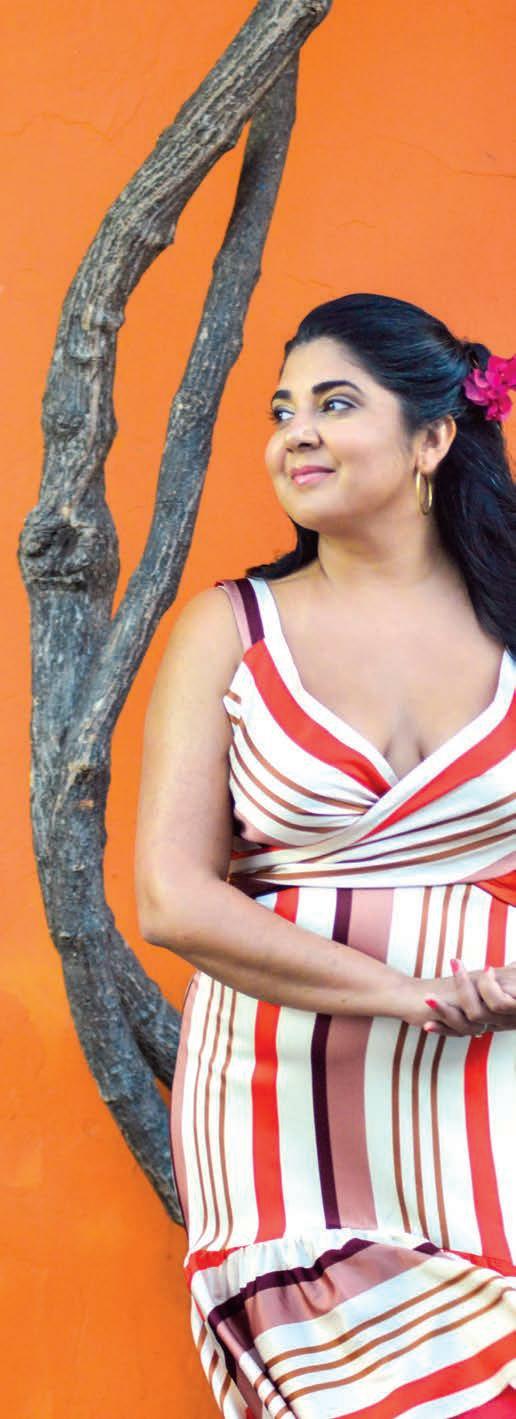
A Place to Connect
KAVITA SHAH remembers vividly the one time she saw Cesária Évora live onstage. It was late 2005, in Salvador, Brazil, during a research trip. She came upon the famed Cape Verdean singer performing at a festival and was immediately captivated.
“She was so radically herself,” Shah, an acclaimed vocalist and composer, said recently. “She would smoke, drink whiskey. She was barefoot, and what really struck me was that she was not trying to entertain the crowd. She was not smiling. She was not dancing,” Shah recalled. “She was not caring about anything except her own experience of the music.”
The moment ignited Shah’s current fascination with the music of Cape Verde, which led to Cape Verdean Blues, a recording on which she filters her own jazz inclinations through 12 songs popularized in the African country over the years. Her focus on traditional Cape Verdean morna, the country’s signature musical expression, and coladeira, a form well-suited to social commentary, is a tribute to Évora, who died in 2011.
The project evolved through a process that is by now customary for Shah—immersing herself in the ethnomusicology of various cultures around the globe. She has also researched traditional practices in East Africa, Turkey, and India. A self-described “global citizen,” Shah speaks nine languages, including Portuguese and Kriol, both common in Cape Verde.
Shah’s first trip to the country was in 2016, with a one-way ticket and no specific plan. She decided to start by learning to play the guitar-like cavaquinho. People on São Vicente, one of the ten islands in Cape Verde’s archipelago, pointed her toward a teacher named Bau. “When I got to his house and I walked in the living room, I saw this big portrait of Cesária on the wall. And I said, ‘Okay, something’s going on here.’”
Bau had been Évora’s longtime guitarist and musical director. Shah struck up a friendship with him, nurtured by her curiosity and his eagerness to keep Évora’s music alive. Her study-slash-jam session with Bau evolved into live performances and, eventually, the new album, which features other former musical collaborators of Évora’s. “I’m very lucky to be very loved and accepted by the Cape Verdean community, both abroad and locally,” said Shah, who lives in New York City. “And I think part of it is that you don’t have people in the younger generation doing this kind of music. It’s very rare.”
Among the album’s songs is “Sodade,” a melancholic hit for Évora that evokes a feeling of loss through the lens of life in Cape Verde, which Shah describes as “a transient place where people have come and gone since days past, when fisherman departed to join whaling ships.” For Shah, the song holds personal resonance. The child of Indian parents in the U.S., she lost important family members at a young age and, with them, a connection to her geographical past. She has always lacked “a sense of belonging,” she said. For her, “Sodade” offers everyone who is part of a cultural diaspora a place to connect.
Musically, Shah’s point of connection is jazz. “Improvisation is a big part of my work, and it’s not done in the Cape Verdean tradition,” she said. “So that’s kind of me putting my stamp on it.”
kavitashahmusic.com ■
BY RAY MARK RINALDI
10 SPRING 2024
■ American Ensemble
Photo: Juan Diego Duque
Kavita Shah
Building the Right Playground
The soprano Amy Petrongelli calls the KHEMIA ENSEMBLE, of which she is a member, a “playground of sound”—an apt description for a chamber group eager to explore new territories in the field of contemporary music. Khemia’s latest album, Intersections (2022), showcases a wide range of musical textures, moods, and techniques: witty sprechstimme in Philip Sink’s “Bite!”; drumkit-backed rock grooves and Bollywoodinspired melodies in Nina Shekhar “Don’t Beat a Word”; and colorful tone clusters produced with extended techniques in David Biedenbender’s “In a Field of Stars.”
Khemia Ensemble knows how to unlock the expressive potential of the Pierrot instrumentation—the combination of voice, flute, clarinet, violin, cello, and piano originally devised by Arnold Schoenberg for his chamber work Pierrot Lunaire in 1912—plus added percussionists. The instrumentalists here are Mary Matthews (flute), Thiago Ancelmo (clarinet), Er-Gene Kahng (violin), Eli Lara (cello), and Annie Jeng (piano). The added percussionists Chelsea Tinsler Jones and Shane Jones expand the music’s timbral possibilities. Asked why musicians keep returning to this instrumentation, Kahng cites its “incredible versatility . . . intimate enough to still feel like chamber music, but formidable enough to harness the power, color, and texture of a larger instrumentation.”
Such versatility has, for Khemia, lent itself to the commission and premiere of over 60 mixed-instrumentation works by professional, collegiate, and even high-school composers. Since the group’s inception in 2014, when the Argentinian composer Carolina Heredia assembled an iteration of the ensemble for a short tour in South America, Khemia has performed throughout the United States, held residencies in more than a
Khemia Ensemble: Er-Gene Kahng (violin), Annie Jeng (piano), Amy Petrongelli (soprano voice), Chelsea Tinsler Jones (percussion), Mary Matthews (flute), Eli Lara (cello), Thiago Ancelmo (clarinet), and Shane Jones (percussion).
dozen universities in North and South America, and recorded two albums. The ensemble’s coming work includes premieres of new music by Bobby Ge and Florence Anna Maunders, the winners of Khemia’s first commission competition; a dance collaboration with Music for a Great Space, a chamber music series in Greensboro, SC; and premieres of commissioned works by Anuj Bhutani and Fernanda Aoki Navarro.
It’s a busy schedule for a group of musicians who teach fulltime in colleges and universities. Yet teaching is an essential part of the Khemia’s identity, one that Tinsler Jones feels distinguishes hers from other groups. “We see ourselves as artist-educators,” she says. The expertise they offer as technicians and artists is critical to the emerging composers who collaborate with them. Petrongelli recalls the development of Lawton Hall’s Staring Contest, when the composer was a graduate fellow at the University of Wisconsin-Milwaukee. Recognizing that his struggle to get the pop-influenced vocal sound he envisioned was more an issue of vocal range than of style, she sent him recordings of the melody transcribed down a third and a fifth so he could hear the timbral differences. This turned out to be exactly what he needed.
Petrongelli has at times invited composers to send recordings of their “vocal inspirations,” as she put it, to inform her stylistic and technical input. Hall sent tracks by pop experimentalists Shara Nova and Dirty Projectors. Bobby Ge, in preparation for Pupil of Light, gave a nod to the darkly emotive indie stars Mitski and Phoebe Bridgers.
Khemia’s playground of sound is a space of the ensemble’s own design, with equal room for learning, experimentation, and imagination. www.khemiaensemble.com
■
BY ROB McCLUNG

11 American Ensemble ■
Photo: Angie Petty
■ American Ensemble
Sinta Quartet: Dan Graser (soprano), Zach Stern (alto), Danny Hawthorne-Foss (tenor), and Joe Girard (baritone).
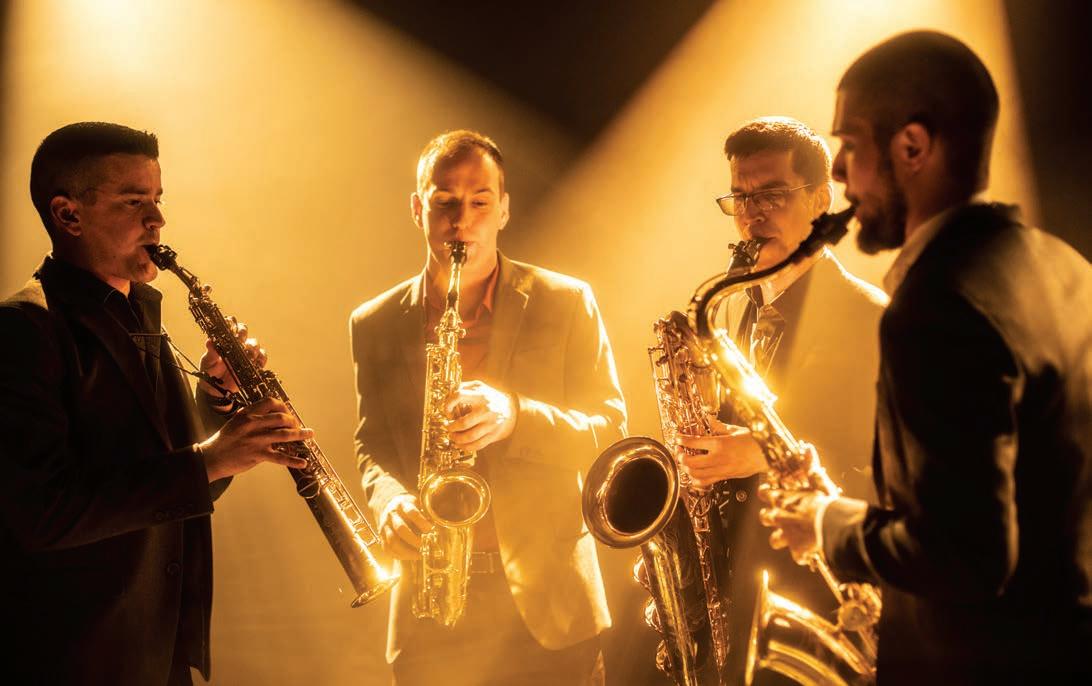
The Process Is the Goal
“A great chamber music ensemble,” saxophonist Dan Graser explains, “is one that has worked, rehearsed, listened, rehearsed some more, lived, argued, listened, lived, and rehearsed some more to the point that they speak with one sound, one intellect, one heart, a unity of expression, and clarity of texture. The listener should feel like they’ve been in the middle of an absorbing conversation among friends.”
Graser speaks from his own experience as a member of the SINTA QUARTET. He’s been conversing—musically, to an absorbing degree—with fellow saxophonists Zach Stern, Joe Girard, and Danny Hawthorne-Foss since 2010, when they debuted as soloists with the touring University of Michigan Symphony Band. All four were then students of UM’s legendary teacher Donald Sinta, in whose honor they named their quartet. The guys stuck together, listening to groups like the Tallis Scholars, Voces 8, and the Emerson String Quartet to develop their sound. They had not seriously considered becoming a professional quartet until 2013, when they won the Concert Artists Guild Award. For Girard, that was the moment they realized, “Wow, this is reality. We could really do this.”
In the ensuing years, the group received sustained attention traveling the competition circuit and performing throughout the United States. Today, their concert programs and recordings showcase their dynamic ability to perform a repertoire that spans three centuries. Their 2020 album, Ex Machina, features many fine modern compositions, from the title track (Marc Mellits’ funk-inspired, post-Minimalist work) to David Biedenbender’s three-movement Cerulean, a piece
whose memorable first movement, “Sirens,” imitates those mythological creatures through the humming, whining, moaning, and singing of saxophones. The quartet’s latest album, Sinta Quartet Plays Beethoven: op.95, op.131, op.132, moves away from contemporary music to tackle arrangements of Beethoven’s near-late and late string quartets. Here, Sinta’s members are faithful interpreters, making no alterations to the score and playing the music in its original keys.
Graser is a lifelong listener of the Beethoven quartets; he believes he owns every complete cycle on record. Still, he delights in the saxophone’s innate ability as a wind instrument to handle not just string music but also vocal music, or any that imitates the voice. The third movement of Beethoven’s opus 132, the “Heiliger Dankgesang,” is one case in point: the quartet brings a vocal quality to the movement’s chorale-like texture, swelling and breathing in perfect unison.
Such cohesion is the result of the close-knit and ongoing process Graser describes: practice, rehearsal, listening, argument, discussion, and so on. Therein lie the key to artistic growth, he says, as well as to more material success, competition prizes, and critical accolades. Graser thinks back to his University of Michigan days, and the words of his ensemble’s namesake: “You need to go home from your day’s labors with a sense of reward and the tenacity to come back tomorrow, because if it stops being rewarding you’re in the wrong business,” Sinta would say, Graser recalls. “Self-discipline, self-goals, self-reward; it’s not the paycheck that brings that for us.” sintaquartet.com
■ BY ROB McCLUNG
12 SPRING 2024
Photo: Courtesy of Sinta Quartet
United States of Everything
CAILI O’DOHERTY’s two recent projects—an original thirteenpart suite dedicated to her mother, and a tribute to the unsung pianist and composer Lil Hardin Armstrong—honor the influences of women who have shaped her identity and artistic vision. And they reflect her desire to find her own voice and place within these and other legacies.
“Suite for Gearoidin,” bearing her mother’s Irish name, was premiered at the National Jazz Museum in Harlem in November of 2023. (The hour-long performance can be viewed on YouTube.) The ambitious piece, which will be released in recorded form in 2025, illustrates O’Doherty’s penchant for throwing a wide net over the resources that jazz history offers. If much of her arresting composing reflects a contemporary conception of the post-bop structures handed down by jazz heroes including Herbie Hancock and Wayne Shorter, the mellifluous perfume of Duke Ellington’s music can also be heard in the piece’s more reflective sections. “I’m like a sponge,” says O’Doherty, who was among the five female pianists to play at the first Mary Lou Williams Women in Jazz Emerging Artist Workshop at the Kennedy Center in Washington, D.C. “I’m always studying the jazz tradition, always transcribing work from the earliest days of the music to the present.”
That all-encompassing embrace is also evident in the music of Bluer Than Blue, O’Doherty’s Lil Hardin Armstrong project, due for release this October. Armstrong—a pianist and composer whose own contributions have been too often overshadowed by the monumental impact of her then-husband Louis Armstrong— is a figure that O’Doherty feels needs to be re-evaluated. “I discovered her work when I was getting my master’s degree at Queens College,” O’Doherty says. “I was captivated by her
music, and became curious to learn more about it and her. She’s a fascinating artist because she wrote important tunes that spanned the genres of jazz, rhythm-and-blues, and pop. I wanted to honor that scope.” Bluer Than Blue documents a 2021 performance in which O’Doherty skillfully reconfigured such Lil Hardin Armstrong compositions as “Struttin’ With Some Barbeque” and “Just For a Thrill” into contemporary designs that reflected O’Doherty’s personal vision.
O’Doherty is not only an avid student of jazz history; she is also a working educator who has taught at the Savannah Music Festival Jazz Academy and Jazz House Kids. Her educational performances in New York City schools for Jazz at Lincoln Center’s Jazz for Young People program focused on the elements of democracy and civil rights inferred in the music. “Jazz music is, and has always been, a reflection of the times we live in,” she says. “We focus on musicians like Nina Simone, Charles Mingus, and John Coltrane, who used their music to speak out about racism and discrimination.” She has shared such insights more broadly, though tours to Colombia, Togo, and Benin supported by the US Department of State.
“I love when everything unites,” O’Doherty says. “When the writing, and the playing, and the teaching, the activism, and the attention to current issues are all brought together.” callimusic.com
■ BY STEVE FUTTERMAN

13
American Ensemble ■
Photo: Courtesy of Caili O’Doherty
Miles and Ziggy Johnston
Caili O’Doherty
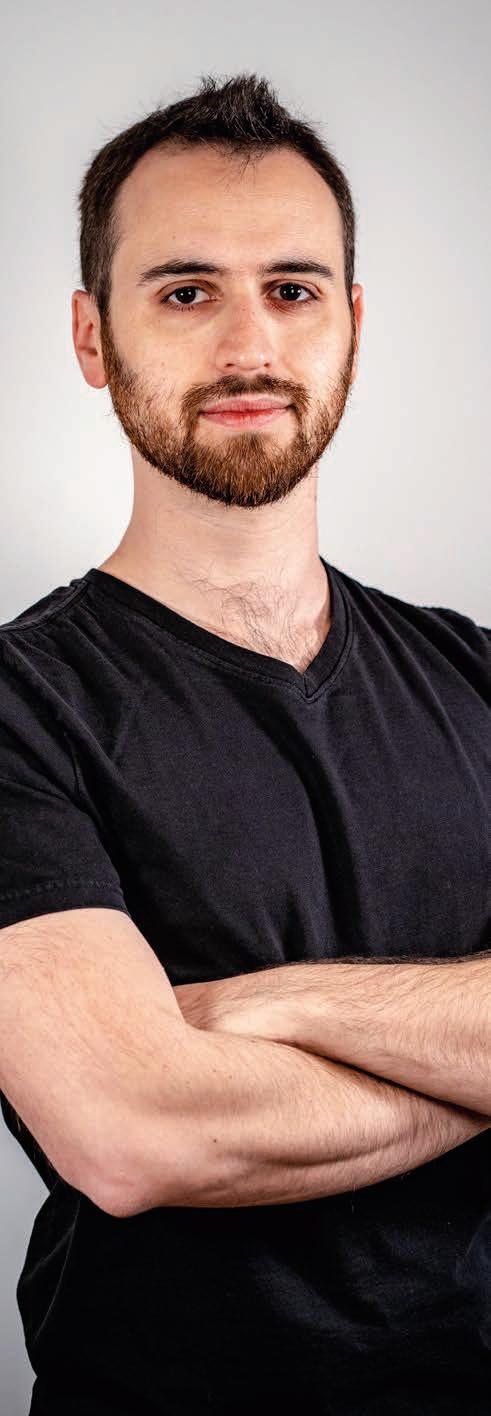 Aviram
Aviram
Finding That Sweet Spot
The pepper, that most versatile of ingredients, looms large in EREZ AVIRAM’s kitchen. “I cook a lot, and I love using peppers,” says Aviram, a Brooklyn, New York-based composer, arranger, bandleader, and pianist who relocated from Israel in 2017. “They are adaptable. They can be spicy, they can be sweet, they add unexpected flavors and colors, and I want my own music to be like that as well. I want it to be familiar, but I also want it to surprise and challenge the listener.”
Following the BEO STRING QUARTET feels more like keeping tabs on a rock band than a traditional chamber music group. In 2021, on the heels of its Heart Sleeve Triptych, the Pittsburghbased ensemble released Ghosts Revisited, a 36-minute album of original music by violist Sean Neukom that fuses alternative metal and indie rock with minimalism and neo-romanticism. Since then, Beo has built its own recording studio, started its own label, and recorded two additional albums, offering compelling performances of music by composers including Mendelssohn, Beethoven, Missy Mazzoli, Kerrith Livengood, and Kyle Sanna. Along with Neukom, the ensemble includes violinist Jason Neukom (Sean’s brother, and the group’s co-founder), violinist Andrew Giordano, and cellist Ryan Ash; each musician plays additional instruments, electronics, or provides vocals.
In its very instrumentation, the Erez Aviram Ensemble challenges the norm for a band that draws on jazz as a key ingredient. With instrumentalists playing violin and cello, electric bass, French horn, baritone saxophone, and drums, alongside a winds player alternating between flute, alto, and soprano saxophones, plus the leader’s piano, the octet defies easy categorization.
Such openness to instrumental diversity draws upon Aviram’s experience as a freelance arranger in a wide range of musical contexts and to the variety encountered in his adopted city. “The pool of talent in New York is phenomenal,” he says. “Whatever sounds I can imagine I can find accomplished musicians to play them. In this ensemble, I can have a compact string section and a horn section that can produce orchestral colors, while also having a rhythm section that can bring the groove that I want.”
Their latest album, triggerLand, is a milestone in their creative development. Like Ghosts Revisited, triggerLand is a Sean Neukom composition with a narrative arc. Yet it’s far more ambitious in scope, a real Gesamtkunstwerk that blends music, film, and visual art in an eight-part allegory on the current gun crisis. The album, which was released on streaming platforms in May, stands alone as a listening experience, but each part’s corresponding film adds further dimension to an already multilayered work. “triggerLand exists as an album and a movie,” said Neukom, who has released one film per week on Beo’s YouTube channel. “Though both use the same music, the experience of each is quite different.”
That openness also derives from Aviram’s early training in classical music—he received his undergraduate degree in composition from Jerusalem Academy of Music and Dance—and it draws upon an often-overlooked aspect of this tradition. “I love that such iconic composers as Bach and Vivaldi wrote music that wasn’t confined to one specific instrument,” he says. “Their work could be played anywhere on whatever instrument was available.”
As Aviram explains, his music is, first and foremost, modular. “I want to be able to have the music incorporate any number of different instruments—the instrumentation is almost irrelevant. The ensemble can get bigger or smaller. I can see using a viola de gamba or a singer; I want to be able to move it in any direction I imagine.”
This is certainly true of the two films. Both album and film follow Alvin, a miner who forges the very first bullet, reaps unthinkable profits from firearms, and turns his idyllic town into a dystopia. triggerLand carries the weight of myth, charting a fall from grace—the first gun-related homicide. Onscreen, its characters appear as masked, speechless figures. Sean Neukom, the film’s director-producer, heightens visual impact with color saturation, contrast, and shifts in hue. In the first film, an intensely yellow stop-motion excavator crawls across a psychedelic landscape of black pastures and icy blue mountains. An electric bass pounds a rhythmically-charged pedal point as the quartet burns, in unison, through a modal tetrachord. This introduction captures the otherworldliness of triggerLand and compels listeners to think big.
Only six recorded ensemble pieces from Aviram are currently available online (plans for an album to be recorded later this year are in the works). Yet the eclectic nature of his music is adequately conveyed through these half-dozen selections, as is the arc of his own development, which, at various times, included intense immersion in classical music, a later prog-rock fling, and a current fascination with jazz.
In a sense, that’s the point of triggerLand and Beo’s previous output, all of which Neukom calls “concept albums.” The concept? “A linear experience where each point along the way helps build a whole larger than any of the individual components,” he explained. “Especially in today’s climate of streaming and digital players, the label of ‘concept album’ helps denote the intention that the entire album is the experience.”
Such tracks as “Did I Stutter” and “Drift” set off arresting syncopated phrases against jaunty melodies and swirling solos. “Tango Diego” suggests romantic sweep within an intricate group arrangement. The music combines jazz improvisation, orchestral sweep, funk beats, and well-measured seasonings from a wide range of traditions. As is so often the case with cooking, it’s about finding the right balance.
“My musical mission now is to reach a sweet spot,” he says, “that is both intellectual and approachable.” erezaviram.com
Beo’s experimentation with genre-crossing textures and studio effects such as live sound processing suggests a paradigm established more by The Beatles than the Borodin Quartet. Their adventurous spirit has led to an album whose harrowing opening should captivate listeners and keep them engaged through a cathartic ending, along the way registering powerful musical and political statements. www.beostringquartet.com
■
BY ROBERT McCLUNG
■
BY STEVE FUTTERMAN
14 SPRING 2024
■ American Ensemble
Photo: Dror Pikielny
Erez

Fast (Yet Patient) Acts of Creation
A year and half past formation, the POIESIS QUARTET is still finding a firm footing and a durable identity. “We know we work well together, we know we have chemistry, and we know we have something special as a group,” said cellist Drew Dansby. The budding ensemble has scored some big successes thus far, including the grand prize at the 2023 Fischoff National Chamber Music Competition. Having completed a Midwestern US tour and another in Uruguay, the group is now planning yet more tours and competitions, including a stop at the prestigious Banff International String Quartet Competition, in Alberta, Canada.
The four musicians, each between 21 and 23 years old, first played together seriously in the fall of 2022, while at the Oberlin Conservatory of Music’s advanced string quartet seminar program. “We weren’t going to stay together if we didn’t win the Fischoff,” Dansby said. “Then we did, and it opened up a lot of things for us.” In January, the four players began a twoyear program at the University of Cincinnati CollegeConservatory of Music, for which they are studying with the noted Ariel Quartet and pursuing artist diplomas. “What we were thinking is that we will use this time to build our repertoire and figure out what we want as a quartet—what we want to say and what our vision is,” Dansby added.
Violinist Sarah Ma—the other members are violinist Max Ball and violist Jasper de Boor—discovered the word “poiesis” in a class during her initial studies at New York’s Juilliard
School. “The more I read about ‘poiesis’”— which means “the emergence or creation of something that didn’t exist before”— “the more I thought it resonated with us as a group,” she said. By that, she means the quartet’s ambition for each performance to be fresh and distinctive, emphasizing music by contemporary and under-represented composers and exemplifying multidisciplinary collaboration.
One of the ensemble’s favorite works is Chinese-Canadian composer Kevin Lau’s String Quartet No. 3 (2014), which combines baroque, rock, and classical influences. The Poiesis played it at the 2023 St. Paul String Quartet Competition, where it took home the gold medal and the BIPOC prize, and again at the CMA National Conference in January. “That type of music is exciting for us to play because it invokes all the backgrounds and experiences that we individually have,” Ma said, making reference to the ensemble’s diverse makeup. Yet this focus on the new does not mean the group sidesteps Beethoven or Mozart. “We can play these classics alongside all these different genres and styles, and that’s what really resonates with not just us, but the majority of audiences,” she said.
The ensemble’s goal is to be a full-time quartet, but its members know this requires both a lot of work and a little luck. “It’s kind of overwhelming,” Dansby said. “because of the volume of expectations and hopes for ourselves as a group, it feels like we have to go achieve all of them right now. But we do have some time.” poiesisquartet.com ■
BY KYLE MacMILLAN
15
American Ensemble ■
Photo: Courtesy of Poiesis Quartet
Poiesis Quartet: Sarah Ma and Max Ball, violins; Jasper de Boor, viola; and Drew Dansby, cello.
ISA SAPIN
Poulenc Trio
Oboe l Bassoon l Piano

In their first two decades, the Poulenc Trio has . . . l Performed hundreds of concerts l Reached thousands of school students l Appeared in 46 States (Alaska, Maine, Montana, Wyoming, we’re coming for you!) l Commissioned 22 new works and numerous arrangements
“Beautifully played . . . effortless lightness and grace.”
—WASHINGTON POST
Special programming: “In Her Voice” — collaborations with Hanzhi Wang, accordion and Shawnette Sulker, soprano
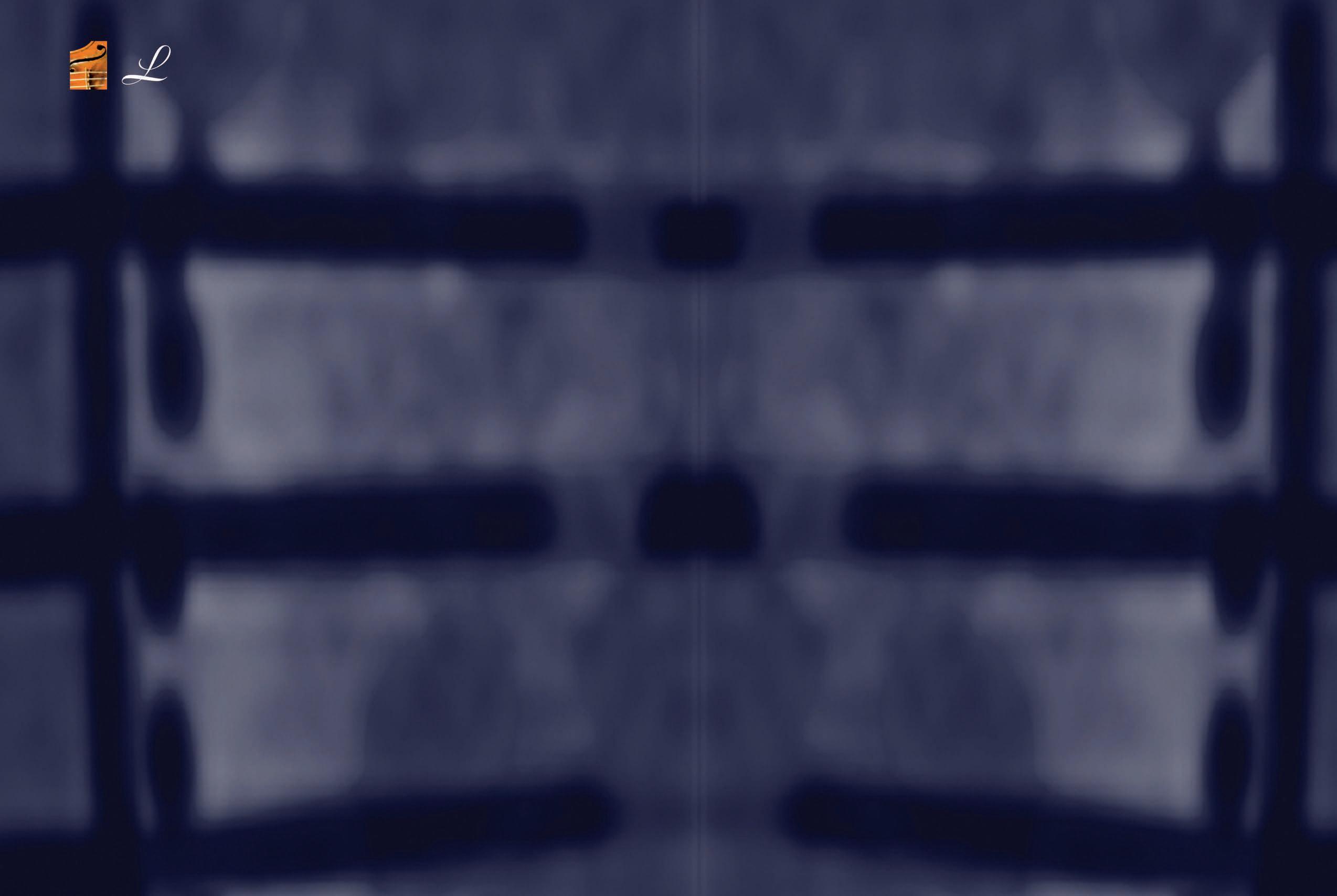
The Chicago Piano Quartet
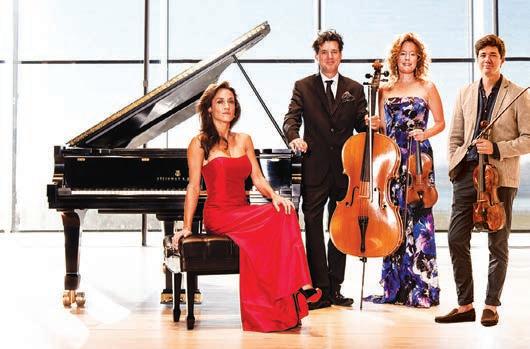
Q: When does 3 + 3 = 4?
A: When one of the world’s finest piano trios (Lincoln Trio) and string trios (Black Oak Ensemble) have two members in common!
The result is a superb ensemble whose programming embraces piano quartets, piano trios and string trios, including many commissions.
Black Oak Ensemble Beo String Quartet
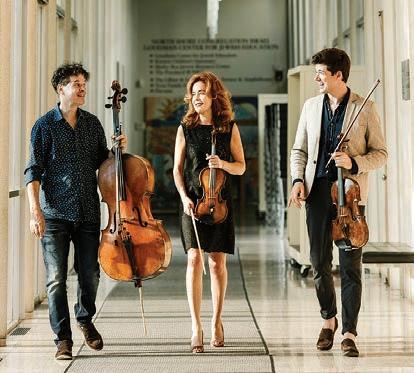
#1 ON BILLBOARD CLASSICAL CHARTS FOR THEIR LATEST CD, “AVANT L’ORAGE.”
WINNER, AMERICAN PRIZE FOR CHAMBER MUSIC
“Fierce eloquence.” —THE TIMES (London)
“Insightful, committed and masterful performances 10/10.” —CLASSICS TODAY
“Flamboyant vitality . . . expert performances.”
—CHICAGO TRIBUNE

“Absolute purity of intonation . . . [and] that supernatural ‘one-ness’ of interpretive intent that animates the best quartets.”
—NEW YORK CONCERT REVIEW
“A superb concert . . . invigorating and deeply satisfying.”
—NEW YORK CLASSICAL REVIEW
Program highlights: works by Latin GRAMMY-nominated Mexican composer Gabriela Ortiz; Clarice Assad; Missy Mazzoli; & Beo’s own violist, Sean Neukom.
800-923-1973, 510-428-1533 l lsapinkopf@aol.com l www.chambermuse.com

Spanish Brass
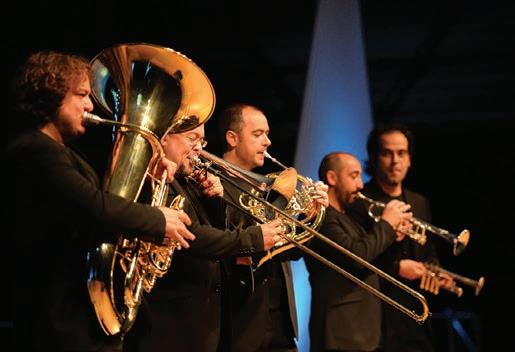
“Everyone who heard them was completely blown away and elated . . . artistry and musicianship. They have transformed not only the brass quintet, but indeed the idea of chamber music itself. Over 30 years of playing together they have become one instrument with five players.”
—MERRIE KLAZEK, Professor of Trumpet, University of Victoria, BC
The Queen’s Six A cappella ensemble from Windsor Castle

Featured on CBS Sunday Morning in its tribute to Queen Elizabeth.
“One senses . . . the evident enjoyment they derive from singing together. It brings a kind of twinkle to the performance that it is hard to find in the proliferation of groups of this type . . . barely contained excitement . . . this music is in the blood of these singers.” —GRAMOPHONE
Vida Guitar Quartet From the UK

“It’s so easy to imagine you’re listening to an entire orchestra . . . exquisite musical instinct . . . There’s only one word for it: Magic.” —GRAMOPHONE
“Vida conjure up an orchestral palette of colour and effect . . . technical brilliance and precise ensemble.”
—CLASSIC FM MAGAZINE (UK)
Special collaboration with soprano on Villa-Lobos’s Bachianas Brasileiras No.5 and songs by De Falla and Rodrigo.
Italian Saxophone Quartet
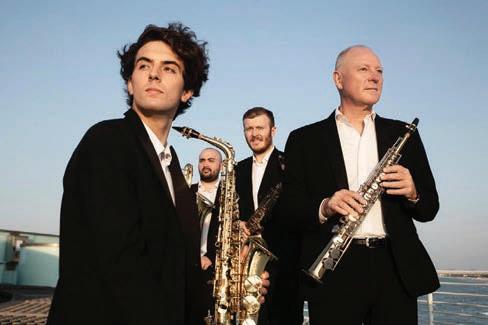
“Every note of the evening was exquisite . . . spanned the globe and musical styles . . . perfection of style, timing, and showmanship . . . they had us all dancing and frolicking right along with them . . . Bravissimo!”
—SARASOTA HERALD TRIBUNE
“As close to a religious experience as you could get without being in church.” —L.A. OBSERVED
S T R I N G Q U A R T E T : B E O S T R I N G Q U A R T E T T R I O S : B L AC K O A K E N S E M B L E St r i n g Tr i o l LINCOLN TRIO l P O U L E N C T R I O O b o e , B a s s o o n , P i a n o l MUSIKARAVAN O T H E R E N S E M B L E S : C A V AT I N A D U O F l u t e & G u i t a r l C H I C A G O P I A N O Q U A R T E T l D E L I R I U M M U S I C U M C h a m b e r O r c h e s t r a F A N D A N G O ! F l u t e , G u i t a r, V i o l i n , C e l l o l I T A L I A N S A X O P H O N E Q U A R T E T l M U S I K A R AVA N St r i n g E n s e m b l e T H E Q U E E N ’ S S I X A C a p p e l l a E n s e m b l e f r o m W i n d s o r C a s t l e l S PA N I S H B R A S S l V I D A G U I T A R Q U A R T E T J A Z Z / L A T I N : C L A R I C E & S É R G I O A S S A D B r a z i l i a n Vo c a l s , B o s s a N o v a , J a z z P i a n o , G u i t a r S O L O A N D D U O A R T I S T S : A Z N A V O O R I A N S I S T E R S C e l l o & P i a n o l D U O B E A U X A R T S P i a n o D u o a n d F o u r - H a n d s E D E N S T E L L G U I T A R D U O l KO U Z O V D U O C e l l o a n d P i a n o l A N T O N I O M E N E S E S , C e l l o a n d PA U L G A L B R A I T H , G u i t a r S T E F A N M I L E N KO V I C H , V i o l i n a n d M A R T A A Z N A V O O R I A N , P i a n o l I LYA YA K U S H E V P i a n o KOPF
ARTISTS
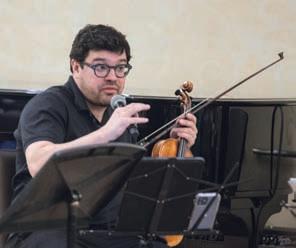

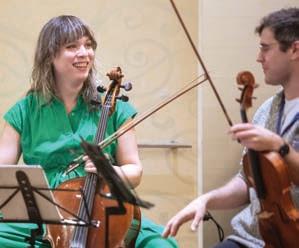

OFF PAGE THE
Concept Lab opens up the process of creating new musical works, and reframes the often-solitary work of the composer.
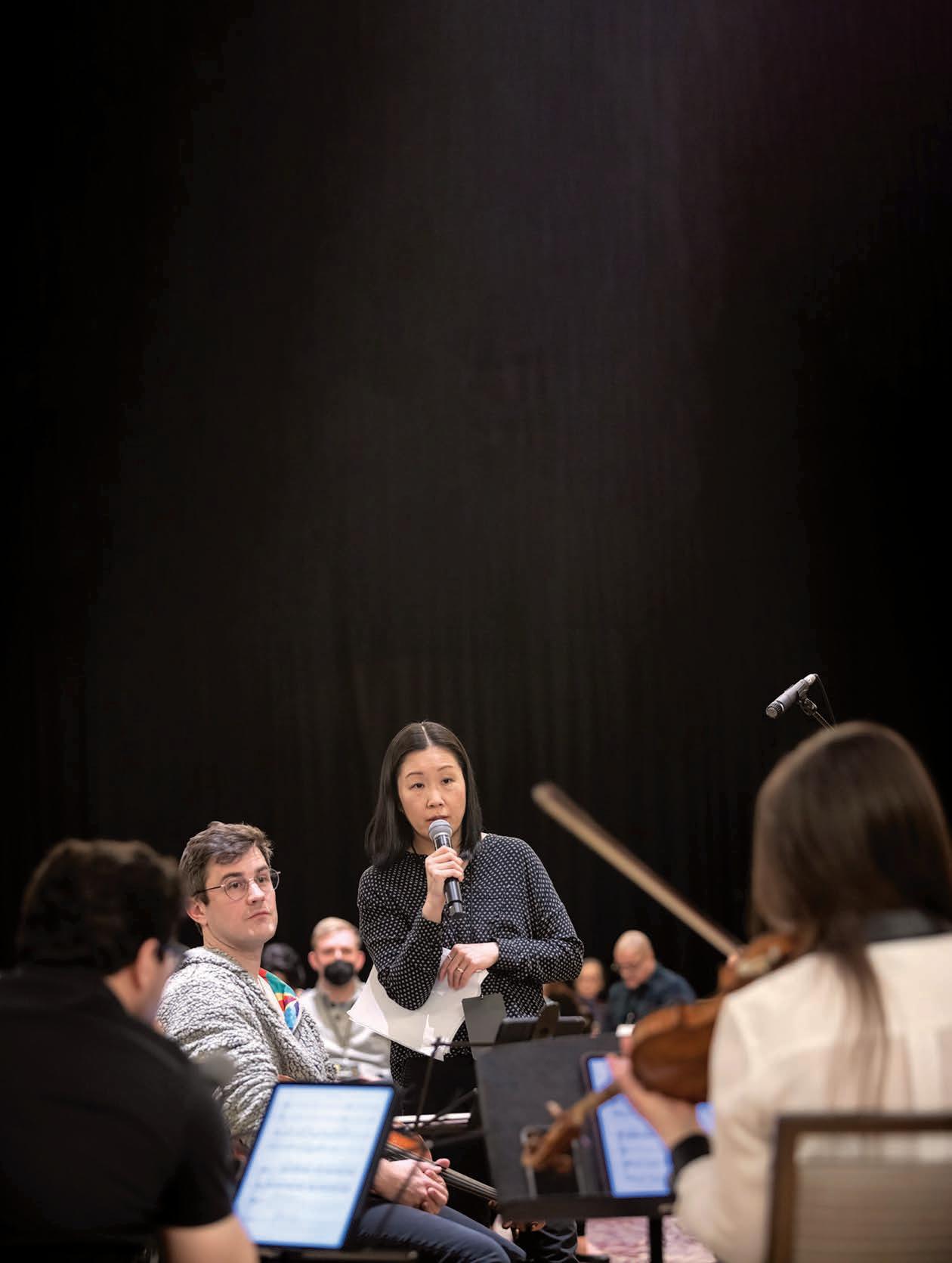 BY Emery Kerekes
BY THE YELLOW LIGHT
BY Emery Kerekes
BY THE YELLOW LIGHT
OF A
HOTEL
ballroom chandelier, in a mid-morning session on the second day of Chamber Music America’s annual conference, Attacca Quartet—two-time Grammy Award winner, with repertoire ranging from the string quartet’s roots to its latest frontiers—is sightreading Will Stackpole’s Halation Sketches. When the musicians reach page twelve, their forward motion, graceful thus far, grinds to a confused halt.
At that point in the score, three new staves suddenly join the customary four-voice layout. At first glance, these pitchless parts look like they could be auxiliary percussion but, rather than rhythmic noteheads, single dotted lines extend from neutral-cleffed staves. The lines slope up and down to indicate what seems like relative pitch, their steepness fluctuating to mark change over time.
“What are those?” asks violist Nathan Schram, using his bow to point at the mystery clefs on his iPad screen.
“That’s where you detune,” Stackpole says, cheerily. The dotted lines, the composer explains, will guide the tension of the musicians’ strings as they pluck coarsely behind the bridge.
“Oh no,” says Schram reflexively—and perhaps a bit too emphatically, he realizes, when the audience erupts into laughter.
Here, the Attaccas served as test subjects for a special CMA conference iteration of Concept Lab, a unique model of composer readings created by the Chicago organization Access Contemporary Music (ACM) and its executive director, the composer Seth Boustead. Rather than focusing on pieces at or near their final drafts, Concept Lab stipulates that composers bring in-progress works to hone in front of audiences, providing a plain view of a process that so often happens behind closed doors. It’s a rare opportunity to workshop granular ideas with real-time reactions, questions, and
When an audience hears a newly commissioned piece, it’s a final version that’s been edited for days, even weeks. Concept Lab sketches come too early in the compositional process for that manicured perfection; the audience gets a plain view at the trial-and-error that so often happens in hypotheticals.
feedback—and without the onus of a crisp, clean product.
Concept Lab revolves around its orientation as an early step in the compositional timeline, said Boustead. In the traditional commissioning model, the dialogue between composer and performer often only flows one way— the composer is generally expected to show up to the first rehearsal with a final score, subject only to minor adjustments. “Traditionally, the musicians act as a mouthpiece for the ‘genius’ composer’s work,” Boustead said. “Concept Lab throws that idea on its head: we want the composer to take this feedback and use it in a way that’s musically productive.”
The three composer participants at CMA’s iteration of the Lab—Stackpole, Liza Sobel Crane, and Asuka Kakitani— agreed that producing a “work-in-progress” fit for public eyes required a radical shift of mindset. “It’s easy to write frenetically for three weeks and end up with a finished piece,” said Stackpole. In several cases, the sketches presented at the workshop would turn out to be the final product; at the time, none of the three pieces-in-progress had planned premieres, though the Boulanger Initiative (which co-presented the conference session) would grant a commission to at least one of the participants.
and finish. The three participants’ radically different approaches to their sketches (and their time spent with the quartet) were a testament to the many possible routes a composition can travel from blank page to complete composition. With her OWLS / TREES, Asuka Kakitani focused on a sense of narrative, mapping moments of the piece to the quotidian life of a barn owl. With flurries of harmonics, her score notes explained, the owl spread its wings; with rippling sixteenth notes, it took flight; and with grotesque bow whaps, it stopped to feast on a hapless bit of prey.
THEORETICALLY, A WORK CAN BE “in progress” at any point between start
The questions that Kakitani spread around her score mostly focused on what and which. Should the tempo stay consistent through this transition, or change? Should the bow taps be Col legno battuto (where the wood of the bow bounces off the string) or crini battuto (where the hair pads the wiry wooden clicks)? For Kakitani, a pianist and composer originally trained in jazz, the string quartet was relatively new territory; experimenting with novel sounds and textures without pressure to decide yet was a welcome luxury, she said. She only wished the audience had gotten to add its own feedback to the mix. Boustead mentioned that audiences can do so at ACM’s quarterly Concept Lab readings in Chicago—a piece for piano and amplified cactus recently caused a stir there—but at the conference, limited time kept the spectators’ input to a simple yes-or-no nod.
19
Photos: Becky Yee
∂
The Attacca Quartet workshops new works by composers Asuka Kakitani (bottom); Liza Sobel Crane (top, second from left); and Will Stackpole (top, far right) at the CMA National Conference.
In a way, all three Concept Lab participants bared their souls in that Times Square Westin ballroom on that frigid January Friday.
Liza Sobel Crane, a Chicago-based composer, didn’t embed explicit questions in her unnamed sketches. Still, similar questions of “what” and “which” bubbled up. Rather than filling her scores with question marks, each excerpt came in several numbered iterations, almost like one would find on a film-set clapboard for various “takes.” The differences ranged from small variations in inflection and bow placement to larger questions of vertical interplay between parts—and by the end of Crane’s half-hour, Attacca had begun to weave her versions together, significantly widening the possibilities.
Crane was the only Concept Lab participant with prior experience workshopping unfinished works, by way of Gabriela Lena Frank’s Creative Academy of Music. Frank encourages her students to examine their own compositional processes much in the same way that Crane approached her Concept Lab sketches: a minute or two of music, written in several discrete ways, to be finished several months later. She was open and excited at the possibility of Attacca combining her different concepts: “You might only like one of them, or you might like all of them,” said Crane. “It doesn’t have to be an either-or.”
If Kakitani and Crane centered their experimentation around questions of “what” and “which,” Will Stackpole’s Halation Sketches dove headlong into “if.” He built an entire world around his
fragments, laying out a complex, bespoke notational index of noises, both instrumental and vocal. Some of them were easy enough to execute—plucked thuds from behind the bridge, sharp breaths in and out. Others seemed forbiddingly difficult, though Attacca breezed right through them: Even while singing and playing simultaneously, their correct-note count was dizzyingly high.
Stackpole ran into more logistical bumps than either of his colleagues during his half-hour with Attacca. Though he was relieved to learn (from collective nods when he asked) that the audience could hear the quartet’s fingernails scratching on the thread at the tips of their strings, cellist Andrew Yee noted that after a few minutes of clawing, her thread was all but shredded. It wasn’t a huge deal, she assured him, though the bare steel string beneath the wound thread changed the sound drastically.
And then, that detuning incident, courtesy of the score’s twelfth page. By the end, even Attacca’s perplexed violist agreed that the effect was singularly cool. Yet the score provided no time to ensure the instruments returned to their usual pitch for the following section; fix that, the violist said, and he’d quit complaining. ∂
IT’S NO SECRET THAT CONCEPT LAB is a rare opportunity for its participants, but it also lends unprecedented insights to its spectators. When an audience hears a newly commissioned piece, it’s a final version that’s been edited for days, even weeks. Concept Lab sketches come too early in the compositional process for that manicured perfection; the audience gets a plain view at the trial-and-error that so often happens in hypotheticals. Especially in the case of works meant for reading sessions—where the end goal is
often a usable recording for applications to grants, jobs, or competitions—live instruments don’t typically play the piece at any point during this typically solitary process. Composers have to make assumptions about what does and doesn’t work based on knowledge from textbooks and prior experience, rather than direct feedback.
Above all else, Concept Lab places composers in a vulnerable spot: In a way, all three participants bared their souls in that Times Square Westin ballroom on that frigid January Friday. Presenting sketches of a composition is almost like presenting an outline of an essay: it’s a clear, streamlined view into the way one’s brain intuits the creation process. Many like to keep those early stages behind closed doors, obsessing in private before letting any audience near their work. In a way, that feeds into the historical mystique of the “genius composer.”
Boustead says that lifting the shroud of mystery is tough, but ultimately rewarding. Composers have to obsess over their final products—after all, that’s the performer’s bare starting point. But when a composer re-contextualizes their goal away from the finished work, Boustead says, it takes some of the pressure off. Rather than the performers serving as mouthpieces for the “genius,” the constructive dialogue flows freely in both directions, allowing for experimentation that’s often more productive.
“Maybe composers are geniuses. Maybe they’re not. What’s more fun is to play, to have fun, to try out new ideas,” said Boustead. “Composers always worry about whether they wrote a masterpiece. Who cares?!”
Winner of the 2022 Rubin Prize in Music Criticism, Emery Kerekes has contributed to Early Music America, San Francisco Classical Voice, and Opera News, and Which Sinfonia, of which he is a founding editor.
20 SPRING 2024
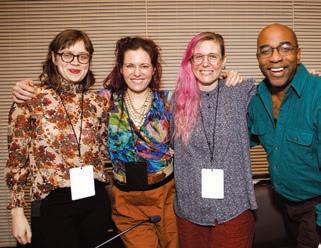

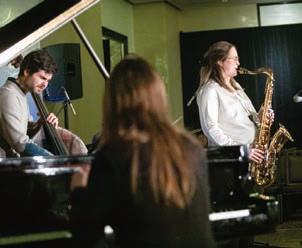
WORKS-IN-PROGRESS, IDEAS IN MOTION & FRESH RECOGNITION: CMA ’ S 46
TH NATIONAL CONFERENCE
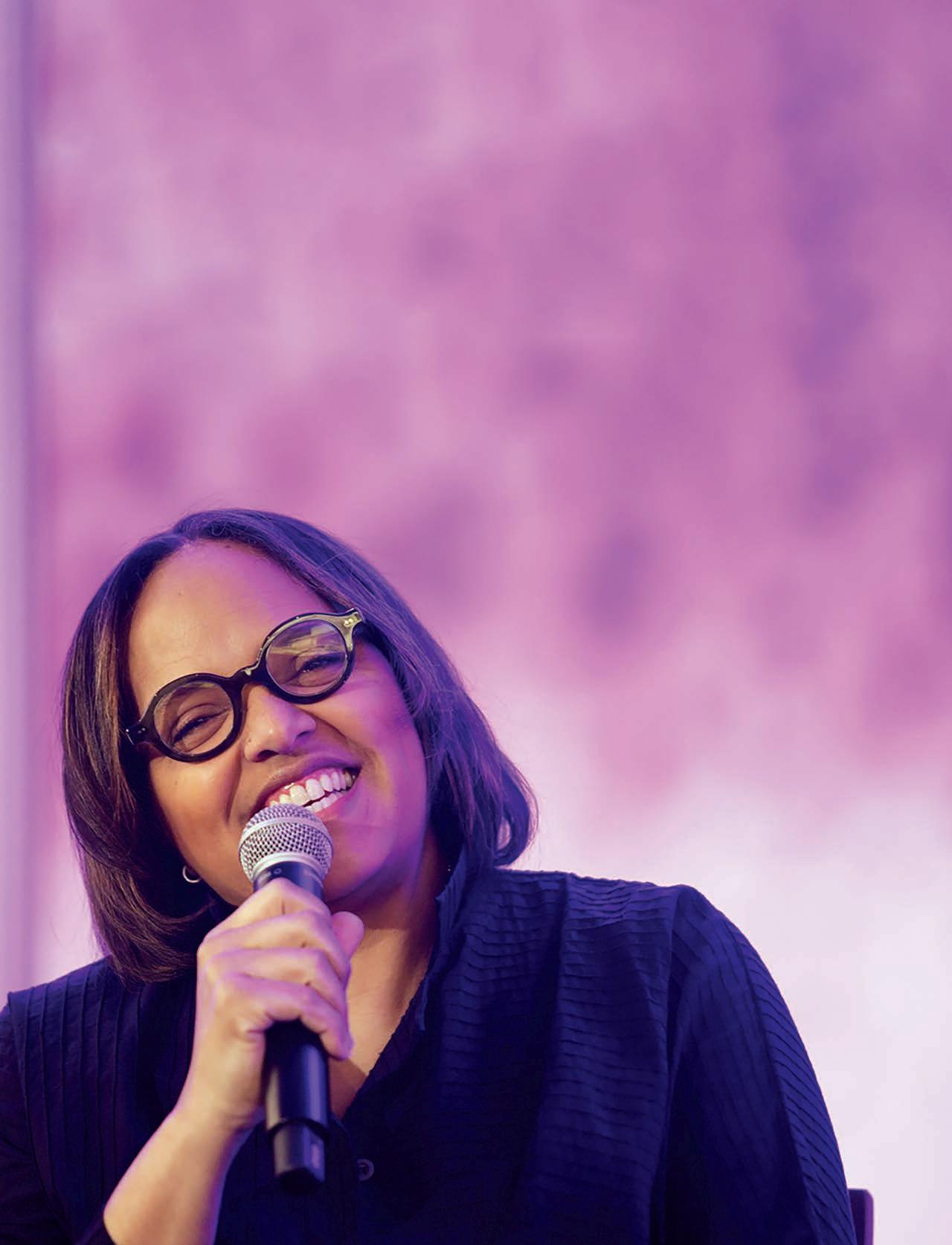
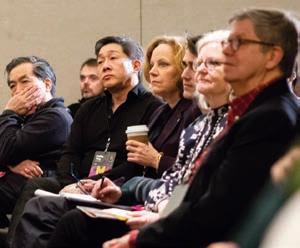
“As soon as I started thinking, ‘If I can play the drums the way Mahalia Jackson sings,’ then I began doing something. I don’t know what that really sounds like, and I don’t know if I’ll ever do it, but just thinking about it like that shifted some things in my playing and my music.”
Photos and reflections from our annual gathering in New York City PHOTOS BY Becky Yee Photography
— Terri Lyne Carrington, Saturday Keynote conversation
Top: Rebecca Nelson, Tracy Cowart, Sian Ricketts, and James Dargan; Carlos Rubio and Jesús Morales of the Dalí Quartet; Caili O’Doherty Quartet; audience members for a keynote conversation. Below: Terri Lyne Carrington.


2024
WAS A YEAR OF MANY FIRSTS AT THE CMA NATIONAL Conference. There were new events, new awards, new faces, and fresh opportunities for collaboration. For the first time ever, attendees could watch a composition come to life before their very eyes in the Concept Lab, a stunning window into the creative process. They could walk down the hall and into a cross-genre jam session with their peers. They could see live music of vast stylistic breadth and impressive technical accomplishment each and every night and learn about its creation, all without leaving the conference venue.
As much as the Conference showcased the new, it was equally rooted in history and legacy. On Saturday evening, The Cleveland Quartet, a group whose influence on the chamber music field knows no bounds, gathered for an unforgettable reunion and tribute, featuring performances by the Verona, Parker, and Borromeo String Quartets. The next morning, CMA CEO Kevin Kwan Loucks announced the creation of six new awards, honoring ensembles, new works, recordings, cross-disciplinary collaborations, and advocacy. Together with our long-running Richard J. Bogomolny National Service Award, Michael Jaffee Visionary Award, and Cleveland Quartet Award, these new honors paint a more complete picture of the diversity of achievements that distinguish our field each year.
As always, the CMA Conference was also a platform for the vanguard of thought and creative insight in the arts: there were keynotes from Paola Prestini, the accomplished composer and co-founder/artistic director of Brooklyn-based National Sawdust; from Terri Lyne Carrington, the brilliant drummer, composer, and equity advocate; and from the Pulitzer Prize-winning composer Michael Abels. And there were panel discussions on subjects ranging from commissioning and placemaking to gender justice and composing for historical instruments.
Next year, we’ll continue to celebrate our legacy while diving headlong into another new frontier: for the first time ever, the CMA National Conference will take place outside of New York City, in the vibrant artistic community of Houston, Texas. We can’t wait to see you there, February 13-16, 2025.

“If you’re trying to combine disparate things, make sure that they’re combined in you first, before you put them on the page or before you tell somebody else to play them. Because it’s not going to make sense if it’s not organic.”
— Violinist, baritone, and composer James Dargan at the panel “New Music for Old Instruments”
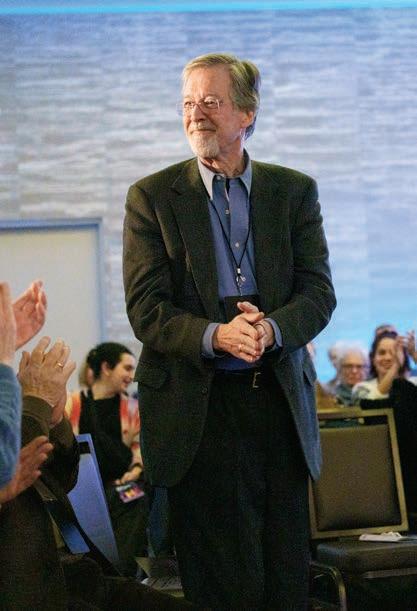
CLEVELAND QUARTET JUBILEE
Honoring the Cleveland Quartet, the legendary ensemble whose 26-year career made an indelible impact on the chamber music field. The quartet’s legacy lives on in part through CMA’s Cleveland Quartet Award, a biennial honor given to an outstanding young quartet. The jubilee featured performances by the Borromeo, Parker, and Verona string quartets.

Opposite
Paola Prestini;
Kwan Loucks and Dr. Maria Rosario Jackson; James Dunham; the Borromeo String Quartet; Michael Abels. This
(clockwise
Missy Mazzoli, Terri Lyne Carrington, Lara Pellegrinelli, Laura Colgate, LaFrae Sci, and Vanessa Reed at “Music Without Patriarchy” panel; Steve Nelson; April May Webb; Paul Katz; Peter Salaff and Martha Strongin Katz.
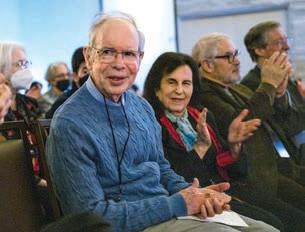




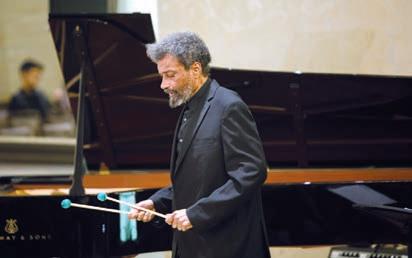
“I tend to think about systemic biases as being like a ball of intertwined thread. Everything is kind of locked together. So then you’re looking for a foothold: Is there a little end poking out of that ball of thread? What can I pull on to create change?”
— Journalist Lara Pellegrinelli, at the panel: “Music Without Patriarchy: Strategic Organizational Approaches to Gender Justice”
 page (clockwise from top left):
Kevin
page
from top):
page (clockwise from top left):
Kevin
page
from top):

“I love taking chances. I love trying new things. I love challenging myself. That’s what artists are supposed to do.”
Herbie Hancock, upon accepting his award


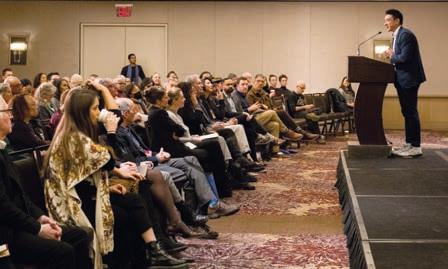
AWARDS
Richard J. Bogomolny National Service Award
Herbie Hancock
Presented by Terri Lyne Carrington
Michael Jaffee Visionary Award
JACK Quartet
Presented by Jeffrey Zeigler
Cleveland Quartet Award
Balourdet Quartet
Presented by James Dunham
NEW AWARDS BRING EXPANDED RECOGNITION TO THE FIELD
On Sunday, January 21, CMA CEO Kevin Kwan Loucks announced six new awards, honoring diverse achievements across disciplines and genres.
Ensemble of the Year
Celebrating an ensemble or ensemble project that has demonstrated exceptional artistry, musicality, and groundbreaking impact on the chamber music landscape.
Dalí Quartet
Presented by Melissa White
Commission/ New Work of the Year
Recognizing exceptional compositional talent, this award serves as a catalyst for the advancement of small-ensemble composition as a vibrant and evolving art form.
Kyle Rivera’s Anaglyph
Commissioned by the Cross-Country Chamber Consortium
Presented by Jenny Bilfield

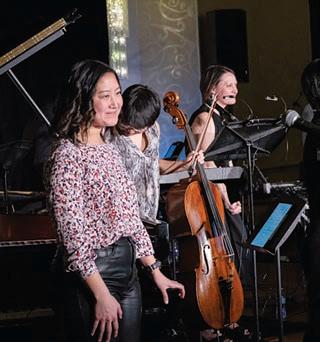
Interdisciplinary Collaboration of the Year
Recognizing extraordinary endeavors that bridge the gap between music and other art forms, including dance, theater, visual arts, film, and literature.
Rivers in Our Veins by Allison Miller
Presented by Samuel Torres
Album of the Year
Celebrating the best chamber music recording released in the last year.
Uncovered, Vol. 3: Coleridge-Taylor Perkinson, William Grant Still & George Walker
By Catalyst Quartet
Presented by Jennifer Grim
Community Impact/
Presenter of the Year
Recognizing an individual or organization that has made a profound and lasting contribution to their community through the presentation of chamber music performances, educational outreach initiatives, collaborations with local musicians and organizations, or audience development programs.
National Sawdust
Presented by Kevin Kwan Loucks
Arts Advocate of the Year
Highlighting exemplary leadership and a commitment to advancing the arts at the local, state, or national levels.
Afa Dworkin
Presented by Jennifer Grim
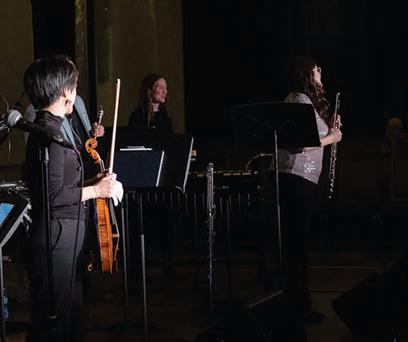




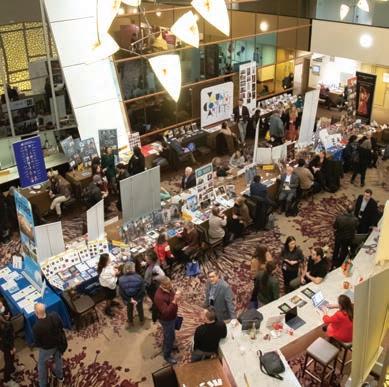
Opposite page (counterclockwise from top left): Jahari Stampley; Daniel Chong and Jessica Bodner of the Parker Quartet; Karlos Rodriguez and Karla Donehew-Perez, Catalyst Quartet; Kevin Kwan Loucks; Austin Wulliman and Christopher Otto of the JACK Quartet, with Jeffrey Zeigler. This page (top to bottom): Khemia Ensemble; Yeesun Kim; Kyle Rivera; Eunbi Kim; audience members; the Exhibit Hall.
THANK YOU TO OUR SPONSORS
Chamber Music America extends its sincere appreciation to the following organizations for their generous support.
GOLD SPONSOR

ADDITIONAL SPONSORS





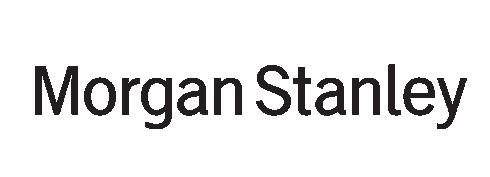


WITH SUPPORT FROM






New music activities are funded in part by: The Amphion Foundation, The Aaron Copland Fund for Music, and the Alice M. Ditson Fund of Columbia University.
Additional support is provided by CMA’s Ensemble of Friends.

Restaurant partners: Chai The Corner Chinese Hard Rock Café Havana Central Tito Murphy’s
25
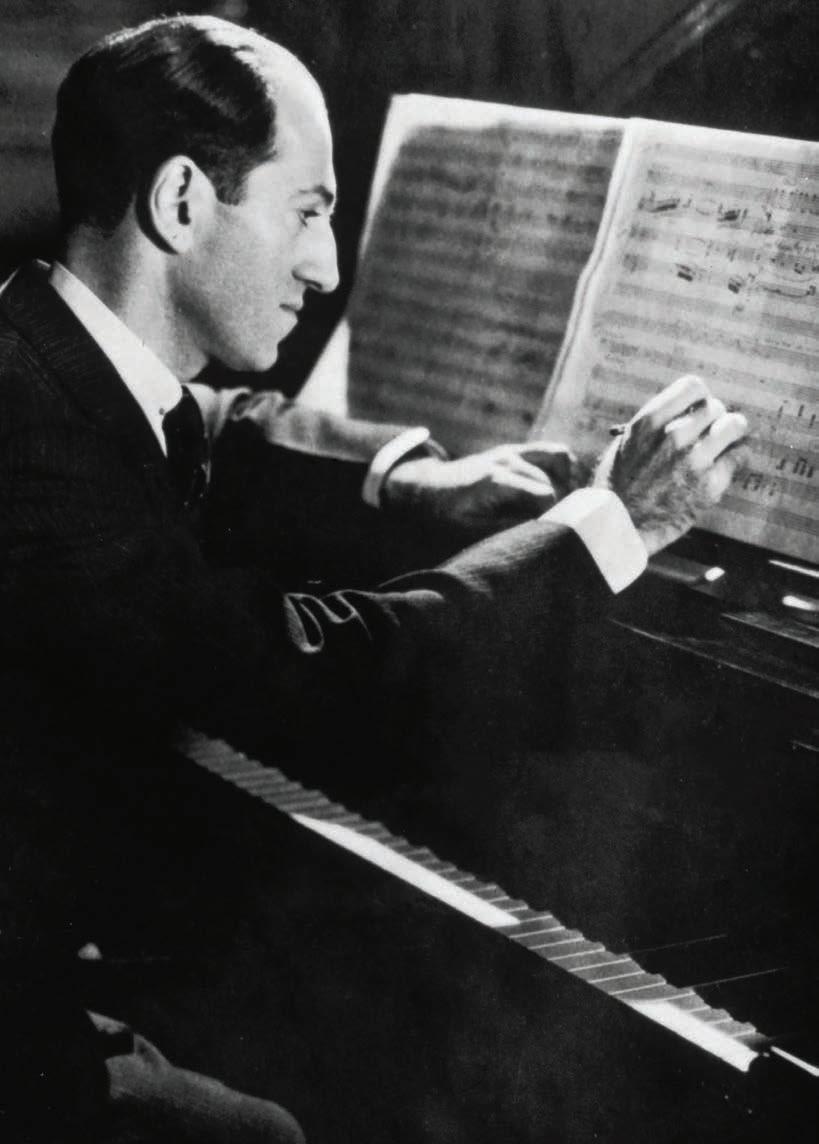

Rhapsody Finding My
How the celebrated pianist, radio presenter, and arts activist found a home in George Gershwin’s century-old classic.
BY Lara Downes
In February 1924 , George Gershwin’s “Rhapsody in Blue” was premiered during “An Experiment in Modern Music” at Manhattan’s Aeolian Hall. Bandleader Paul Whiteman had asked Gershwin to supply a “jazz concerto,” which the composer took as an invitation to capture what he called “a musical kaleidoscope of America, of our vast melting pot . . . ”
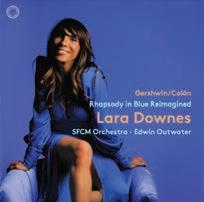
Among my first memories of “Rhapsody in Blue” is the Winter Olympics, in 1998, on TV—the long program of a Russian skater, Ilia Kulik. He won a gold medal skating to that music. I had only recently returned to the US from many years in Europe. My father, a biochemist who was born in Jamaica, died when I was nine, and my mother, an attorney of Russian Jewish descent, had moved our family to Paris when I was in my early teens.
Studying piano in Europe, everything was formal and structured and tradition-bound, which is all great. But I started to want to know what American music was about, partly because I had so little contact with it. I thought it would make sense for me, an American, to play something American. At one point, I asked my teacher about Gershwin, an idea that was firmly shot down.
I learned “Rhapsody in Blue” on my own, out of curiosity. It was my earliest experiment with a hybrid American sound. A few years later, I made an album called American Ballads, which represented baby steps toward my understanding of what American concert music was, and how that interfaced with other American traditions. I was playing music by Aaron Copland that was informed by folk sources, and by others, including Roy Harris and Samuel Barber. Around that time, I began playing “Rhapsody in Blue” in recitals, in its solo-piano version. I was just having fun with it. I loved it. It’s such a gratifying piece, pianistically, because there are a lot of different kinds of piano playing involved. There’s the beautiful lyrical stuff. There are highly rhythmic sections, especially when you’re playing the solo-piano version. And for me, there’s humor in it.
I was exploring Gershwin and American music in the context of myself—who was I, even? My childhood was so strange. My sisters and I were homeschooled, somewhat in a bubble, feeling
Acentury later , pianist Lara Downes released her re-imagination of Gershwin’s masterpiece. She commissioned a radical new arrangement by the Puerto Rican composer Edmar Colón that reverberates with the multicultural sounds of America in our time. This adventurous work had its world premiere in October 2023, featuring an ensemble of dynamic young musicians from the San Francisco Conservatory of Music Orchestra, and its Roots, Jazz and American Music programs, led by conductor Edwin Outwater.
in many ways like outsiders. We were these three biracial kids growing up in San Francisco, not going to school and immersed in music. Our childhood was far from any typical American upbringing. Once we moved to Europe, I felt at home in a musical sense, but I was still an outsider, an American abroad.
When I came back here in the mid-’90s, I was a young, brownskinned woman in America, having to sort that identity out. And I felt the weight of this European training on me. I remember an exhibition at the Whitney Museum called “The American Century.” It was a retrospective curated so that the artworks were surrounded with context—what was happening in politics and society and the other arts, specifically music. For the first time, I understood, Oh, this is what made this music. It was no longer just scholarly curiosity about American concert music. It was: What is American music, anyway, and where do I fit into it? Where did Gershwin fit into it?
The same year that “Rhapsody in Blue” had its premiere, 1924, my paternal grandfather, Leonard Downes, migrated from Jamaica to Harlem. He died when I was very young. Once you start sorting through your identity, you realize it’s not only about you. Just as I was making my first clumsy efforts to research and understand American music, I found an anthology—Black Women Composers: A Century of Piano Music (1893-1990)—that traced a century, and I discovered this one piece by Florence Price. I started playing it. The reaction of audiences to that music made me realize that this was about way more than my own self. I started wondering: Who made American music? Who does it belong to?
When I think about Gershwin now, I hear his music in the context of the great black composer William Grant Still—down the block from Gershwin, playing oboe in Eubie Blake’s Broadway pit orchestra for Shuffle Along, and then writing his own first symphony. I’m thinking about all of this creative energy being
27
Photos: Ebru Yildiz (Downes); Courtesy of The Library of Congress (Gershwin)
passed back and forth between Black and white musicians at the beginning of the 20th century, everything Gershwin absorbed that made it possible for him to create his music.
I’d been infusing my playing of “Rhapsody in Blue” with those ideas as I played it in recitals. Playing it solo, I didn’t try to make a big statement about any one thing. It just felt like a piece that moves among moods and styles, and I kind of just went with it. And then I had this idea to fully re-imagine this piece as it turned 100 years old—to explore it as a multi-dimensional, multi-directional illustration of cultural exchange.
In 2022, I did a concert with the Boston Pops, of Duke Ellington’s music. It opened with an arrangement that Edmar Colón did of “Caravan.” He took that piece back to its roots, and especially to the roots of its co-composer, Juan Tizol, who was Puerto Rican. Edmar’s version was respectful, loving, and it embraced what Ellington was trying to express through that collaboration. Edmar and I spent a lot of time in Boston talking about the roots of things and how strong they are.
When I thought about exploring and expanding the roots of Gershwin’s “Rhapsody,” I knew that Edmar would be my collaborator. I flew to Boston. We spent a day together poring over Gershwin’s original piano score. We talked about which parts have always felt great to me as a pianist, and which parts sometimes felt like they were trying to translate something into a notation that’s not quite translatable—like when you find a word in another language, and we don’t quite have that word in English. Because of Edmar’s background, he could translate those passages directly through percussion instruments and rhythms, straight from the traditions that inspired Gershwin.
Our conversations focused on stretching the piece in two directions—way back, to the roots of what Gershwin experienced in the 1920s, and what had preceded that; and forward into the present, embracing his vision of our melting pot—what Gershwin called “a musical kaleidoscope of America”—as it is today. We wanted to acknowledge the waves of immigration yet to come, and the layers of sounds that Gershwin never got to hear. What would he have done if he had heard the evolution of jazz? The sounds of so much immigration from Central and South America, from every corner of the globe really, during these last 100 years?
That calls for different instrumentation, especially percussion instruments such as conga and bongo. That’s our heritage, Edmar via Puerto Rico, and me via Jamaica. Our own family’s immigration stories were important there. Also, part of the idea from the beginning was that if this is going to be a piece of American music that moves around this country and is played for different audiences by different orchestras, it would need to change in each place. In any American city, people relate to music through local histories.
In San Francisco, where we premiered it, there is an important story of Chinese influence. So instruments like pipa and erhu became part of the story. Wherever it goes next—next stops, New York City and Dallas— will influence the ensemble and the sound.
What would Gershwin have done if he had heard the evolution of jazz? If he’d heard the sounds of so much immigration from Central and South America, from every corner of the globe really, during these last 100 years?
Last October, we rehearsed for three days, performed the world premiere of the piece, and then recorded it for its Pentatone release in February. It was an intensely emotional experience, and hard work. Everybody really had to stretch themselves. (There’s that word again, stretching.) And we really had to listen. Performing this piece I had played so many times, I opened my ears wider, to trust and have a new conversation. It was beautiful to sink into that, and to listen to what came from that.
My relationship to Gershwin begins before I started playing his music. Let’s go back to that figure skater, right? To hearing this really beautiful tune. Based on what I’ve learned about Gershwin’s environment as a first-generation American experiencing a moment of intense change, it’s also far more. When he called this piece “a musical kaleidoscope” reflecting our “vast melting pot,” he was making a case for us to communicate and listen. And now I think I hear another intention in a piece, a little bit of protest—a statement of independence and democracy. I don’t think I’m overstating that.
I think that we musicians live in the time we live in, and we respond consciously or unconsciously to those times. For Edmar and me to put together this project now celebrates not just Gershwin’s inspiration of a century ago, but also 100 years of immigration. Three months after the premiere of “Rhapsody in Blue,” the US passed an immigration act designed to “preserve the ideal of US homogeneity” and to prevent “”a stream of alien blood.” To come to this country has always demanded courage, a leap of faith, a willingness first to dream and then to work really hard in pursuit of that dream. We know the rhetoric around immigration today. Yet people keep coming because they still believe in this place. For us, this reimagined “Rhapsody” is a labor of love, our own statement of belief in this country, now and for the future.
Lara Downes is a sought-after piano soloist, a Billboard chart-topping recording artist, and a beloved NPR personality as host of her popular show Amplify with Lara Downes. Her most recent release is Rhapsody in Blue Reimagined (Pentatone).
28 SPRING 2024
For more information or to register mya.org/ chambermusicworkshop

MYAC PRIDES ITSELF ON OFFERING THE MOST COMPREHENSIVE AND PERSONALIZED SUMMER CHAMBER MUSIC PROGRAM
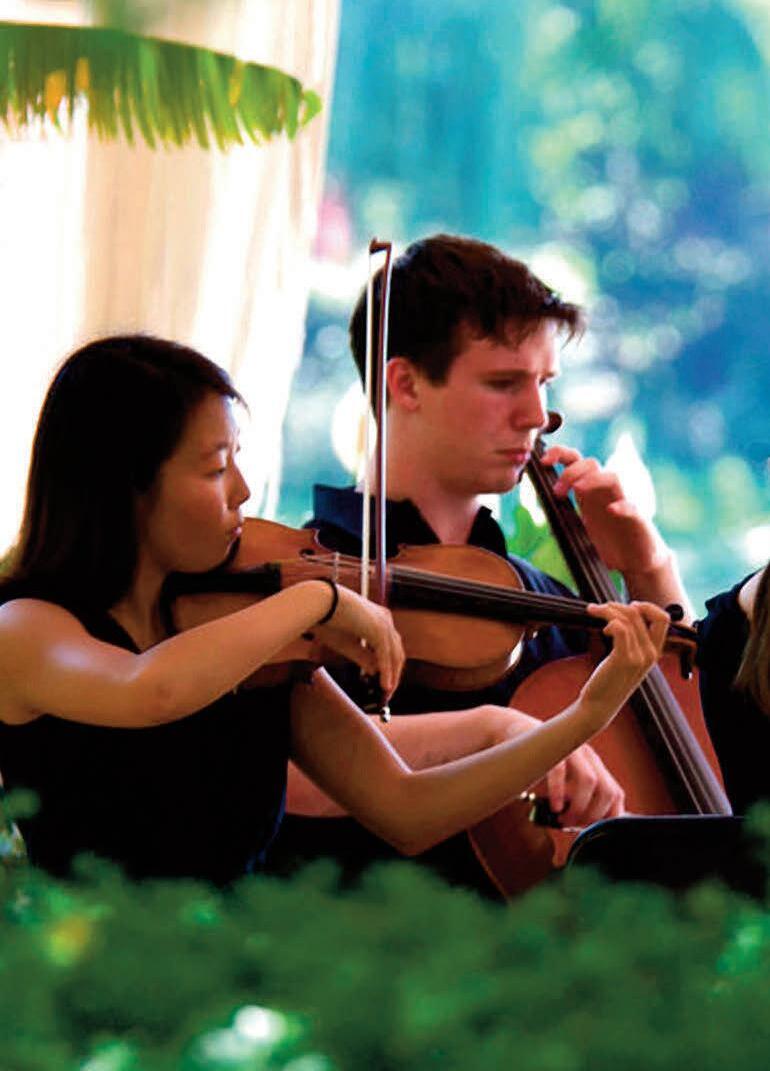
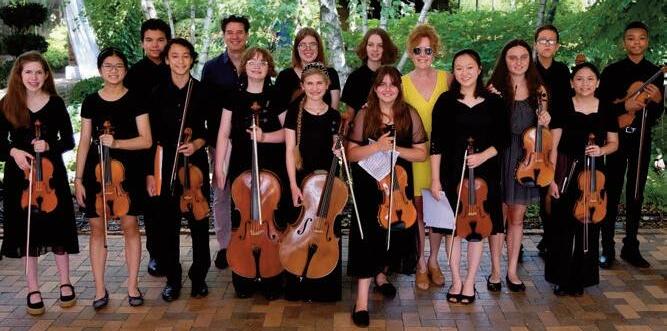
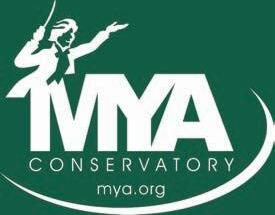


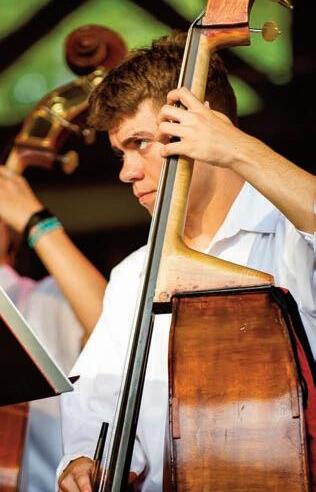
CHICAGO CHAMBER MUSIC
AT MYAC
MEMBERS OF CHICAGO CHAMBER MUSIC WORKSHOP FACULTY (not LImIted to):
1 - July 20
WORKSHOP
desiree Ruhstrat david Cunliffe Carrie dennis Paula Kosower Robert Bassill Allan dennis
July
CHICAGO CHAMBER MUSIC WORKSHOP AT MYAC SAVE THE DATE 2025 CHICAGO NATIONAL CHAMBER MUSIC COMPETITION Register at mya.org/audition or contact us at 847-926-9898 Audition Now! Be part of MYAC’s 2024-25Season! mya.org/ (847) 926-9898 / 878 Lyster Road, Highwood, IL 60040 FEBRUARY 16, 2025 Registration deadline: February 1, 2025 at 11:59 P M (CST)
WHEN CHRISTIAN
 Bassists Edgar Meyer (left) and Christian McBride (right)
Bassists Edgar Meyer (left) and Christian McBride (right)
MET EDGAR
(THANKS TO RAY)
Bassists Christian McBride and Edgar Meyer
discovered that their separate musical paths share a starting point. And, this far down each road, they finally got together in a studio.
BY Steve Smith
BACK WHEN THE BASSIST and composer Edgar Meyer was just a fledgling musician, at five years old, his father made an introduction that would impact his son’s life for years to come. “My dad put on a recording of the Oscar Peterson Trio, We Get Requests,” Meyer said. “And he said, this is how you play the bass.”
The bassist on the famous LP, issued on Verve in 1964, is Ray Brown, who played alongside drummer Ed Thigpen in pianist Peterson’s working band. Brown, born in Pittsburgh in 1926, was an iconic figure in jazz from 1946 until his death in 2002; he worked extensively with Peterson, singer Ella Fitzgerald, and vibraphonist Milt Jackson, and his musical associates ranged from Louis Armstrong and Duke Ellington to Aretha Franklin and Diana Krall. On Peterson’s 1964 LP, he makes his presence known from the very start, on
“Quiet Nights of Quiet Stars (Corcovado),” a bossa nova composed by Antonio Carlos Jobim that was widely played at the time by American musicians. Brown’s nimbly plucked high-register figurations supply the prodigious pianist with agile, elegant counterpoint. Elsewhere, Brown’s rocksteady time and mahogany tone provide a solid gravitational center to the trio’s airborne playing.
“He is the only bass player who I consider to be a significant influence, of all my elders,” Meyer said of Brown, speaking via Zoom from his Nashville home. In an adjacent Zoom cubicle—in reality, sitting in a New York City recording studio—Christian McBride nodded enthusiastically. He and Meyer have played together for more than a decade, a partnership they’ve only now documented with a duo album on the Mack Avenue label, the whimsically titled But Who’s Gonna Play the Melody? “I echo the exact same sentiment,” McBride said.
“The first time I saw Ray Brown perform live, it was such an epiphanous experience. I had never seen anybody play the bass with such joy and such ease, and get the kind of beautiful, voluptuous woody sound he got out of that instrument.”
Today, McBride and Meyer are among the elite practitioners on the double bass. Each is associated with a disparate stylistic range: Meyer, 63, from classical music to bluegrass, McBride, 51, from mainstream jazz to funk and hip-hop. But as their album indicates, they’ve got plenty in common, including being spiritual heirs of Brown, a widely recognized, charismatic jazz hero whose influence extends well beyond his sonic presence.
“It just seemed so effortless for him,” McBride said. “He was communicating verbally with the band, and just kind of looking around like he was bouncing a basketball or something . . . he just had so much fun.”
“Also, dude had a lot of brains,” Meyer
31
Photo: Anna Webber
CHRISTIAN
“The first time you hear Christian, things have changed. You pay attention to everything from that point on.”
added. “He was somebody who played piano first, and had a creativity in what he chose to play that was not ever matched.”
IN A WAY, BROWN WAS RESPONSIBLE for introducing these two musicians to each other. “Ray told me about Edgar back in 1991, when I was starting to get to know Ray,” McBride said. Brown had just taped an episode of The Lonesome Pine Specials, a public television series co-produced by the Kentucky Center for the Performing Arts and Kentucky Educational Television, based on a concert series that ran from 1984 to 2000. Programming for the Lonesome Pine concerts and broadcasts adopted a wide-ranging view of American roots music, hosting singer-songwriters such as Emmylou Harris and Lyle Lovett, as well as clarinetist Richard Stoltzman, fiddler Mark O’Connor, the Turtle Island String Quartet, and—in their first-ever performance—banjoist Béla Fleck and the Flecktones. Brown appeared in a 1991 episode, playing alongside Meyer and electric bassist Victor Wooten.
“Ray showed me a video of the three of them, and that was how I was introduced to the genius of Edgar Meyer,” McBride said. He set out to find more. He tracked down Work in Progress, an intimate duo session Meyer recorded with pianist Amy Dorfman, which was the last in a series of influential, genreblending LPs Meyer recorded for MCA during the late ’80s and early ’90s with collaborators like Fleck, O’Connor, mandolinist Sam Bush, and dobro and lap steel guitarist Jerry Douglas.
“The first time you hear Christian, things have changed,” Meyer said of McBride. “You pay attention to everything from that point on.” He cited in particular McBride’s first two albums, Gettin’ to It (1995) and Number Two Express (1996),
both on Verve. “Both of those just completely changed my idea of what was happening on the bass. From that point on, I was extremely aware of Christian.”
“May I say, Edgar, congratulations on your recent wave of Grammy wins,” McBride interrupted. Meyer won two Grammys this year for As We Speak, his 2023 collaboration with Fleck, tabla master Zakir Hussain, and bansuri player Rakesh Chaurasia, bringing his lifetime total to seven.
“Well, it just keeps me a little closer to your big, outstanding heap,” Meyer replied, deadpan. McBride earned his eighth Grammy in 2022 for a big-band album, For Jimmy, Wes and Oliver.
The two bassists first crossed paths in person in 2000, at one of Wooten’s instrumental camps. McBride specifically recalled a performance of “Impressions,” a John Coltrane composition. “There was a lot going on,” he said, laughing. “There were a lot of people onstage jamming. There was a little keyboard on the side, and I was playing keyboard and bass. And when Edgar started soloing, the fact that he attempted the solo with all that mess going on… it made me love him even more. I said, man, this dude is not only a genius, but he’s fearless.”
McBride and Meyer first played as a duo in a one-off performance at the Aspen Music Festival and School in 2007, then toured together in 2016. “We decided we wanted to do a record while we were on that tour,” Meyer said. “We got about half of one done, and then there was a pandemic.”
concert works involving two double basses, by iconoclastic composers like C.P.E. Bach, Giovanni Bottesini, Frank Proto, and Árni Egilsson. Numerous jazz albums feature two bassists, including classics like Free Jazz by Ornette Coleman, Unit Structures by Cecil Taylor, and Levels and Degrees of Light by Muhal Richard Abrams. There are fewer instances of bass duos, though the German improviser Peter Kowald made albums with fellow bassists Barre Phillips, Maarten Altena, Barry Guy, and Damon Smith.
No one needed to show McBride and Meyer what was possible. “The first time Christian and I played a couple of notes together, you know you’re being listened to like you’ve never been listened to,” Meyer said. “And when you feel that connect, that’s a musical connect, not a bass connect. You’re dealing with somebody who’s a big-time communicator. I’ve never heard a moment where Christian wasn’t exactly the right volume.”
Even if there had been a blueprint for two basses playing together, McBride added, it’s unlikely he and Meyer would have followed it. “One of the beautiful things about working with Edgar is that we find some uncharted territory,” he said. “We come from two different places, and it’s much more interesting if we create something on our own that hasn’t been done before.”
THERE WEREN’T
A LOT OF PRECEDENTS
on which Meyer and McBride could model their two-bass hit (each musician also plays piano on a couple of tracks on the new release). There’s a scattering of
McBride means two different places, musically and geographically. On the new release, “Barnyard Disturbance” is a playfully folksy Meyer composition that suggests his roots in Oak Ridge, Tenn., with the bassists trading lead and supporting roles seamlessly; another, “Philly Slop,” honors McBride’s birthplace with a breezy tandem melody. The album features these and other original compositions from both players, alongside standards like “Bewitched, Bothered and Bewildered” and “Days of Wine and Roses.”
32 SPRING 2024
∂
∂
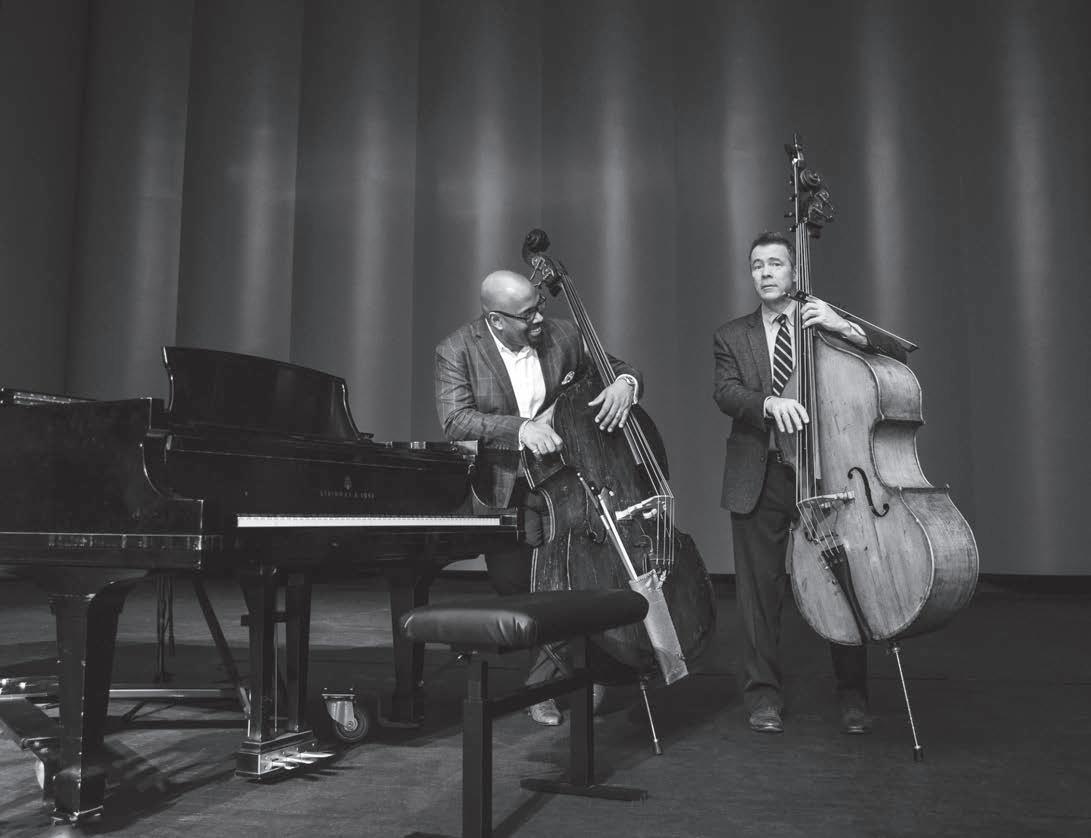
“One of the beautiful things about working with Edgar is that we find some uncharted territory. We come from two different places, and it’s much more interesting if we create something on our own that hasn’t been done before.”
Finding material wasn’t a problem. “If you go back to our first performance in Aspen in 2007, and you add up all the music we’ve played since then, it’s a lot. I can’t even begin to think of how much written material there’s been—original material, existing material, bluegrass, jazz standards,” McBride said. “Just like any other new band trying to find their footing, you know, you just try it all out and see what sticks.”
“I think the fear, when you start off with two basses, is not just ‘Who’s gonna play the melody?’ like the title asks, but ‘Is it all going to sound the same?’” Meyer said. “So a real priority was getting a range of music. At the same time, because it’s two basses, we actually in some cases played more simply than we might in another setting. That’s not something we talked about; we both just did it. I think it was just common sense, you know, got
to make some room.” Looking ahead, Meyer wants to publish scores for the music he and McBride composed for the album, so that other bass duos can pick up where these two left off.
The two bassists celebrated their album release in March with a duo set at the stylistically omnivorous Big Ears Festival in Knoxville, Tenn. The further road, at last, awaits. “It might be a year off or something, but I think we’ll just knock out a period and we’ll go spend some time,” Meyer said.
“That’s right,” said McBride. “It’s somewhere between hope and planning . . . leaning toward planning.”
Steve Smith is a journalist, critic, and editor based in New York City. He has written about music for The New York Times and The New Yorker, and served as an editor for The Boston Globe, Time Out New York, and NPR.
33
Photo: Anna Webber

Ted Hearne & Matana Roberts
The composer-performers talk about changing landscapes—for their art forms, their communities, and in terms of the literal lands we inhabit.
BY Peter Margasak
Although Ted Hearne and Matana Roberts are both Chicago natives, the two composer-performers seem miles apart in terms of their musical upbringings. Hearne started out on a classical music track, eventually joining the precocious composer collective Sleeping Giant. Roberts, a saxophonist steeped in jazz history, emerged on the city’s thriving improvised music in the 1990s in the trio Sticks & Stones. Later, Roberts embarked on one of the most ambitious long-term musical endeavors of our time, a twelve-chapter opus rooted in African-American history and genealogy, titled Coin Coin
Both musicians are omnivorous listeners who routinely flout the expectations and rules of their dominant fields. As the boundaries between musical words have grown more porous, and the distinctions between these worlds ever less meaningful, Hearne and Roberts have remained at the leading edge of that transformation. Hearne’s musical theater pieces have freely collided electronic music, hip-hop, and political commentary within ensembles that ignore genre identification. Roberts’s sound-quilting strategies extend even beyond the breadth of African-American music to draw upon noise-rock, opera, British folk, and anything else that fits into their elaborate constructions.
Hearne and Roberts recently spoke over Zoom—Hearne, dialing in from Berlin where he was mounting a new piece called over and over vorbei nicht vorbei at the Komische Oper Berlin; and Roberts in New York City, wrapping up a visit to perform at the annual Winter JazzFest before heading back to San Diego, where they are serving as an assistant professor at the University of California this year.
community . . . ” but now it just sounds like, “Grind, you just got to grind,” and that can be really toxic for people.
MR: During the worst of the pandemic, I felt the privilege of art life even though everything disappeared. I had a schedule that was so insane that I remember I looked at it, at the start of that year, going, “I don’t know how I’m gonna do all this.” And when things started getting canceled, I was like, “Oh, great, now I have more time to work on this.” I had a very nice situation that allowed me to just stay pretty isolated, but to also rethink the grind—like, what does it mean? And how not good it is for creativity. Creativity needs rest. Creativity needs times of doing absolutely nothing so that ideas can pop up. Creativity needs time for you to focus on other people, other things in your life, and also to reassess how you’re taking care of yourself to push through to this next level.
Matana Roberts: I just want to know: How are you doing? There have been some really wild shifts in music lately. There’s a real gutting of the cultural sector across global lines right now. I’m noticing that when people come to me for advice for certain things, some of the advice that I would have given them before the worst of the pandemic is not applicable. Opportunities are scarcer, it feels, though I also feel like people are noticing that, and trying to create new opportunities to make up the difference. A lot of people have left the cultural sector to do other things; mass layoffs and things that are happening in music media, for instance, are terrifying. And so I wonder how you’re operating with that information these days?
Ted Hearne: It’s interesting that you frame it in terms of the advice that you give. That’s a big point, where I really feel
that impact, too. I was never so grateful to have some affiliation with institutions and stability when the pandemic hit. The reset made me look at how much support the cultural sector has. How much is someone who has ambition and drive willing to work at building community? How much opportunity do they really have to make it work for themselves and for the community?
I started thinking that when I was in my early 20s, there were more opportunities for people to be able to do that, and now it just seems a lot harder. I think I was set on this capitalist track of just going and going and going, and just hustling and hustling. The pandemic provided a moment to sit back, and both assess the privilege of the position that I was in, and also how difficult it is. And the advice for the students is different. I used to always just be like, “Move to New York . . .
I still feel this kind of guilt of privilege, versus friends who are frontline workers, or friends in the medical field, or friends whose gigs disappeared. Then I had a moment of, Okay, this is it. Taking stock of how my life has been, being kind of happy about what I’ve gotten to do, and thinking, Okay, this is how I’m going out From the headlines, it seemed like the African-American community was even more heavily affected, just the numbers of people dying in the communities that I’ve been a part of throughout my life. I have a pre-existing asthmatic situation. I just thought like that for a good three weeks.
“I’m trying to weave a quilt of friendship and admiration. I’m interested in possibility, and what’s not standard.”
– Matana Roberts
35
Photos: Stefan Cohen (Hearne); Anna Niedermeier (Roberts)
Duos
“I always say that all music is political. I feel like some artists themselves, or some institutions that present artists, will explicitly disavow that, and that is a political act, also.”
Finally, I was like, “Oh, I can work on that piece that I’ve never had a chance to work on, because I don’t have time. Or I can do some other creative things that I really would like to take a stab at that I don’t have time for. How am I really feeling, emotionally? What really is going on? And who can I check in on?” Thank God for the internet.
TH: Do you think that experience—that shift, maybe that time, the space away from the schedule—do you think that there are concrete ways or nameable ways all of that affected your compositional process?
MR: I got into trying to have a deeper understanding of how sound affects the physical body. Because I was so freaked out, I was spending a lot of time in these soloistic practices with sound and instruments. I work with electronics, which I really love, especially as part of the studio practice. But I started having a desire to work with instruments that only took human propulsion to create, outside of the saxophone. The saxophone is a machine. It’s a simple machine, but it is a machine. I wanted to work with more simple machines, more wind vessels. Oddly, I had never understood how fun the percussion floors at most music stores are. I’m also a composer, and I like to have some tactile understanding of writing for certain instruments: Bells, kalimbas, triangles, gongs. And then all the different flutes, so many simple reeded things. I just dug deeper into possibility and into understanding that slow is fine, instead of this boom, boom, boom, which is how we move. That’s how I was moving. I started to feel that the work I was making was not only being made too fast, but it was also sounding too fast.
TH: Forgive me, this is going to be really broad, and I don’t know how to frame it exactly, but when you’re talking about
– Ted Hearne
wanting more wind vessels and feeling this connection to this type of instrument and wanting to explore that, this is something that I’ve thought about with your music. How much does the process of how the sound is made, and how much does the culture around whatever the instrument is, and whatever music is associated with that instrument—how much do those things play into the music that you write? And how much do you think you hear them in the music you produce when you write for those instruments?
MR: The one project that I have, the Coin Coin stuff—I’m really trying to pull in specific people who I want to include, so that when that project is all said and done, I want it to represent this really diverse community of interesting folks. There are tons of interesting folks all over the place, but people who have made a real impact on me off the bandstand, as well as on the bandstand. Sometimes people will ask who are some of these people Matana is asking to play this music. I’m trying to weave a quilt of friendship and admiration. I’m interested in possibility, and what’s not standard. I don’t really like writing for standard instrumentation. I’m interested in the possibility of really diverse sound worlds. But also, Ted, I still don’t know what I’m doing.
TH: That’s good!
MR: I’ve got two degrees in this stuff. I think you start to understand certain formulas or workflows that work for you. But I still feel that music to me—music composition, music performance, the art world stuff that I do—it still feels like a mystery, which scares me a little bit, but it also keeps it fun.
TH: If I was a different personality, if I learned how to write for an ensemble, like a string quartet or something, I would amass the knowledge about that and do
that because I got good at it. But that’s so boring to me. It’s nice to learn how to do a thing, but then it’s time to learn the next thing.
MR: I’m having dreams of writing for mono-ensembles of just one instrument so I can get to know the instrument a little bit. I took one composition class in college and that professor told me, “This is not going to work out for you, so we need to find you something else.” Sometimes when things are bad, I hear my head going, “Oh, this is probably what he was talking about.” I’m more interested in figuring out ways to strategize composition, conceptually. I’ve had some real failures with that. There are limits even in the biggest possibilities, and I’ve started to catalog what actually works, especially when dealing with graphic notation.
TH: I feel like that’s a good place to be. I love the idea of writing for the people who have made an impact on you. I feel exactly the same way, and I think it’s really important to do that, and also to write for people who could be that person, based on the music that they’ve made, and the way that we interact off the bandstand, as you say. I may not know you, but I will know you through this process. Also, the differences of people that are embedded in the ensemble. For me, that’s a really important value. Everyone’s learning from each other, and everyone makes music differently. When we start to have this shared experience that gets narrower or narrower, we start self-segregating, which I really hate, writing music that perpetuates that.
In Coin Coin, in these different albums, there’s an amazing overlay of different instruments and different patterns, different stylistic approaches. The tendrils of those things are connected to all these different people, and not just the people that are making the music. Of course, you
36 SPRING 2024

want someone who can communicate those things authentically—and those are the musicians that you’ve employed— the layers of culture. This is a huge part of why your music is really meaningful to me, because there’s this really alive respect for these different layers. You’re not saying, “The Matana approach is this clean box, and I’m gonna portray culture this way,” but you’re allowing this freedom of the layers. I hear the layers, and it feels really transportive. I’m wondering how you think about representing a culture in a sound, or if you think about that at all. Or does it just come from the person?
MR: I feel like I have a responsibility to speak in a certain way about some of these cultural hallmarks that are very
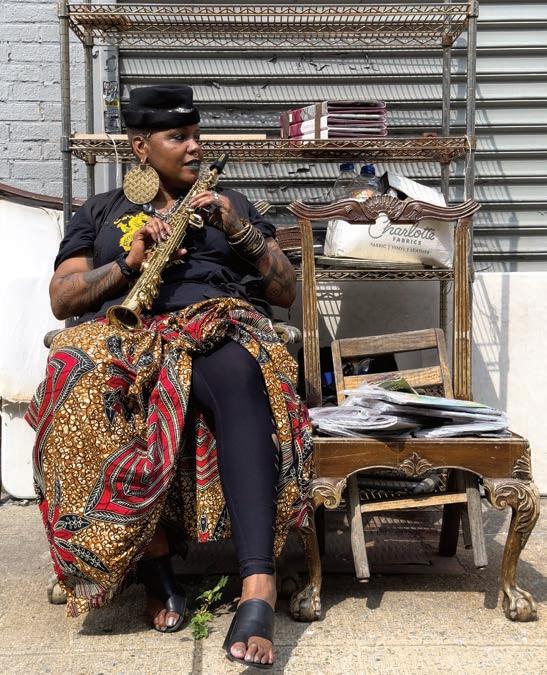
“I used to make these jokes about what it would be like if Congress sang together. Think about that— if there was like a choir requirement, how might things be different?”
present in the music, but I’ve also tried to create a pathway for myself where I’m trying not to be overly dependent on those hallmarks. In the Coin Coin work, I’m exploring lineage—a lineage that’s pretty wide across the spectrum—but because the front-facing focus is folks of color, sometimes I feel like people have wanted to collapse it down to that. I ruffle at that because that’s a jumping-off point, and that’s where I find a deep well of
– Matana Roberts
inspiration, but it’s not all I’m trying to talk about.
The Coin Coin work is a monument to the human experience to me, and that transcends all these other things. Like you—and in some of my other work, also—I’m trying to make some very clear statements about culture, about political points of view, about, again, the human experience, because music is about connection. And music is supposed to be
37
Photos: Jen Rosenstein (Hearne); Geoff Albores (Roberts)
Duos ■
about community, I thought. With the Coin Coin work, I wanted to be as honest as possible, so that it didn’t seem like I was trying to write for this kind of instrumentation just because it’s marketable, or it’s catchy, or it’s so unusual. I’m hoping that it’s created more room for other people trying to explore political ideologies in their work. All music is social justice work, all art is social justice work. I don’t care if a person’s drawing flowers or writing about the songs of coyotes or whatever; it’s all social justice work. That’s something I think about, but it reminds me to ask you how you think about instrumentation, because you’re always writing for something really unusual and interesting. I look at some of the stuff and I go, How did he have that idea? Like the piece about farming? Where do those ideas come from for you?
TH: Oh, yeah, the farm piece [Hearne’s choral work, Farming, which had its premiere at Art at Kings Oaks, in Bucks County, PA, last year]… I mean, ideas come from people, right? The people that I want to work with, but the potential power of adjacencies that really spark. I always say that all music is political. I feel like some artists themselves, or some institutions that present artists, will explicitly disavow that, and that is a political act, also. Their work is political whether or not they say it, and that’s sort of my tag. I love the way that you’re saying that all art is social justice work. It strikes me as another side of the coin, but a more generous side. I think of musical communities as reflections of the world as I see it, the communities in the world. Putting things together that you might not see together is another version of what you said, like writing toward the world you want to see. And I want to see the conflict of different viewpoints—not in a bad way, but because
“It’s nice to learn how to do a thing, but then it’s time to learn the next thing.”
I think that conflict is necessary.
Donald [Nally, who directs the newmusic choir The Crossing, which commissioned Farming] grew up on farmland in Pennsylvania, and he asked me to write a piece that they could do outside. He didn’t give me very much to go on, because I think he knew that I would take it somewhere, but I think that he was feeling some sadness about the way that the land has changed, and how difficult it is to get real food anymore. The transformation of so much farmland in that area to suburban sprawl and stuff like that.
There’s a type of piece that can make that point without bringing up the idea of our responsibility toward that condition, that feeds into agrarian nostalgia—this American idea of the old days, the farmland, blah, blah, blah. With choral music, especially, if we don’t lay it on a foundation of some difference, or lay it up against something else that’s a different viewpoint, then we can forget about it. That’s because of the impact of colonialism, the way that the land has been treated in the United States. And what is the conception of the land around that? We could just say we’re missing our beautiful fields. If we’re going to be on the land, this has to be electronic music, and we have to really show our imposition on the land. We’re not going to be like, Look at the sunset! We’ve got to be like, Look at the sunset against some hyperpop played on giant speakers, because we’re gonna feel that.
MR: I’ve been talking to a couple of musicians who all have been trying to get a hold of land, to try and have a different sort of connection, like a reminder of how disconnected we, as communities, have become from where our food comes from, where we live, how we live, and what we live on. There’s some land in my family that was given in a will and then taken back in a secret will that showed
– Ted Hearne
up, and nobody knows where it came from, back in the ’40s. It’s a wild story— this handwritten will—that completely changed the number of acres that were left to some people, and I have this fantasy of bringing that land back in, and then understanding my own disconnection. I thought it was really interesting that you were dealing with those issues. With the rise of these gentrifying forces happening all over the place, it’s really hard to give any sort of direction to people, let alone to ourselves, about how to best move about all these changes.
TH: Conflict is an interesting thing at work. I’m a person who navigates toward it, and that’s where I grow the most, when someone asks me to confront things that I hadn’t thought about well enough, or that I might be wrong about. I think it’s also a reaction to some classical music patterns. My mom was an opera singer, and the chasing of some ideal of perfection—this is the way that things are supposed to be done—there’s, like, a reaction to that. I feel like when we’re moving toward that in music, it’s not that generative, actually. It certainly doesn’t move toward the kind of conversation that’s necessary to really listen. I think that we should be listening more.
MR: Yeah, I can’t believe how undervalued listening is. I’m laughing to stop from crying because there’s a lot of other things we could talk about in that regard. I used to make these jokes about what it would be like if Congress sang together. Think about that—if there was like a choir requirement, how might things be different?
TH: From your lips to God’s ears! Seriously, that’s a good idea.
Peter Margasak is a Berlin-based music journalist who spent more than two decades as a staff writer at the Chicago Reader. He’s currently at work on a book about the intersection of jazz, experimental, and rock music in Chicago between 1992-2002.
38 SPRING 2024
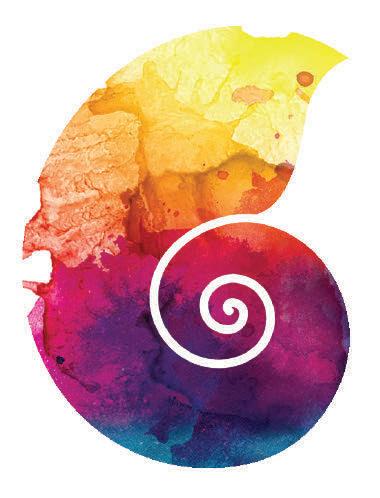


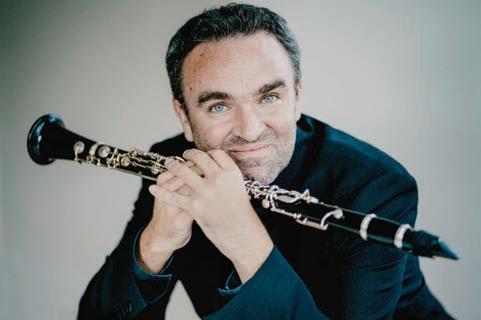


60+ concerts & events
well-loved classics & music of today


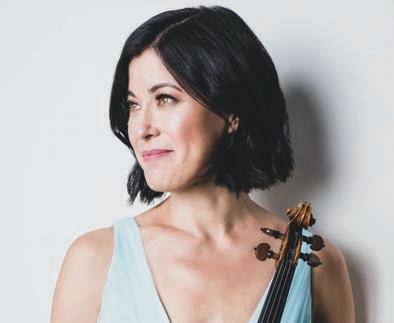

70+ of the most dynamic performers in the world
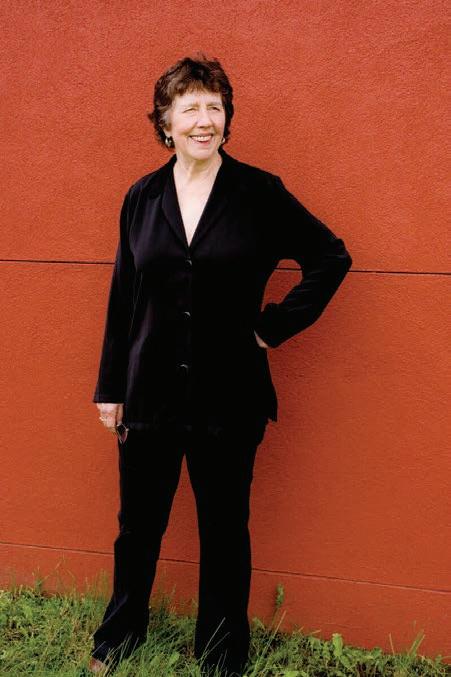
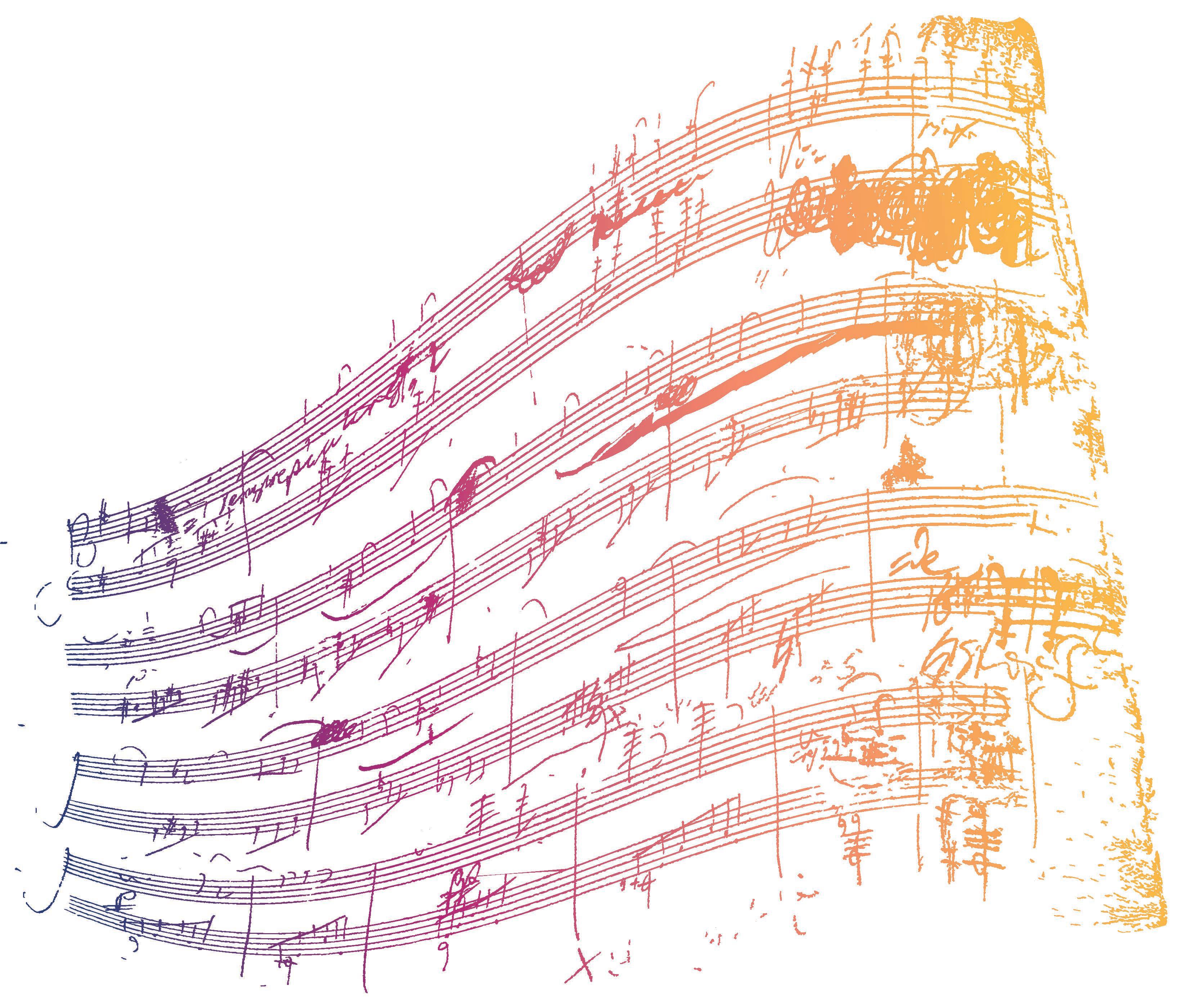 Sandbox Percussion
Joan Tower
Jennifer Frautschi
Jörg Widmann
Sandbox Percussion
Joan Tower
Jennifer Frautschi
Jörg Widmann
Portland, Oregon | cmnw.org | 503.294.6400
Alessio Bax
Bella Hristova
Stewart Goodyear
Gloria Chien & Soovin Kim Artistic Directors
Radovan Vlatković
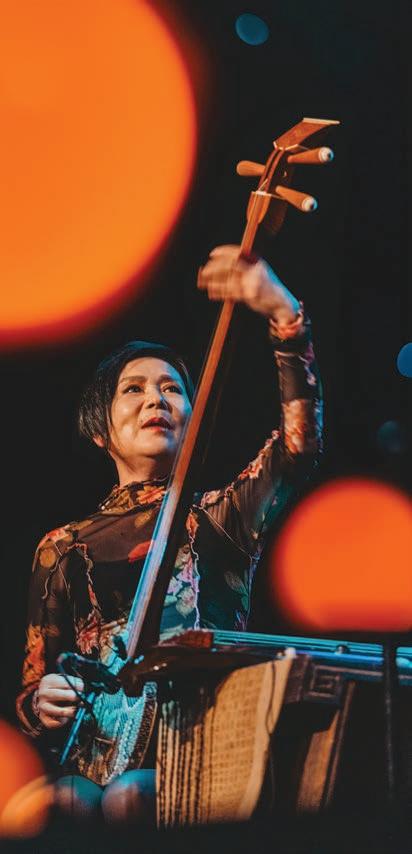

Large Listening
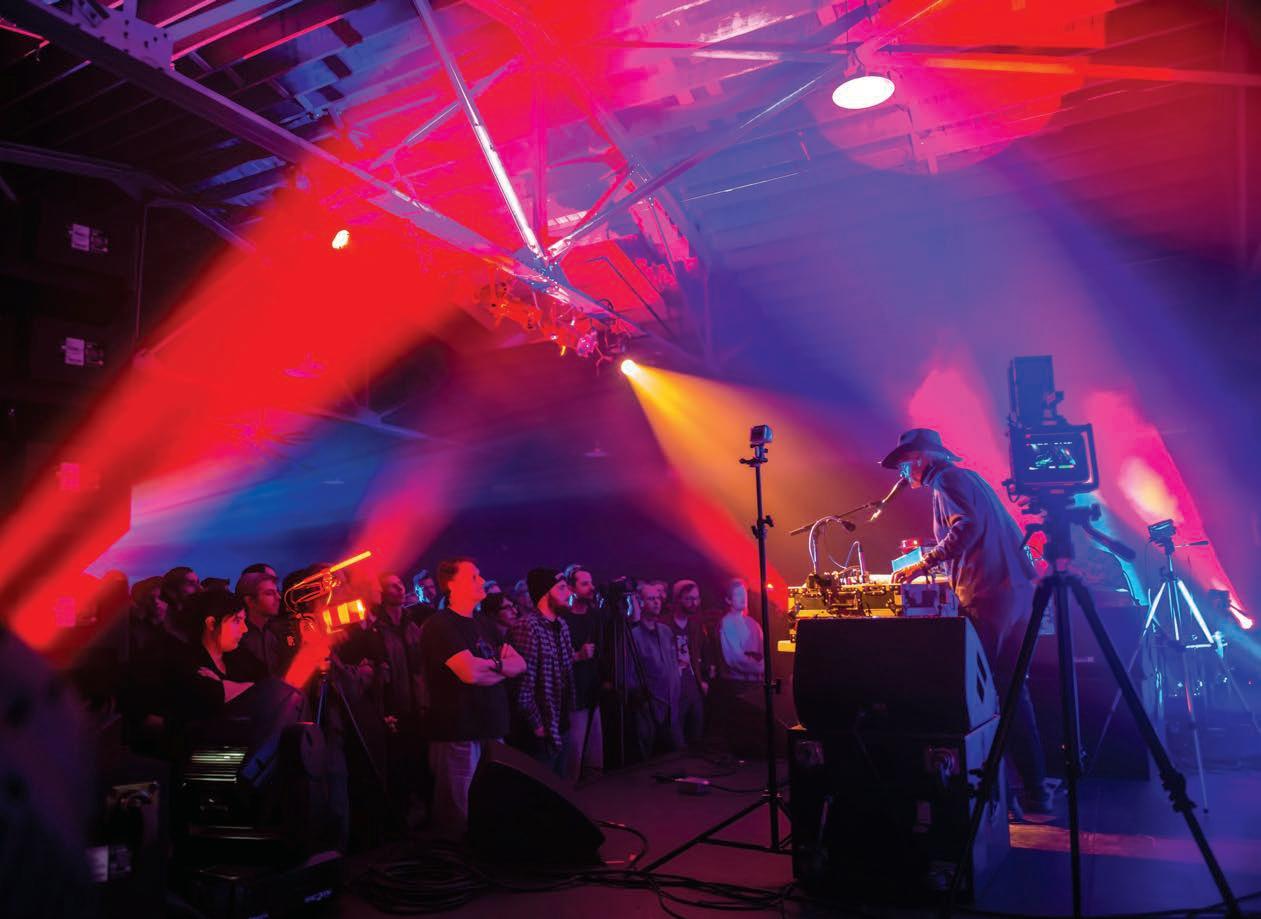 Clockwise from top left: Min Xiao-Fen at Big Ears, 2024; Henry Threadgill, 2024; the electronic rock group Silver Apples, 2015.
Clockwise from top left: Min Xiao-Fen at Big Ears, 2024; Henry Threadgill, 2024; the electronic rock group Silver Apples, 2015.
The spirit of our festival is to create an environment where people can flow freely into these different worlds, feel completely at home, and just discover what they might discover.
How Ashley Capps fell in love with all sorts of music, and found a way to present its full range through his Big Ears Festival.
BY Larry Blumenfeld
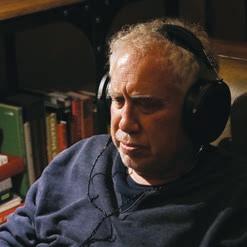
ON A SATURDAY AFTERNOON at the Old City Performing Arts Center, a former ice factory in Knoxville, Tenn., David Virelles coaxed thundering low-end crashes, dizzying single-note runs, gently hypnotic patterns, and gleaming overtones from a grand piano. His solo-piano performance was one among 50 on the third day of the annual Big Ears Festival, a sprawling four-day event that showcases cutting-edge improvisation, forwardleaning jazz, contemporary classical music, and more, while pledging allegiance to no single style or scene.
Five hours later, a few blocks away at The Standard, a converted warehouse, Virelles would perform again, in a reconstituted version of Make a Move, Henry Threadgill’s band of the late 1990s. Wrapped within the 2024 edition of Big Ears was something like a Threadgill festival, featuring five different ensembles that traced the saxophonist, flutist, and Pulitzer Prize-winning composer’s music through six decades.
Virelles came to New York City 15 years ago from his native Cuba, via Canada, specifically to study with Threadgill. Now Threadgill sat smiling, nodding, occasionally chuckling at Virelles’s mastery and ingenuity. When the music stopped, after the applause, he turned to me: “In this country, there’s nothing else
quite like this,” he said. “A festival that puts my music and his music together with string quartets and rappers and doesn’t favor one thing over the other, where people take artist talks and films seriously. We need this.”
As I headed up and down and back again on Gay Street, through the heart of Knoxville’s revived downtown, I popped in and out of more than a dozen venues, especially two lovingly restored ones— the cavernous, ornate Tennessee Theatre and the more intimately scaled but no less stately Bijou Theatre. Guitarist Fred Frith’s extended improvisations arrived like slowly revealed secrets. Pianist Jon Batiste’s bombastic pop was nonetheless flecked with thoughtful and virtuosic moments. Not one, but two, shows focused on the shakuhachi and other traditional flutes (performed by Shabaka, and by André 3000). I moved from the tenderness of saxophonist Charles Lloyd’s quartet to the force of guitarist Brandon Ross’s Phantom Station, from the emotional heft of violinist-composer Laurie Anderson’s “Let X=X” (with the band, Sexmob) to the relaxed charm of pianist Evan Lurie’s Quintet with Bandoneon. Threadgill was right; I needed all this.
Big Ears traces another nearly six-decade history, defined by the passions and inclinations of its founder, Ashley Capps, who began hosting a free-form music show on WUOT-FM, the University of Tennessee’s public-radio station, in 1979. Capps fell into music presentation almost accidentally. He rented a small church and sold 200 tickets for a concert by cellist Tristan Honsinger. Soon, he had his own club, Ella Guru’s, which presented New Orleans R&B heroes the Neville Brothers on its opening night in 1988, the alt-rock group Goo Goo Dolls just before shutting down two years later, and, in between, artists including jazz trumpeter Wynton Marsalis, country-music star Garth Brooks, and Nigerian juju music master King Sunny Adé. The company he formed in 1991 (and sold in 2020), AC Entertainment, co-founded the popular Bonnaroo Music & Arts Festival, whose financial success and somewhat free-wheeling booking policy helped inspire his launch, in 2009, of Big Ears. That first year, the two-dozen artists Big Ears presented included composer-performers Philip Glass and Pauline Oliveros, trumpeter Jon Hassell, and the avant-garde jazz trio, The Necks.
As he prepared for the 2024 edition, hosting more than 100 performers, Capps spoke to me about the arc of his musical awareness and his festival.
Have some people told you that Knoxville, Tenn. is an unlikely—maybe even crazy—place for an event like Big Ears?
Yes. I tell them that Knoxville is our secret weapon. It’s a nice town to visit, a great place to hang. It’s maintained its historic character
41
Photos: Cora Wagoner (Min Xiao-Fen, Threadgill); Bill Foster (Silver Apples); Courtesy of Big Ears (Capps)
Large
Most people were just trying to do the same festival over and over again. I started to wonder: What else can we do that’s even more creative?
and its downtown. It has fine restaurants and quite a few hotels. Most importantly, it has two historic theaters that are a block-anda-half from each other. That’s almost unheard of, certainly in the South. Everybody can walk to all of the shows. This allows us to create the feeling of shared experience that is so important to a festival while still presenting in an urban setting. And the fact that it’s in an unexpected location allows us to have a visibility and a profile that would be hard to achieve in a major city, where there are so many cultural events going on all the time. I mean, you can basically go out in New York City and have your own Big Ears every weekend. But it wouldn’t be the same thing.
Are you a Knoxville native?
Born and raised in Knoxville, in a suburb that actually had a different name, Fountain City, when I was growing up. But it’s now firmly annexed into Knoxville, and has been for decades.
What was the music scene you grew up with?
When I was really young, my music scene was the elementary school band. I started out playing clarinet, and then I switched to saxophone. My father had been a drummer—not really a professional, but he had played gigs around town when he was younger. My mother had studied piano. They were both music fans. I could raid my father’s record collection and find Ray Charles’s country-and-western record or Miles Davis’s Kind of Blue and Sketches of Spain. Lee Konitz’s Motion, with [drummer] Elvin Jones and [bassist] Sonny Dallas, is one of the records I still have from those days.
I was just that kid, always into music. My older cousin took me to see James Brown when I was seven years old. My dad took me to see Duke Ellington’s orchestra at the Civic Coliseum when they came to town with Johnny Hodges. Living in Knoxville, music became a way of exploring the wider world. Music was almost like a kind of magic, and the musicians were like magicians.
Did your radio represent the first public expression of your musical tastes?
Yeah. I hosted “Unhinged,” which was basically a radio version of what Big Ears is now. I would go from the Art Ensemble of Chicago to Iggy and the Stooges to whatever. I started in ’79, and it ran for more than 20 years.
How did that turn into presenting music?
Through a series of connections, almost by accident. I was approached about setting up a show for cellist Tristan Honsinger, who I knew of only because he had just made an album with [guitarist] Derek Bailey. And somehow, I lured 200 people into
paying $3 a pop to come see it, in 1979. It was a fantastic concert. Tristan is a surrealist as well as a great cellist. Back then, he would tell these crazy stories that his cello playing would accompany. So even if you were the kind of person who would’ve normally walked out after 10 minutes, the fact that he was telling these stories created this engaging experience. The Tristan thing gave me the bug. I was basically doing concerts as a hobby, but it was an increasingly serious hobby.
I guess it ceased being a hobby with Ella Guru’s, right?
Ella’s came about because a friend of mine who was an architect decided that he wanted to be a developer, and he saw potential in this area of town. He talked me into opening a club in the spring of 1988. I’d never run a club. It was also a restaurant, and I’d never run a restaurant. I call Ella Guru’s my wickedly intense graduate school. It lasted two-and-a-half years. I shut the doors without a plan, but I had developed relationships.
That set the table for AC Entertainment and the Bonnaroo Festival. And did the success of those ventures set the stage for Big Ears?
Yes, but Big Ears is really its own story.
How does that story start?
There are several threads. When AC Entertainment was launched, and as we became ambitious about promoting artists across the Southeast, one of our key venues was the Tennessee Theatre here in Knoxville, which is a really beautiful place. It had been saved from the wrecking ball by a local businessman. I said to him: I don’t know what you’re planning on doing with this, but why don’t you let me run it, and I’ll put a bunch of shows in here?
Amazingly enough, he said yes. A few years later the smaller theater, the Bijou, had closed. And the then-mayor of Knoxville asked us if we could do the same thing for the Bijou.
It was always a challenge for me because I was never content to just follow the money. I had this impulse to share the music that I love. If you look at these early Bonnaroo lineups, you’ll see The Bad Plus, and Marc Ribot. We booked Ornette Coleman. At one point, we basically re-created the Village Vanguard—plywood walls, all red and velvety, with waitresses providing table service and a jazz band in the corner.
The most exciting thing about Bonnaroo was that it was a palette on which we could be creative and explore different ideas. I had gotten the festival bug. I love festivals because they’re social gatherings. It’s great to bring like-minded people together to share their love and enthusiasm. But most people were just trying to do the same festival over and over again. I started to wonder:
42 SPRING 2024

What else can we do that’s even more creative? I had always been intrigued by the European festivals. Shortly before the start of Big Ears I went to All Tomorrow’s Parties, in the UK, and a really small festival in Norway called Punkt. Those helped give me the inspiration that there was something else possible.
Around the same time, I started hearing the influence of Meredith Monk and Philip Glass and Steve Reich in the music of Radiohead and DJ Shadow and The National. So many musicians were influenced by music that I love. I thought, Wow, nobody knows where this is coming from, but it would be cool if they did So that was part of the impulse behind Big Ears, too. But I never imagined that Big Ears would ultimately have the impact and build the profile that it did.
Where did you begin?
Me and a couple of friends got together. We had conversations with musicians like Jon Hassell, who’s actually a fellow Tennessean. We thought: Let’s ask Jon, who was already planning a tour. Then we called Antony [now Anohni] and the Johnsons, who had just gotten on my radar screen. We thought: let’s invite Pauline Oliveros, let’s invite Philip Glass. And they all said yes. That was 2009.
Was the name Big Ears your idea?
Yeah, although I stole it from a friend of mine, a musician who always told me that I had big ears, in terms of my listening habits.
How did you translate that initial success into a sustainable strategy?
That’s a really good question. The programming is very intuitive and organic, but it’s also very influenced by the ideas of others— asking an artist what they want to do. Sometimes they see it as an opportunity to do two or three things. I have an opportunity to display several facets of their artistry.
One of my initial impulses was to try to break down the traditional tribal barriers between the different types of music and their audiences. The barriers get broken down anyway because many creative musicians draw freely from a wide range of influences and genres. That’s essential to what they do. Audiences tend to be a lot more fragmented, and in their own little tribes. I think this is compounded in those instances where you have long-standing traditional culture institutions that have built an audience around a certain notion of exclusivity, if not class. It becomes a bit of a status thing, a place to be seen. I think younger audiences who are outside those scenes don’t feel welcomed into them, even though they might love the music if they had a chance to discover it.
The classic case is a symphony orchestra concert. That can be an amazing experience, but so many people don’t avail themselves of it because they’ve told themselves that this is something they don’t do. There’s the stereotype of the jazz purist. There’s the stereotype of the avant-garde purist, or even, the punk rock, DIY
43
Philip Glass and Laurie Anderson at Big Ears, 2016.
Photo: Bill Foster
It became clear that there was deep appreciation, almost a hunger, for these immersive, even spiritual, musical experiences.
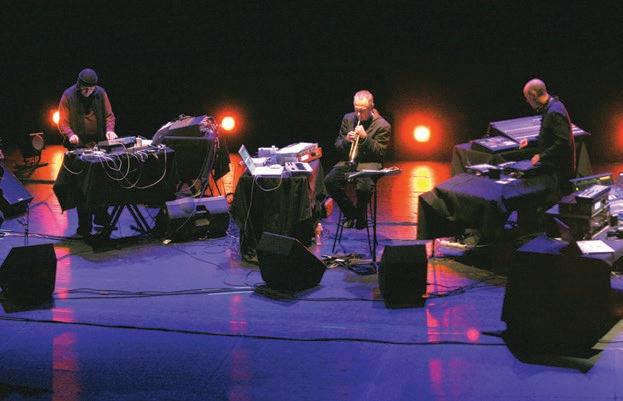
purist. Those identities can be hard to break down, but the spirit of our festival is to create an environment where people can flow freely into these different worlds, feel completely at home, and just discover what they might discover.
We seem to be in a moment when the traditional cultural centers are losing their monopoly on influence. Is it important that you’re in the South? Is there something distinctive about that?
Well, we talked about Knoxville being my secret weapon. But what you just touched on should not be overlooked. I’ve become increasingly committed to highlighting the South in various ways because, for one thing, the foundation of contemporary worldwide popular music is arguably the Caribbean to New Orleans, and up the Mississippi Delta to Memphis. Some of it went on to Chicago, some of it came over to Nashville, went through Knoxville, even over to the Carolinas. So, there’s this incredibly rich cultural diaspora, if you will, that is still very alive. And on top of that, you’ve got the Southern traditions of food and literature, which are in their own unique ways, edgy.
For whatever reason, the South has been kind of the red-headed stepchild of the United States. But I think, culturally, the South is naturally avant-garde because it always kind of thumbed its nose at the traditional standards of beauty or proper behavior, whether it’s in the style of singing or the playing of the fiddle. I feel like that’s still something our festival is just scratching the surface of, to be perfectly honest. I’ll never forget—in 2009, after Philip Glass was with us for an entire weekend, he told someone in an interview that “there’s something happening in the southern United States.”
In 2009, were there experiences that made you think: Hey, this is exactly what I was dreaming of?
There was an electrifying magic in the air during that first Big Ears. From the deep soulfulness of Antony and the Johnsons to Philip Glass’s quietly majestic solo-piano performance and cellist Wendy Sutter’s riveting performance of Glass’s “Songs and Poems for Solo Cello” to Pauline Oliveros, who conducted her Deep Listening workshops, it was a remarkable sequence of performances that moved me to no end. Jon Hassell’s performance was hypnotic and ethereal. It was like time stood still. You could have heard a pin drop in the Bijou Theatre.
There was a small audience of only a few hundred, just enough to fill the Bijou, which was our main venue that year. Some knew exactly why they were there, but others were attending out of a sense of curiosity and adventure, open but not quite sure what they were getting into. Yet everyone was swept away. It became clear that there was deep appreciation, almost a hunger, for these immersive, even spiritual, musical experiences.
In that sense, is Big Ears a shared ritual?
Yes. Also, it’s a challenge, and in some ways, it even feels like a little bit of a responsibility because like I said, I didn’t set out with the idea that it was going to have the kind of profile and impact that it’s had. It’s been exhilarating and very challenging to nurture that—to let it grow, but not let it grow too much. Even though it’s grown out of a very personal aesthetic, the potential that it offers for the community and for the region transcends me.
If Big Ears doesn’t stand for any one genre, does it stand for a shared philosophy about music?
This becomes somewhat hard to talk about, but yes, I feel like the collection of experiences that take place during a Big Ears weekend are—and this has become an overused word—transformative, in some sense of the word. They give a weight to the music that is increasingly difficult to appreciate in this world of streaming. You know, I’m an old guy [Capps turned 69 in March]. I grew up in a world where records and liner notes and the physicality of everything was an important component of understanding what music was. I discovered a lot of music by reading liner notes. Frank Zappa turned me on to Edgard Varèse. In some ways, the experience of music has become a lot more ephemeral. So now, a live performance that is presented in a way that supports a broader or deeper appreciation can be an unforgettable moment people carry with them for the rest of their lives.
Larry Blumenfeld is Editorial Director for Chamber Music America. He writes regularly on music and culture for The Wall Street Journal.
44 SPRING 2024
Jon Hassell at the first edition of Big Ears, in 2009.
Photo: Ric Brooks
Directory of Festivals, Schools & Workshops

WHERE TO LISTEN, LINGER, AND LEARN
Above all, summer festivals are gathering places. Musicians and music lovers flock from far and wide to spend time in the company of old and new friends in inviting landscapes, to hear beautiful music.
Professional musicians meet new audiences and explore fresh collaborations. Students enjoy educational experiences beyond even what the
best conservatories can offer. Fans enjoy beautiful venues, adventurous programming, and new friendships built on a shared passion for art of the highest order.
On the following pages, we’ve once again partnered with the Associated Chamber Music Players (ACMP) to present a guide to many of this season’s most exciting offerings. Here’s to summer—see you out there.
Directory of Festivals, Schools & Workshops
PRESENTED IN COLLABORATION WITH ASSOCIATED CHAMBER MUSIC PLAYERS (ACMP)
NOTE: The vast majority of our listings occur in SUMMER—defined here as Memorial Day through Labor Day. Festivals and workshops that fall outside of this period are designated as SPRING, FALL, or WINTER Listings for programs with an educational component include Age and Level criteria where applicable.
Arizona
Tucson Adult Chamber
Players
FALL WINTER
September–December
Tuscon
Kaety Byerley, Founder tacp@arizonachambermusic.org
Student Ages: 18+
Level(s): Beginner to Advanced Participants form chamber groups with the help of experienced coaches who match participants based on their level and help select repertoire. Over two months, participants receive eight 90-minute coaching sessions from local professional musicians, culminating with a recital showcasing what they have learned. Any string, wind, or piano player is welcome to join; pre-formed groups are welcome, too. Financial aid is available.
California
Chamber Music Institute/So Cal
SUMMER
July 15–28
Los Angeles and Southern California
Kay@chambermusicinstitute.com chambermusicinstitute.com
Student Ages: 8+
Level(s): Intermediate to Pre-professional
The CMIsc Chamber Music Program is a two-week summer music course providing extraordinary opportunities and exposure to aspiring and established performers on violin, viola, and cello. The program engages performers of all ages through group rehearsals, coaching sessions with highly regarded coaches, and improvisation with a goal of creating a performance of string chamber music at the 2:00PM concert July 28 at the Nixon Library Theater in Yorba Linda, California.
Community Music Center Adult Chamber Music Workshop
SUMMER
August 2–4, August 9–11
San Francisco
Michelle Lee mlee@sfcmc.org
sfcmc.org/course/adult-chamber -music-workshop/
Student Ages: 16+
Level(s): Intermediate to Advanced
Immerse yourself in chamber music and develop your collaborative ensemble playing this summer. Participants will play in supportive small
ensembles, coached by expert CMC faculty specializing in chamber music. The twoweekend workshop includes master classes, listening skills, ensemble skills, and rehearsal time for instrumentalists, culminating in a friendly salon concert during which you can share your work with one another and invited guests. Pre-formed groups as well as individuals are encouraged to apply.
Community Music Center Chamber Music Camp SUMMER
June 17–21, 24–28 San Francisco
Michelle Lee mlee@sfcmc.org
sfcmc.org/play/summer-music -camps/
Student Ages: 12–18
Level(s): Intermediate to Advanced
Young strings, piano, and wind players can spend the summer playing in supportive and collaborative small ensembles, coached daily by expert CMC faculty. Students also participate in master classes, ensemble skills lessons, and independent chamber music rehearsals to build both technical and artistic skills. An informal recital will be
presented at the end of camp. Pre-formed groups as well as individuals are encouraged to apply for either or two summer sessions. Tuition assistance is available.
Crowden Music Center Chamber Music Workshop for Youth SUMMER
July 15–26
Berkeley communityed@crowden.org crowden.org/chamber-music -workshop
Student Ages: 14–18
Level(s): Intermediate to Advanced
Crowden’s internationally celebrated faculty guides serious high school- and college-aged string and piano students through an intensive and inspirational two-week course in this immersive chamber music workshop. Develop ensemble playing skills through the performance and study of the world’s greatest chamber music masterworks! Students participate with at least two chamber groups in daily coached rehearsals, and receive additional instruction in string chamber orchestra or piano duo, master classes, alternative style, and improvisation workshops. The
46 SPRING 2024
workshop includes open faculty rehearsals and a public faculty concert and culminates with two high-level concerts performed by the students.
Crowden Music Center Chamber Music Workshop for Adults
SUMMER
July 31–August 4
Berkeley communityed@crowden.org crowden.org/adult-chamber -music-workshop/
Student Ages: 21+
Level(s): Intermediate to Advanced
Crowden’s five-day intensive Chamber Music Workshop for Adults features daily coached rehearsals, as well as daily master classes and independent rehearsal time. Each participant plays in two ensembles, delving into chamber music’s most beloved pieces. Crowden’s renowned chamber music faculty share their passion and expertise
as they guide students through a deepened development of ensemble playing skills and music appreciation, culminating in a concert for family and friends on the workshop’s final day.
Festival Mozaic
SUMMER
July 19–27
San Luis Obispo County Lloyd Tanner, Executive Director info@festivalmozaic.org festivalmozaic.org
Festival Mozaic celebrates its 53rd Summer Music Festival with 30+ performances and events held in unique venues throughout beautiful San Luis Obispo County wine country. The 2024 lineup includes chamber music, orchestral concerts, immersive and educational “Notable Encounter” experiences, family programming, free midday recitals, film screenings, and Central Coast food and wine, all curated by Music Director Scott Yoo.
Music@Menlo Chamber Music Festival and Institute
SUMMER
July 19–August 10 Atherton/Virtual Daphne Wong info@musicatmenlo.org musicatmenlo.org
Student Ages: 10–30
Level(s): Advanced/ Pre-professional
Music@Menlo is an internationally acclaimed chamber music festival and institute in the San Francisco Bay Area. Founded in 2003 by David Finckel and Wu Han, Music@Menlo features unique immersive programming, intimate performance venues, open-access educational events, and world-class training programs for pre-professional musicians. The 2024 summer festival features more than 40 artists and explores the rich history of French chamber music, uncovering the innovations of French composers and their
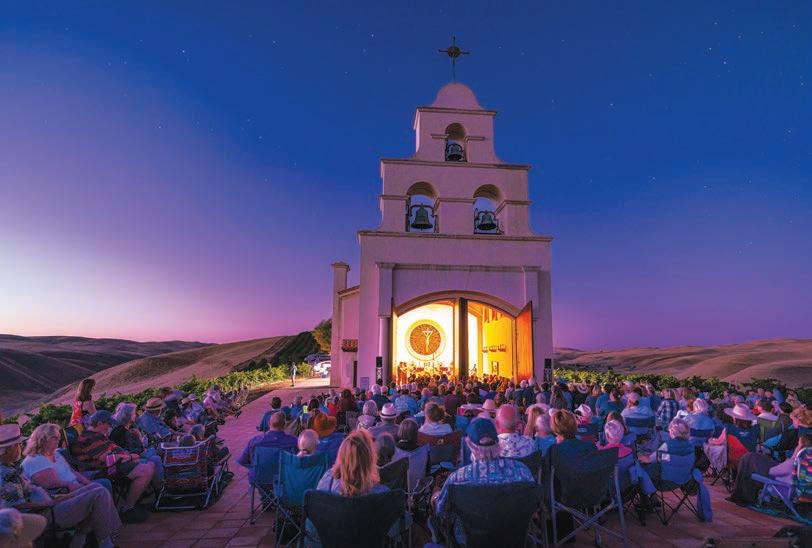
counterparts around the world through concert programs, recitals, lectures, and more.
The San Francisco Early Music Society Baroque Workshop
SUMMER
June 24–30
Berkeley
Lindsey Strand-Polyak baroqueworshop@sfems.org sfems.org/workshops
Student Ages: 12–80
Level(s): All levels
The Baroque Workshop will be a full week of immersive musicking open to singers, keyboard and plucked continuo instrumentalists, and wind and string players. There will be classes on ornamentation and baroque dance (naturellement!); large ensembles such as orchestra and oboe band; chamber music, special talks, and technique classes. Special events include Concerto Night, Faculty Concert, Chamber and Orchestra concerts, and new for 2024: Cantata Night!
The San Francisco Early Music Society
Medieval/Renaissance Workshop
SUMMER
July 14–20
Berkeley
Adam Gilbert
medrenworkshop.sfems@ gmail.com
sfems.org/workshops
Student Ages: 12–80
Level(s): All levels
We welcome singers and instrumentalists of all kinds: all vocal types, strings, winds, brass, and keyboardists playing instruments of the period. We will tailor your experience to your skill level and ability so that you will feel both comfortable and challenged.
47
A Festival Mozaic concert at the Serra Chapel in Shandon, Calif.
Photo: Courtesy Festival Mozaic
See website for this year’s theme. There are four class periods during the day: technique classes in the morning; a late-morning collegium for the whole group; and two special topic classes in the afternoon. Every evening affords individual or group practice, followed by special presentations or faculty concerts. The week culminates in student performances Friday night and Saturday morning.
The San Francisco Early Music Society Recorder Workshop
SUMMER
July 21–27
Berkeley
Annette Bauer recorderworkshops @sfems.org
sfems.org/workshops
Student Ages: 12–80
Level(s): All levels
Visit our website for this year’s theme. Fill your days with recorder ensembles, technique classes, Renaissance consorts, recorder orchestra, masterclasses, concerts, lectures, and more. Explore Medieval, Renaissance, Baroque, contemporary, and world music in an intimate setting with world-class faculty.
SoCal Chamber Music Workshop
SUMMER
July 21–27
Claremont
Carol Osborne
info@socalchambermusic.com socalchambermusic.com
Student Ages: 18+
Level(s): Intermediate to Advanced
The SoCal Chamber Music Workshop is a one-week workshop at Scripps College for adult-amateur and
professional chamber musicians, ages 18 and above. Our participants include strings, piano, and winds. Musicians spend their days working on chamber music repertoire while receiving coaching to improve the quality of their musicianship in an ensemble. Our environment is welcoming, positive, and social, while encouraging each musician to push beyond their limitations.
Stanford Jazz Festival
SUMMER
June 20–August 3
Stanford
Steven Lugerner info@stanfordjazz.org stanfordjazz.org
Stanford Jazz Workshop (SJW) is a 52-year-old independent nonprofit dedicated to the perpetuation of jazz music through educational programs and concerts of the highest artistic quality. Our mission is to educate, entertain, and inspire a community of artists, students, and audience members through the study, performance, and appreciation of jazz—an original American musical form. Our summer jazz immersion programs are held on the beautiful campus of Stanford University during July and August each year. We produce the annual Stanford Jazz Festival, featuring many of the world’s greatest jazz artists.
Valley of the Moon Music Festival
SUMMER
July 13–28
Sonoma
Grace Parisi, Managing Director info@valleyofthemoonmusic festival.org
valleyofthemoonmusic festival.org
Student Ages: 10+
Level(s): Advanced
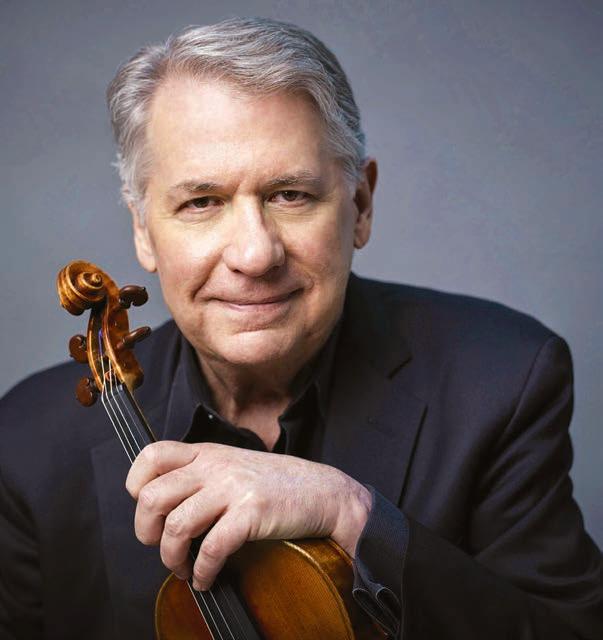
Minutes with Philip Setzer 5
Philip Setzer, a founding member of the Emerson String Quartet, stayed with that ensemble through its final concert this past October––a span of nearly 50 years. The veteran violinist still performs chamber music. His career as an educator and arts administrator was, he says, forever shaped by his three summers as a young musician at The Marlboro Music Festival. This summer, he takes on a brand-new challenge: his first as the artistic director of Vermont’s Manchester Music Festival. In that role, he’ll highlight a different half-century legacy: The festival, nestled in the beautiful Green Mountains of Southern Vermont, marks 50 years of showcasing established stars and young talents with more than 30 events beginning
July 11. When we met recently via Zoom, Setzer reflected on this new chapter in his career, his commitment to passing on the chamber music tradition, and the role of a chamber music festival. —Fred Cohn
48 SPRING 2024
Photo: Richard Malcolm
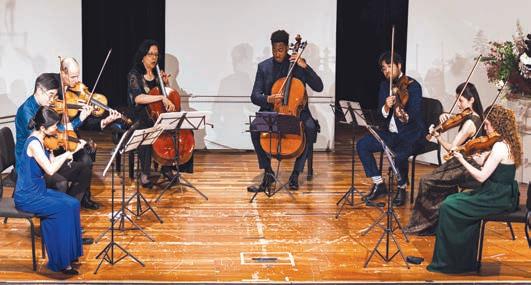
Chamber
What led you to this position at Manchester Music Festival?
Setzer: When I got the offer, I was reluctant. I told my wife Linda, “This going to be time-consuming. And it’s something I’ve never done before.” She said “Exactly. It’s the one thing you’ve never done before––so why don’t you do it?” So, here I am.
The musicians in Manchester’s Young Artists Program will now be playing alongside guest artists in the festival’s main concerts. Why was this a priority?
In my early days, at Marlboro Music, I got to play alongside titans like Rudolf Serkin and Alexander Schneider. Getting to work with these venerable musicians—not just to be
coached, but to sit there and actually rehearse with them— made me feel incredibly lucky. I’ve tried to do this with my own students.
How do these collaborations benefit young musicians?
The young artists aren’t coming to Manchester for piano lessons or violin lessons; they’re coming to be part of the fabric of the festival. In a coaching, you say things, they try it, and then you move on. How much is that going to sink in?
At Marlboro, we spent a whole summer with [the late Hungarian violinist and conductor] Sándor Végh preparing the Beethoven Op. 132 quartet—microscopically, note by note. It was difficult and frustrating to be working
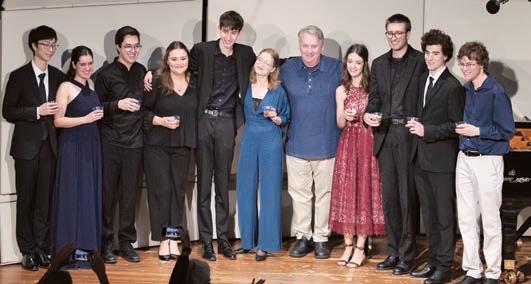
that slowly, but at a certain point he’d say, “Let’s play through the first movement,” and it was like—wow
When I’m working with young musicians at a festival, I’ll stop rehearsal and tell a story. Because that’s what those guys did at Marlboro. While a few of us were working on some Webern once, we had lunch with Felix Galimir, who knew Webern and Berg and Schoenberg personally. We asked him what these men were like, and he said: “You’re walking along and you see Berg across the street. You go ‘Alban!’ and he crosses across lanes of traffic to give you a big hug and a kiss, then he runs back into the traffic. With Webern, you’d be walking along and see this man with his head down and you say ‘Anton!’ and he
says ‘Nicht so laut! Nicht so laut!’ [‘Not so loud! Not so loud!’]. With Schoenberg, you’d say ‘Guten morgen,’ and he’d say, ‘What do you mean by that?’”
What can students glean from stories like that?
To demonstrate the difference between Webern and Berg, which has so much to do with their personalities. Webern is very small and Berg is so big. It’s important for all of us to have some historical context and connect with the people who’ve created the art. The more you understand, the more you humanize these composer-gods who walked the earth, the more you can feel sure of what you’re doing as an interpreter and a performer.
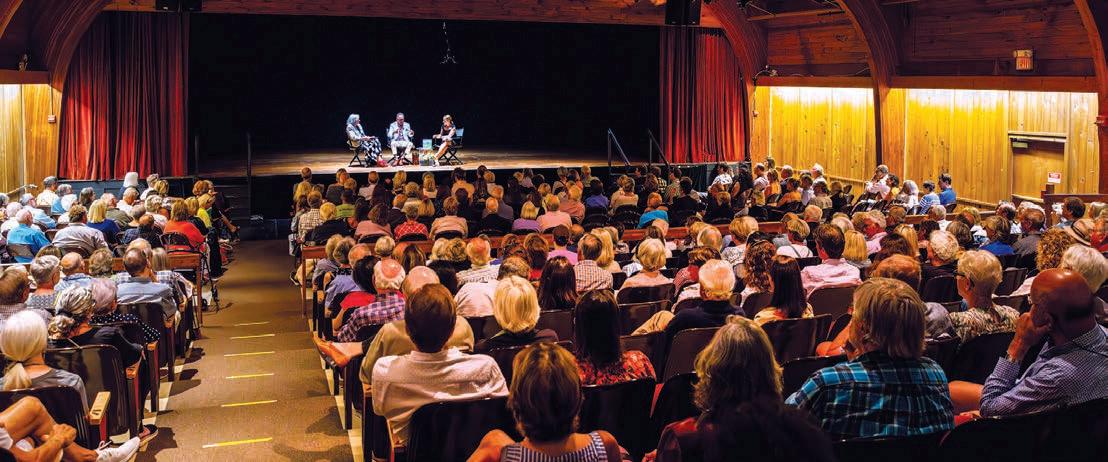
49
Photo: Barry Carlton
Above and below: Scenes from Vermont’s Manchester Music Festival.
Music:
The Valley of the Moon Music Festival, nestled in the heart of the Sonoma Valley, is the first music festival in the United States to focus on Classical and Romantic music on period instruments.
Colorado
Bravo! Vail Music Festival
SUMMER
June 20–August 1
Vail Parker Owens, Senior Director of Marketing & Communications info@bravovail.org www.bravovail.org
One of the top-10 classical music festivals in the United States, Bravo! Vail features 80+ concerts across Colorado’s stunning Vail
Valley region. This season, its acclaimed Chamber Music Series includes performances from Sergei Babayan, Paul Huang, Igor Levit, Anne-Marie McDermott, Jennifer Montone, Ricardo Morales, Daniil Trifonov, the Dalí Quartet, and the New York Philharmonic String Quartet. Furthermore, Bravo! Vail’s Immersive Experiences, Classically Uncorked, and Linda & Mitch Hart Soirée Series offer music by small ensembles in even more intimate settings.
Denver Chamber Music Festival Amateur Chamber Music Workshop
SUMMER
June 7–9
Denver dcmfworkshop@gmail.com
denverchambermusicfestival.org
Student Ages: Adults
Level(s): Intermediate or Higher (Amateur)
Hosted by the Newman Center at the University of Denver, participants will enjoy two full days of chamber music immersion. We will welcome preformed groups and individual musicians to work with world-class DCMF Artists.
Manitou Chamber Music Festival
SUMMER
July 14–28
Colorado Springs
Jeri Jorgensen jerijorgensen54@gmail.com manitouchambermusic festival.com
Student Ages: 14–20
Level(s): AdvancedIntermediate to AdvancedHigh-School
The Manitou Chamber Music Festival is a dual-faceted performance and education community that is created in July at the foot of Pikes Peak. Faculty from around the country come together to create chamber music performances that combine beloved masterworks of the repertoire with new voices and innovative programming. Faculty artists also mentor pre-college student musicians in small groups as they delve into the world of chamber music. Students share the stage with faculty at the final concert, and student groups prepare two complete works in anticipation of the

50 SPRING 2024
2024 DIRECTORY OF FESTIVALS, SCHOOLS & WORKSHOPS
student concerts at the end of the two-week festival.
Sphinx Performance Academy
SUMMER
June 20–July 20
Boulder, CO & New York City, NY
Ana Abrantes
spa@sphinxmusic.org
sphinxmusic.org/sphinx
-performance-academy
Student Ages: 11–17
Level(s): Advanced String Players
Sphinx Performance Academy (SPA) is a full-scholarship intensive summer chamber music and solo performance program with a focus on cultural diversity for string musicians. Curriculum includes lessons, masterclasses, recitals, career enrichment sessions, and mentorship tailored to each student. SPA offers a chamber orchestra and solo repertoire
Connecticut
Charles Ives Music Festival
SUMMER
July 29–August 11
Danbury
Paul Frucht
cimf@wctyo.org
charlesivesmusicfestival.org
Student Ages: 10–21
Level(s): Intermediate to Advanced
Charles Ives Music Festival (CIMF) is a two-week program for advanced youth musicians seeking to immerse themselves in the art of chamber music. Participants should have several years’ experience on their instruments and should have prior chamber music experience. Throughout the festival, participants will rehearse with artist-faculty in at least one chamber group culminating in a performance presented on
Washington, D.C.
Washington International Piano Festival
SUMMER
July 27–August 4
Dr. Nikita Fitenko
contact@washingtonpiano fest.com
washingtonpianofest.com
Student Ages: All
Level(s): All
A nonprofit arts organization dedicated to the performance and teaching of classical music at the highest standard, the Washington International Piano Festival takes place every summer on the beautiful campus of the Catholic University of America. Young aspiring concert pianists, teachers, amateurs, and piano lovers of all ages from all over the world are invited to participate in this inspiring and
Florida
Sarasota Music Festival
SUMMER
June 2–22
Sarasota
Olivia Steinman Deems SMF@sarasotaorchestra.org
sarasotamusicfestival.org
Student Ages: 18+
Level(s): Pre-professional to Professional
Led by music director Jeffrey Kahane, the Sarasota Music Festival is a magical combination of youthful promise and acclaimed talent. Exceptional fellows from top music programs work side-by-side with internationally recognized faculty artists, including flutist Jasmine Choi, violinist Tessa Lark, and the Borromeo String Quartet. With a theme of “Music Unbound,” programming for 2024 spotlights the alchemical magic that results
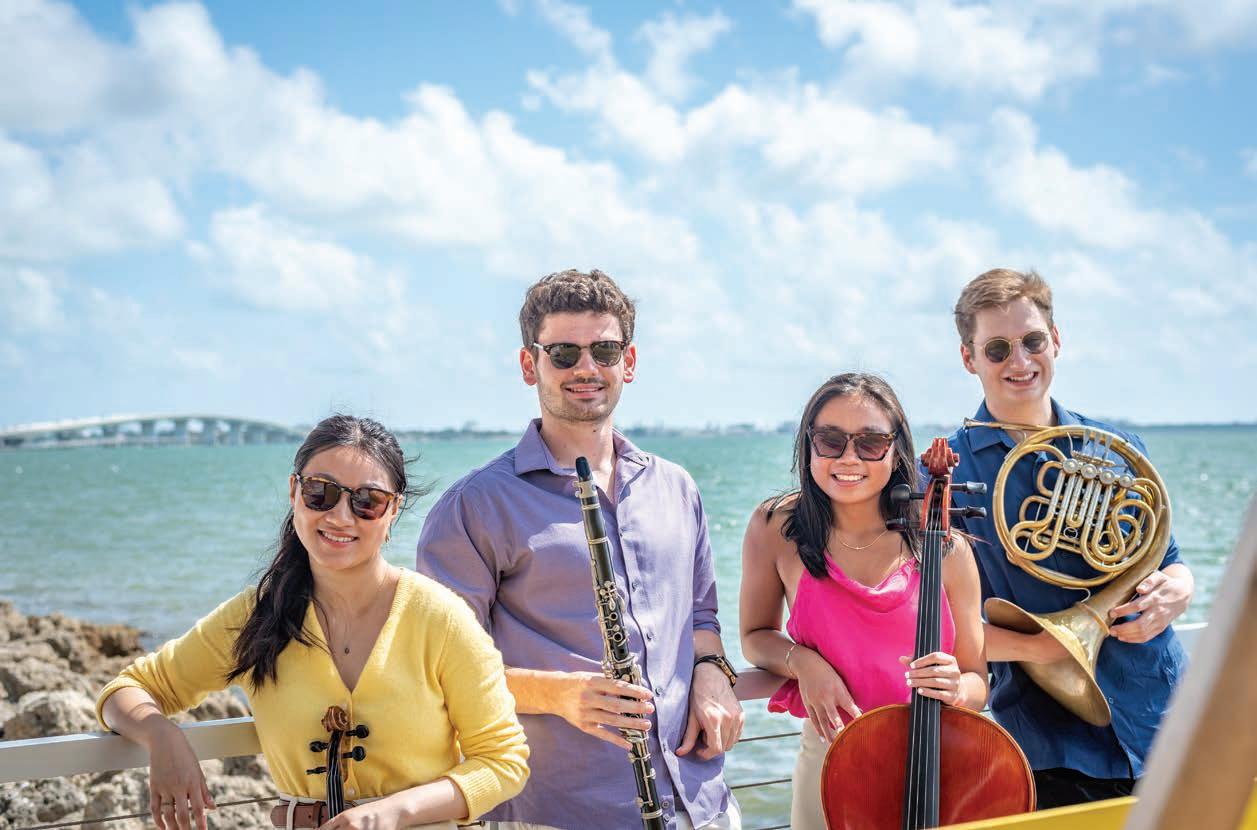 A student ensemble at the Sarasota Music Festival
Photo: Kim Gagnon
A student ensemble at the Sarasota Music Festival
Photo: Kim Gagnon
The St. Augustine Music Festival presents its 18th Season
June 19th through June 30th, 2024
Experience world class music, five centuries of architecture, and a vibrant arts and culinary scene in America's Oldest City, St. Augustine, Florida.
The St. Augustine Music Festival is the largest free classical music event in the United States, with six performances at the magnificent Cathedral Basilica from June 21st through June 30th.
This year's Festival will commemorate the sixtieth anniversary of the Civil Rights demonstrations in St. Augustine with a concert by pianist Marcus Roberts and the SAMF Orchestra, performing Rhapsody in Blue at Lewis Auditorium on June 19th.
Visit StAugustineMusicFestival.org for this year's program and to purchase tickets for the Juneteenth event.
Plan your trip to St. Augustine at HistoricCoastCulture.com
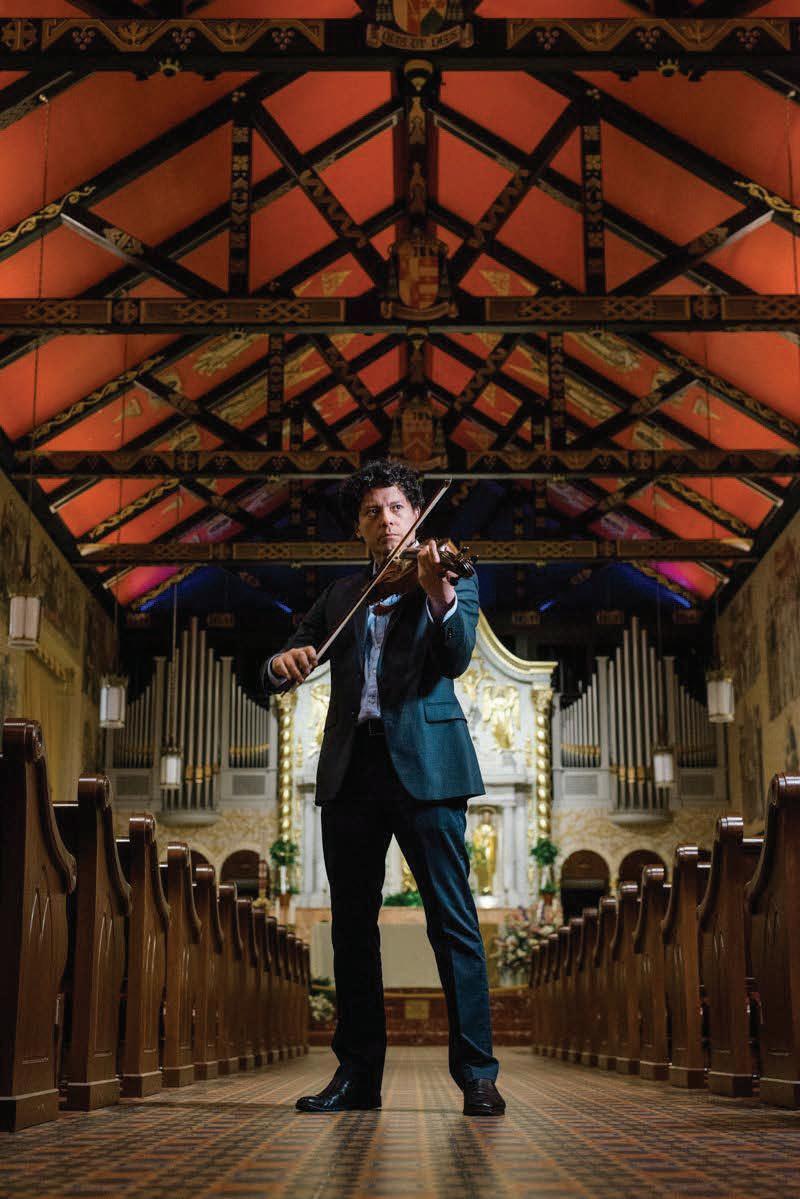

Georgia Chamber Music
gcmr@peterwh.com peterwh.com/gcmr.html
Student Ages: 18+
Level(s): Sight-reading
Amateur to Professional
One hundred musicians gather for a weekend of chamber music reading, food, and fun at gorgeous Berry College campus in Rome, Georgia, nestled in the foothills of the Appalachian Mountains. The beautiful 27,000-acre campus is the world’s largest campus and includes horseback riding, hiking, waterfalls, frisbee golf, and more. Mixed strings and winds, plus piano, Friday evening through Sunday afternoon. All playing is informal. Competent sight-reading and nice personality are required. No instruction provided. Prior year attendees get first opportunity to return. Summer Institute for Piano
ensembles, string orchestra, choir, social time, and evening concerts by faculty, students, and alumni in a supportive and fun learning environment.
Sun Valley Music Festival SUMMER
July 29–August 22
Sun Valley Deanna Harned, Artistic Planning Director info@svmusicfestival.org svmusicfestival.org
Now in its 40th year, the Sun Valley Music Festival is the largest privately supported, free-admission classical music festival in the United States. Over 100 world-class musicians from North America’s most distinguished orchestras comprise the Festival Orchestra and chamber music partners. Luminaries performing as part of this summer’s chamber music concerts include Jeremy Constant, Peter Henderson, Sir Stephen Hough, Meechot Marrero, Garrick Ohlsson, Milana Elise Reiche, Polina Sedukh, Adam Smyla, Chris Tantillo, Stephen Tramontozzi, Emileigh Vandiver, Susan Warner, and Amos Yang.
Illinois
Chicago Jazz
String Summit
SPRING
May 17–19
Student Ages: 13–18
Level(s): Intermediate
SIPS is a week-long summer camp on the campus of Idaho State University for young players of string instruments and piano from grades 8 to 12, organized and taught by ISU faculty members. Activities include coached chamber music

Indiana
Fischoff National Chamber Music Competition SPRING
May 10–12
South Bend Scott Campbell fischoff@fischoff.org fischoff.org
Chicago
Tomeka Reid
chicagojazzstringsummit @gmail.com
chicagojazzstringsummit.com
The 10th anniversary of a string festival that celebrates innovative string improvisors and composers on violin, viola, cello, and strings of the diaspora!
Founded in 1973, the Fischoff National Chamber Music Competition has grown to become the largest chamber music competition in the world, and one of the most prestigious classical music prizes attainable today. The 51st Fischoff Competition takes place at the University of Notre Dame, where hundreds of young musicians will vie for prizes, tours, and the prestige of becoming a Fischoff winner. Live-streaming of the competition can be viewed at fischoff.org. All competition rounds are free and open to the public.
Fischoff Chamber Music
Summer Intensive SUMMER
June 10–14
Notre Dame
Geena Kam geena@fischoff.org
fischoff.org/education/chamber -music-summer-intensive/ Student Ages: 11–18
Levels: Intermediate to Advanced
The Fischoff Chamber Music Summer Intensive brings together young musicians and renowned professionals in a five-day intensive program of chamber music study, masterclasses, workshops, solo and ensemble performances, and community engagement opportunities. The program is open for intermediate to advanced strings, brass, wind, and piano students in grades 6 to 12. With the beauty of Saint Mary’s College as a backdrop, the 2024 Fischoff Chamber Music Intensive will be a transformative musical experience for students.
Maine
Bowdoin International Music Festival
SUMMER
June 24–August 2
Brunswick
Grace Bell
grace@bowdoinfestival.org
bowdoinfestival.org
53
OF FESTIVALS, SCHOOLS & WORKSHOPS
2024 DIRECTORY
Students at the Fischoff Chamber Music Summer Intensive
Photo: Courtesy of Fischoff Chamber Music Summer Intensive
Student Ages: 13–30
Level(s): Advanced
One of the world’s premier music institutes, the Bowdoin International Music Festival provides an intensive and in-depth exploration of chamber and solo music. With about 250 students on campus each summer, the Festival cultivates personal attention, encouragement, and nurturing in a setting that includes a broad range of collaborative and supportive relationships, and hundreds of opportunities to learn, rehearse, and perform. Students are defined by their dedication, creativity, curiosity, and passion for excellence in music.
Kneisel Hall
Chamber Music Festival
SUMMER
June 23–August 25
Blue Hill
Meredith Amado festival@kneisel.org
kneisel.org
Student Ages: 18–28
Level(s): Pre-professional
Kneisel Hall is an internationally recognized chamber music school and festival. Known as “the cradle of chamber music in America,” Kneisel Hall has provided musicians with the opportunity to immerse themselves in the chamber repertoire since 1902, realizing the vision of its founder, Franz Kneisel, for more than 100 years.
Portland Chamber Music Festival
SUMMER
August 8–17
Portland
Sam Kyzivat office@pcmf.org pcmf.org
The Portland Chamber Music Festival presents internationally renowned artists and ensembles
performing a wide range of repertoire with an intimate, family feel. PCMF’s offerings include exquisite concerts performed at the highest levels of artistry, innovative genrebending programs, and informal connections with extraordinary artists for students and community members of all ages. The festival’s 31st summer season will take place in August at the University of Southern Maine’s Hannaford Hall.
Seal Bay Festival
SUMMER FALL
July 30–August 6; September 25–29
Vinalhaven
Muneko Otani muneko@gmail.com
sealbayfestival.org
Now in its 21st season, Seal Bay Festival presents chamber music concerts performed by Cassatt String Quartet and guest artists in communities throughout the state of Maine. SBF brings American chamber music to concert audiences, community spaces, and school children in the exquisite setting of coastal Maine, including venues in Vinalhaven, North Haven, Belfast, Topsham, Brunswick and Portland. SBF also hosts a resident program for emerging and established composers.
Sebago-Long Lake Music Festival
SUMMER
July 16–August 13
Harrison
Mihae Lee, Music Director music@sebagomusicfestival.org sebagomusicfestival.org
Surrounded by the beauty of southwestern Maine, SebagoLong Lake Music Festival has held five Tuesday evening
chamber music concerts during July and August for 52 years. Renowned for its diverse and high-caliber programs in a beautiful woodland setting with superb acoustics, the Festival has been a summer highlight for many residents and visitors. Our Music Director and pianist Mihae Lee presents 23 superb musicians performing in the historic Deertrees Theatre.
Winter Harbor Music Festival Chamber Music Workshop
SUMMER
August 4–11
Winter Harbor Deirdre McArdle info@winterharbormusic festival.org www.winterharbormusic festival.org
Student Ages: 21+
Level(s): Intermediate to Advanced
Winter Harbor Music Festival offers a weeklong chamber music workshop on Schoodic Peninsula, Acadia National Park. Participants are housed in the community with shared suppers at Pt. Alva, our homebase on Frenchman Bay. Ensembles include coaches as players and are musically democratic, with all opinions valued equally. WHMF is a relaxed and supportive program that delivers a highlevel musical experience. The scenery is spectacular and time for enjoying the glories of Downeast coastal Maine is included in the schedule.
Maryland
Chesapeake Chamber Music Festival SUMMER
June 7–15
Easton
Margaret Enloe-North info@chesapeakemusic.org ChesapeakeMusic.org
The 39th annual Chesapeake Chamber Music Festival once again brings world-class performers—masters of their instruments and in artistry—to the exquisite Ebenezer Theater. This year’s theme of “Festival Firsts” reflects beginnings, fresh starts, new ideas, and introductions and includes the winning young ensemble from our 2024 Chamber Music Competition for Young Professionals (held and livestreamed on April 13).
Discover Quintet SUMMER
June 24–28
Camp Springs
Nancy Switkes discoverquintet@gmail.com discoverquintet.net
Student Ages: Grade 9 to Rising College Freshmen
Level(s): Intermediate to Advanced
Rehearsals of three wind quintet ensembles coached by top D.C.area freelancer/educators. Students learn parts ahead of day one. Yoga and fun group rhythm games connect new players and friends. Final afternoon miniconcert for parents and friends.
Flute-a-rama Summer Camp SUMMER
July 8–12, 15–19
Takoma Park
Melissa Lindon fluteworkshops@gmail.com flute-a-rama.org
Student Ages: Grades 6–12
Level(s): Advanced Beginner to Advanced
Flute-a-rama summer flute camp, held at Washington Adventist University, offers creative, interactive, and engaging fun for flute students. With flute chamber music as its centerpiece, it seeks to nurture students’ love of music and develop their musicianship, leadership skills, confidence, and social
54 SPRING 2024
OF FESTIVALS, SCHOOLS & WORKSHOPS
2024 DIRECTORY
connections. Co-founded and co-directed by expert flute teachers Carrie Rose and Melissa Lindon, the program is unique and highly regarded throughout the BaltimoreWashington region. Students can attend one or two weeks.
Intermuse International Music Institute and Festival
SUMMER
June 14–23
Emmitsburg
Frances Borowsky info@imif.us imif.us
Student Ages: 12–24
Level(s): Intermediate to Advanced
Intermuse Festival is a 10day program with a 20-year history that hones the skills of participants through chamber music and solo work coachings, guest masterclasses, interdisciplinary workshops, recitals, and team-building discussion. Internationally renowned faculty work daily with strings and piano students.
Massachusetts
Boston Youth Symphony Orchestras Summer ChamberFest
SUMMER
July 8–12
Boston
Miriam Eckelhoefer bysochambermusic@gmail.com bysoweb.org/summer chamberfest
Student Ages: 8–18
Level(s): Suzuki Book 4 for violins; Book 3 for violas, cellos, and double bass; ABRSM Level 4, or Suzuki Book 4 (Mozart Sonatina or Beethoven Sonata) for pianists
Boston Youth Symphony Orchestras (BYSO) is launching
a summer chamber music program open to BYSO and non-BYSO students. The goal of BYSO Summer ChamberFest is to provide an intensive chamber music experience for intermediate and advanced string and piano students. Classes will take place at BYSO’s new Youth Center for Music in the heart of the Boston music scene. In addition to daily chamber music coachings, students will take part in a variety of music enrichment classes and electives including musicianship, theory, chorus, improvisation, drumming/ rhythm, yoga, and Alexander Technique.
Brookline Music School’s Chamber Music Festival
SUMMER
June 24–July 3
Brookline
Egle Jarkova info@bmsmusic.org bmsmusic.org/summer/ chamber-music-festival
Student Ages: 9–16
Level(s): All
Open to all string (including guitar) and wind instrumentalists, and pianists, this eight-day program is designed to allow students to immerse themselves in all aspects of music including two private lessons, chamber ensembles, music theory and ear-training, music history and appreciation, performance practice, string, large ensembles. The program will conclude with a performance.
Cape Cod Chamber Music Festival
SUMMER
July 30–August 16
Wellfleet, Eastham, Chatham, Cotuit, Falmouth
Ray Salva, Executive Director info@capecodchambermusic.org
CapeCodChamberMusic.org
Hailed by The New York Times as “A Triumph of Quality,” the Cape Cod Chamber Music Festival celebrates its 45th anniversary during the 2024 Summer Season. Since 1979, the festival has brought world-class chamber music ensembles and musicians from around the globe to Cape Cod. It regularly commissions and performs new works by living composers and has a special commitment to presenting young emerging artists early in their careers, including Yo-Yo Ma, Emmanuel Ax, Joshua Bell, and many others.
ChamberFest Adult Intensive Workshop
SUMMER
June 21–23
Worcester
Ariana Falk
ariana@worcesterchamber music.org
worcesterchambermusic.org/ chamberfest/adult-intensive Student Ages: 18+ Level(s): All (Amateur Only)
Join us this summer for a weekend chamber music intensive where you’ll enhance your technique and skill and learn from renowned performers. The workshop includes coaching sessions, music-related workshops, and a concluding performance.
Springfield Jazz & Roots Festival SUMMER
July 12–13
Springfield
Kristin Neville info@bluestogreen.org springfieldjazzfest.com
This annual free music festival features regional, national, and international musicians, youth arts groups, music education, and family arts activities, all celebrating music of the African diaspora. Drawing visitors from throughout the Northeast to downtown Springfield, it unites
the region’s diverse cultural communities through music, arts, education, and revelry. Past performers have included: Terri Lyne Carrington, Elio Villafranca, Tia Fuller, William Cepeda, Joey DeFrancesco, Dayme Arocena, Etienne Charles, Pedrito Martinez, Delfeayo Marsalis, Cory Henry, Sweet Honey in the Rock, Taj Mahal.
Michigan
Baroque on Beaver
SUMMER
July 25–August 3
Beaver Island
Matthew S. Thomas info@baroqueonbeaver.org baroqueonbeaver.org
Situated on the most remote inhabited island in the Great Lakes, this 10-day series presents professional orchestral, vocal, and chamber music concerts spanning multiple genres under the guidance of Music Director Robert Nordling. The festival welcomes worldclass musicians from the Midwest and nationally for its ensembles each year. Past guest artists include Garrick Ohlsson, Ying Li, The Lincoln Trio, Peter Ferry, Matthew Cochran, Martha Guth, and Kevin Cole. Recent commissions include works by Clarice Assad (2022), Tony Manfredonia (2022), and Eric Malmquist (2024). Now in its 23rd annual season, Baroque on Beaver is presented by the nonprofit Beaver Island Performing Arts Alliance.
Minnesota
Stringwood Chamber Music Festival
SUMMER
August 3–18
Lanesboro
Ray Shows
55
ray@artaria.us stringwood.com
Student Ages: 12–22
Level(s): Advanced
Stringwood is a premier chamber music festival for advanced students. Lodging and rehearsals are at the Eagle Bluff Environmental Learning Center, home to yearround naturalists, organic gardens, pristine woodlands, canoeing, high ropes courses, indoor rock wall, and bike trails. Artaria String Quartet is in residence, with guest artists: Frank Almond, violin; Paul Laraia, viola; Brandon Vamos, cello. The festival includes masterclasses, private lessons, and six public performances including in Spillville, Iowa, summer home of Antonin Dvorak.
Missouri
Artaria Adult Amateur Workshop
FALL
September 27–29
Lanesboro
Nancy Oliveros nancy@artaria.us artariacms.org/acms adultretreat
Student Ages: 25–75
Level(s): Advanced
Held annually since 2000, this adult workshop, hosted by Artaria String Quartet, is for preformed groups of strings, or strings and piano. Rehearsals and lodging are at the Eagle Bluff Environmental Learning Center, located on restored prairie and mixed hardwood forest on the Root River rich in natural resources and cultural history. The 2024 Workshop features individual group sessions with the Artaria String Quartet, a large group score identification session, a naturalist guided walk through fall foliage, time for sight reading, and communal dining. Public performance by Artaria at
Lanesboro’s destination Sylvan Brewery, and a participant performance “on the Hill.”
Missouri Chamber Music Festival
Adult Chamber Music Intensive SUMMER
July 29–August 3
St. Louis
Nina Ferrigno community@mochmamber music.org
mochambermusic.org
Student Ages: 21+
Level(s): Intermediate to Advanced
The Adult Chamber Music Intensive places instrumentalists in chamber ensembles of various sizes and instrumentation to work with faculty players and coaches. The collaborative faculty include notable chamber musicians from across the country. For more than six days at the Community Music School of Webster University, participants experience inperson rehearsals, coachings, readings, and faculty presentations.
New Hampshire
Northeast Chamber Music Seminar SUMMER
August 6–11
Boscawen
Linda Rosenthal linda.rosenthal@gmail.com lindarosenthal.com/chamber musicseminar
Student Ages: 18+
Level(s): All
The Northeast Chamber Music Seminar, formerly the Lake Placid Chamber Music Seminar, offers adult string players/ pianists the opportunity to play, study, and perform great chamber works at Avaloch Farm Music Institute. Players work with worldclass faculty in a relaxed, supportive environment. Each participant has a private room in a twobedroom suite with shared bathroom, kitchenette, and lounge. Optional late
afternoon/evening activities include sightreading, cello choir, Feldenkrais workshops, and a closing night Participant Concert. Financial assistance is available, based on need.
Raphael Chamber Music Workshop
SUMMER
August 4–11; August 11–18 Wilton
Susan Salm
susan@susansalm.com raphaelchambermusic workshop.com
The Raphael Chamber Music Workshop is one of the original adult chamber music programs in the United States. Established in 1982 and operated and directed by the Raphael Trio’s founding members, the program is recognized for its emphasis on honing chamber music rehearsal skills, attention to musical detail, and getting “under the skin” of the music— in short, indepth chamber music study.
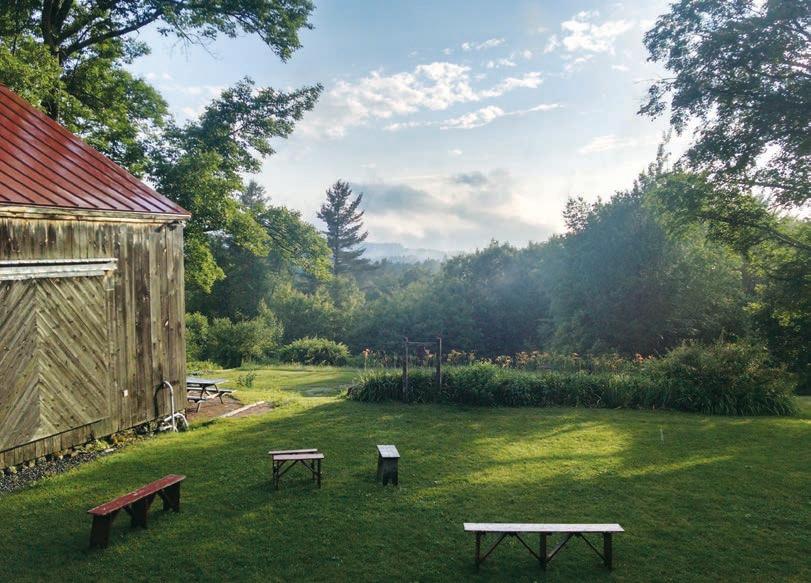
56 SPRING 2024
Photo: Deborah Shapiro
Apple Hill Center for Chamber Music
Apple Hill Summer Chamber Music Workshop
SUMMER
June 14–23; June 28–July 7; July 12–21; July 26–August 4; August 9–18
Nelson
Amelia Perron
amelia@applehill.org applehill.org
Student Ages: 13+
Level(s): Early Intermediate to Advanced/Professional
Each Summer Chamber Music Workshop gives participants the opportunity to study and perform chamber music under the guidance of the Apple Hill String Quartet and renowned faculty in an intentionally supportive environment. Over the course of each 10-day session, students receive personalized coaching, perform in chamber groups, and participate in community activities. This summer, explore your love of music in a diverse, non-competitive community in beautiful, rural, southern New Hampshire.
New Jersey
Maplewood Chamber Music Workshop
SPRING FALL
April 20; Fall Dates TBA Maplewood
Nancie Lederer mcmwplnl@gmail.com
maplewoodchambermusic workshop.com
Student Ages: 10+
Level(s): Intermediate to Expert
There are two sessions per year, each with four Saturday afternoons spaced about a month apart. Players are grouped by skill levels to work on selected pieces. Pre-formed groups are accepted. Each group is coached by professional musicians and works on its own. At the end of each afternoon there is a halfhour presentation of interest to
the participants. Each group has the opportunity to perform at the final workshop.
Youth Orchestra of Central Jersey Summer Chamber Music Camps
SUMMER
July 8–12; July 15–19
West Windsor
Larisa A. Epps executivedirector@yocj.org yocj.org/yocj-summer-camps
Student Ages: 9–18
Level(s): See Website
Youth Orchestra of Central Jersey (YOCJ) provides an immersive summer chamber music experience that is vastly different than our large ensemble offerings during the regular season. We desire to broaden our students’ musical experience and teach the skills needed to play oneon-a-part chamber music. Although the skills of independence, listening, responsibility, and cooperation aren’t unique to chamber music, they do take on a different focus when students transition from orchestra and band repertoire to chamber music. Music education is simply incomplete without a chamber music experience!
New Mexico
Kammermusik Workshops of Santa Fe
SUMMER
August 12–17
Santa Fe
Will Buss
kammermusikworkshops@ gmail.com
kammermusikworkshops.org
Student Ages: 18+
Level(s): Intermediate to Professional
Kammermusik Workshops, in its 29th year, provides chamber
music workshops for adult amateur musicians—winds, strings, and pianists. Our mission is to provide workshops that inspire artistic and personal growth supported by the highest quality professional coaches. We provide a top-notch player experience at a very fair price, all in a relaxed, supportive environment, guided by quality professionals. Financial assistance, in the form of workshop scholarships, is available.
New York
92NY Friday Morning Chamber Music Readings
SPRING SUMMER
February 9–June 14
New York City
Ruth Spencer rspencer@ccny.cuny.edu 92NY.org
Student Ages: All Level(s): Must be Proficient Sight-reader
Weekly chamber music reading sessions at the 92nd Street Y.
Adult Chamber Music Workshop
SUMMER
July 26–28
Rochester
Roberta Zalkind rzalkind@esm.rochester.edu summer.esm.rochester.edu/ course/adult-chamber-musicworkshop
Student Ages: 18+
Levels: Intermediate to Advanced
Experience a weekend chamber music workshop which includes rehearsals, professional daily coachings, and a masterclass with Matthew Zalkind. Open to adult musicians who play the violin, viola, cello or piano; pre-formed groups are also
welcome. Applicants will receive the music prior to the start of the workshop. Applicants can submit a short recording with your application or email the program administrator directly by to determine playing level.
Alaria Chamber Ensemble Summer Workshop
SPRING SUMMER
May 20–June 23
New York City
Yuri Vodovoz info@alaria.org alaria.org
Student Ages: 18+ Level(s): All
This five-week workshop entails one hour rehearsal and one hour coaching per week. Groups will work on a movement from a specific piece, chosen by the artistic director. There is an informal presentation for an invited audience at the end of the five-week session.
Alternative Guitar Summit Camp SUMMER
August 19–23
Big Indian contact@masterscollective.org alternativeguitarsummitcamp.com
Student Ages: 18+ Level(s): All
Now in our 7th year, The Alternative Guitar Summit, produced by Joel Harrison, has become the most forwardthinking, important guitar camp for improvisers in the world. We teach music, not just guitar— artistry at its highest level. By putting students face to face with guitar icons, we help them to grow exponentially and to seek their own voice. We want to improve students’ time, harmony, groove, composition, and bandleading skills. Although many of our teachers focus on jazz, we are not a jazz organization. By celebrating the great
57
2024 DIRECTORY OF FESTIVALS, SCHOOLS & WORKSHOPS
universe of what the guitar is capable of, we offer the tools to be a better improvisor and composer in any style.
Amherst Early Music Festival
SUMMER
June 30–July 14
Schenectady
Tish Berlin
info@amherstearlymusic.org
amherstearlymusic.org/festival
Student Ages: 18+
Level(s): Intermediate+
The Amherst Early Music Festival is the largest early music festival in North America. The Central Program offers classes for intermediate to advanced amateur singers and players of early wind, reed, brass, string, and keyboard instruments; preprofessional and professional singers and instrumentalists participate in the Baroque opera, Baroque Academy, and Medieval Project, while high-level ensemble singers participate in the Ensemble Singing Intensive and amateur choral singers in the Choral Workshop. Dancers take part in Baroque and English Country classes.
Chamber Music Conference (at Colgate University)
SUMMER
July 7–August 4
Hamilton
Susie Ikeda, Executive Director cmceast@cmceast.org
cmceast.org
Student Ages: 21+
Level(s): Experienced Intermediate-plus
Previously known as “Bennington,” this workshop emphasizes chamber music coaching in one-week units entailing three or four coached works per week. Assigned works (including requests) are prepared by participants in
advance, and are coached intensively by our eminent faculty, including resident composers.
Concerts each week include two faculty concerts and two participant musicales (performing is voluntary). Details and application are available online.
Hudson Valley Chamber Music Circle
SUMMER
June 8, 15, 22
Olin Hall, Bard College, Annandale-on-Hudson Christopher Scholz mail@hvcmc.org hvcmc.org
The Hudson Valley Chamber Music Circle’s June Concert Series features ensembles Espressivo!, Isidore String Quartet and the Balourdet Quartet playing works by Mendelssohn, Schubert, Haydn, Beethoven, and more.
Lake George Music Festival
SUMMER
August 11–22
Lake George Alexander Lombard info@lakegeorgemusic festival.com
lakegeorgemusicfestival.com
Student Ages: 18+
Level(s): Undergraduate or Graduate
Set in the summer resort community of Lake George, the Lake George Music Festival is a collaborative artist retreat. Our “side-by-side” approach pairs Festival mentors with a roster of talented young fellows. All participants attend to advance intellectually, artistically, and professionally, working closely together in a tight-knit community and nurturing atmosphere.
Lyra Music Festival SUMMER
June 30–July 13
Beacon
Rachel Odo
info@lyramusic.org lyramusic.org
The Lyra Music Festival is an outstanding series of summer classical music events based in New York’s Hudson Valley. Lyra brings together world-class musicians, outstanding young string players and pianists, and an exceptional faculty of professional artist-educators for concerts, master classes, and free outreach events. Our 2024 Guest Artists: Min-Young Kim, violin; Clancy Newman, cello; Fei-Fei, piano. Please join us for intimate chamber music concerts presented at the Howland Cultural Center in the charming town of Beacon.
Music at the Anthology Festival SPRING
May 15–18
New York City
Pauline Kim Harris United States info@matafestival.org MATAfestival.org
For more than 25 years, Music at the Anthology (MATA) has been a home for early-career composers, sound artists, and other music creators, described as “the most exciting showcase
for outstanding young composers from around the world” (The New Yorker). Through its annual festival, artist residencies, and educational initiatives, MATA has fostered the work of hundreds of experimental artists since its founding by Philip Glass, Eleonor Sandresky, and Lisa Bielawa. Helmed by Executive Director Pauline Kim Harris, the four-night festival will be presented at Fotografiska New York. The theme of this year’s festival, conceived in alignment with the museum’s spring exhibition, will be “INTEGRATION: Music/ Technology + Human/Nature.”
Musical Leadership Intensive SUMMER
July 9–13
Canandaigua
Beth Bultman
Scor@StringCamp.com
ScorStrings.com
Student Ages: 21+
Level(s): Advanced Amateurs
Join other accomplished players for an exclusive, unique experience. Enjoy a challenging and enriching environment exclusively for advanced players. Learn, practice, and walk away with professional-level ensemble
Alternative Guitar Summit Camp
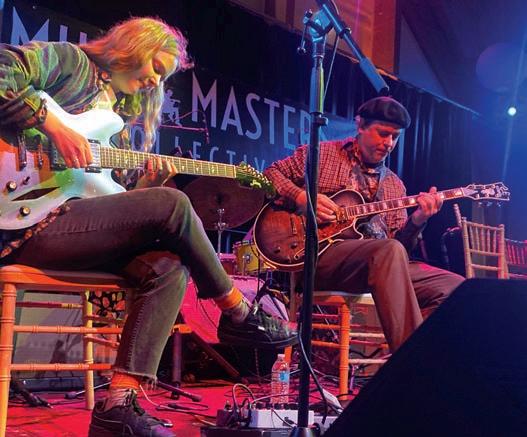
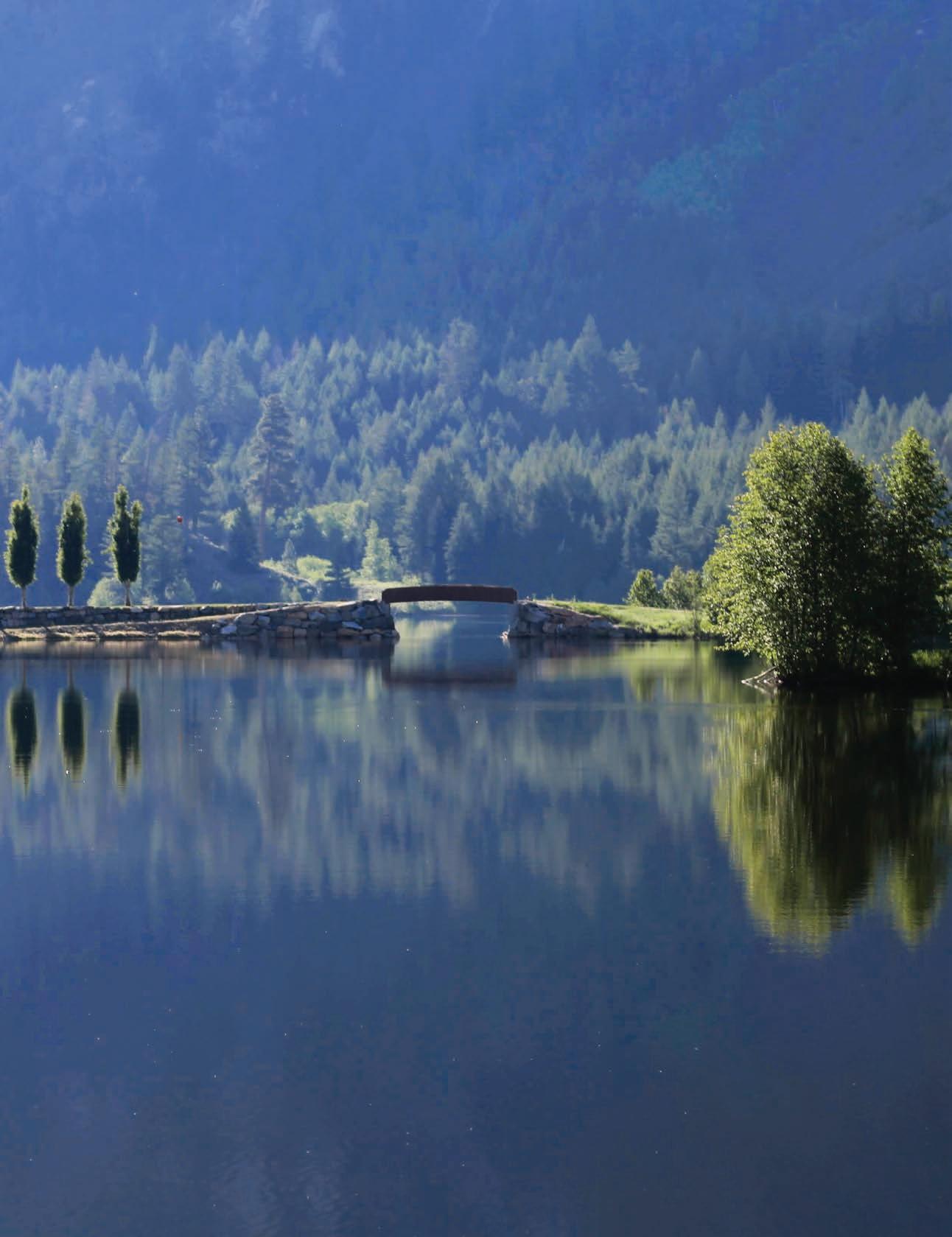
58 SPRING 2024
2024 DIRECTORY OF FESTIVALS, SCHOOLS & WORKSHOPS
Photo: Courtesy of Alternative Guitar Summit Camp



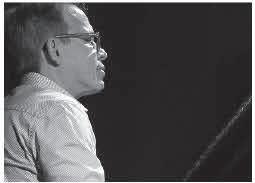

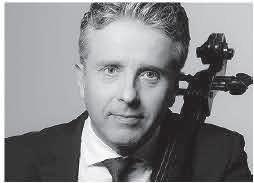
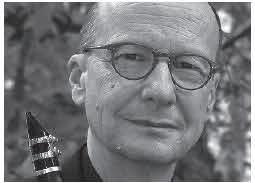



and musical leadership skills as well as chamber music techniques to elevate playing in any ensemble. Benefit from working with faculty with decades of professional performing, ensemble, and chamber music experience. Play expressively, boldly, and passionately in a unique collaborative chamber music orchestra.
New York Chamber Music Festival
YEAR-ROUND
New York City
Elmira Darvarova
United States
info@newyorkchambermusic festival.org
newyorkchambermusic festival.org
The New York Chamber Music
Festival, a charitable 501(c)(3) nonprofit organization, was founded in 2008 by violinist Elmira Darvarova and legendary cellist Janos Starker (who was the festival’s vice president until his death in 2013). Established as one of New York’s most prestigious music series, it presents free concerts and masterclasses with internationally renowned artists, in addition to free education events featuring children-composers in collaboration with the New York Philharmonic’s series “Very Young Composers.”
Pierrot Chamber Music Festival SUMMER
July 15–26
Garden City
Susan Deaver, Festival Director
AUGUST 11-22, 2024
pierrotchambermusicfestival@ gmail.com
pierrotchambermusic festival.com
Student Ages: 13–25; Pre-college and College/ Conservatory Level(s): Advanced
The Pierrot Chamber Music Festival, now in its 43rd summer season, is an intensive twoweek festival dedicated to the study and performance of chamber music in a series of master classes, educational residencies, chamber music classes and a series of informal and formal performances. Held in the beautiful facilities at Adelphi University’s Performing Arts Center, The Pierrot Consort, along with the festival’s faculty and guest artists, provide an
opportunity for both precollege and college/conservatory students to further their musical talents.
Progressive Chamber Music Festival FALL
October 18–19
New York City Sirius Quartet siriusquartet@gmail.com siriusquartet.com
“Progressive Chamber Music” is chamber music of the 21st century, not defined by genre, nor limited by the distinction between concert and popular music, made by musicians who seek to blur the lines between performer, composer, and improviser. The ninth annual Progressive Chamber Music
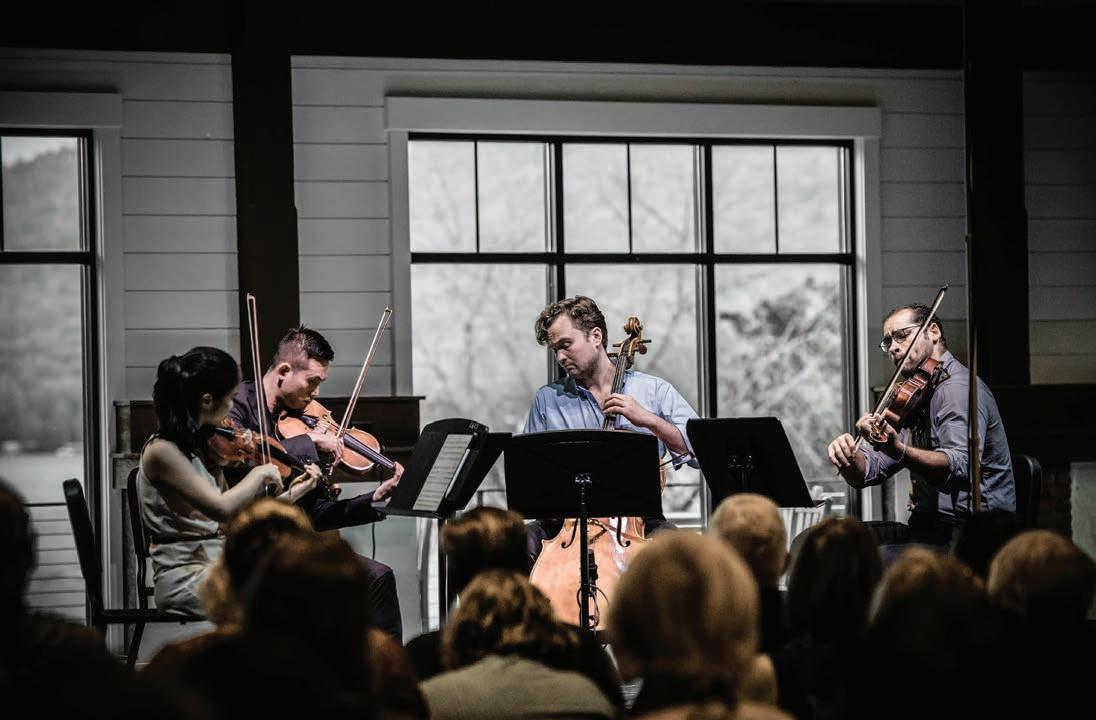
The Lake George Music Festival is a high level artist retreat for musicians, conductors and composers, set over two weeks in picturesque Lake George, New York. Each summer, the festival offers a dynamic and immersive experience for performers and patrons alike through a series of daily concerts, open rehearsals, special presentations, and more.
60 SPRING 2024
SEASON PASSES, TICKETS, AND INFO PLEASE VISIT LAKEGEORGEMUSICFESTIVAL.COM
FOR
Festival at Greenwich House Music School, curated by Sirius Quartet, will features artists and ensembles with unique identities and a shared desire to define chamber music on their own terms.
Rites of Spring Music Festival
SPRING SUMMER
April 12–August 25
North Fork of Long Island
Paolo Bartolani info@ritesmusic.org ritesmusic.org
The ninth edition of Rites of Spring Music Festival features a new season of live concerts in unconventional and extraordinary places on the North Fork and East End of Long Island, combining music, nature, and historical sites. This year, the program “Unexpected Correspondences” presents a wide spectrum of music cultures representing diverse communities and exploring the connections between Western classical musical traditions and musical cultures such as Korean, Latin American, and North America, through music events, conversations, music workshops, and cultural and educational activities. The 2024 festival calendar features musical talents such as the Ulysses String Quartet & Paolo Bartolani, the Concordian Dawn Ensemble, the Merz Piano Trio, the Sinta Saxophone Quartet, and the Mudflats String Ensemble.
North Dakota
Dakota Chamber Music
SUMMER
June 17–23
Minot
Erik Anderson j.erik.anderson@minotstateu.edu minotstateu.edu/dcm/ index.shtml
Student Ages: 13+
Level(s): High School and College Amateurs
Now in its third decade, Dakota Chamber Music continues its great tradition of making chamber music come alive each June. At DCM, the Luminus piano trio, guest faculty, and participants work together to understand and communicate in the language of music. DCM accepts applications from both pre-formed ensembles and individuals; individuals will be placed into ensembles by age and experience. Participants enjoy daily rehearsals, coaching sessions, and masterclasses, working toward a concluding performance. All rehearsals and performances take place in Minot State University’s stateof-the-art facilities and Ann Nicole Nelson Hall, one of the finest acoustic spaces in the upper Midwest. University credit is available to adult participants.
Ohio Chamber Music Connection
SPRING SUMMER
April 26, May 3, 10, 17, 18; July 8–12
Worthington
Deborah Barrett Price adm@cmconnection.org
cmconnection.org
Student Ages: 7+ Level(s): All
The mission of Chamber Music Connection (CMC) is to teach and perform chamber music at the highest level, benefiting students of all ages, backgrounds, and abilities. Our vision is to use chamber music to promote personal and musical growth and development, while building our sense of community and interconnectedness in the lives of our students. By fostering both leadership and collaboration, CMC strives to build skills not only for music, but for life.

Summer TUTTI
SUMMER
June 22–30
Granville
Cristina Dorda Soriano summertutti@denison.edu
summertutti.denison.edu
Student Ages: 15–19
Level(s): Beginner to Advanced
Summer TUTTI Performing Arts
Camp at Denison University offers talented high school musicians, dancers, and theater-makers a chance to deepen their skills while collaborating with professional artists and ensembles and peers from across the country, such as ETHEL, Third Coast Percussion, and Available Light Theatre.
Oregon
Ashland Chamber Music
Workshop
SUMMER
July 14–19
Ashland
Jenifer Carstensen acmw@sou.edu
sou.edu/academics/music/ ashland-chamber-music -workshop
Student Ages: 18+
Level(s): Advanced & Expert
Celebrating 47 years of chamber
music, ACWM has one of the largest libraries of chamber music in the west. The workshop costs $550, with a discounted rate of $275 for college students. Music educators may earn continuing education credits at no additional cost.
Pennsylvania
Adult Chamber Players Weekend
SUMMER
July 12–14
Willow Grove
Beth Dzwil
beth.dzwil@settlementmusic.org settlementmusic.org/acp -weekend-2024
Student Ages: 18+
Level(s): Intermediate to Expert
At Settlement Music School’s Adult Chamber Players Weekend, you will work with a fixed group on a single work in preparation for an optional performance. You will be coached by members of the Fairmount String Quartet and by Settlement Music School’s esteemed faculty. The weekend includes a lecture/ discussion and performance by the Fairmount String Quartet, an improvisation workshop with Dr. David Rudge of Music
61
2024 DIRECTORY OF FESTIVALS, SCHOOLS & WORKSHOPS
Chamber Music Connection
Photo: Courtesy of Chamber Music Connection
for People, and StringFlo chair yoga with live music by composer Dr. Ellen Fishman.
Bear Crossing Music Studio
SUMMER
June 24–28
New Ringgold
Simon Maurer
mauviolin@yahoo.com gabrielensemble.org
Student Ages: All
Level(s): Intermediate to Advanced
We offer a chamber music camp for strings and some wind players, with four coached sessions each day. Located in the country on a property with a stream flowing through it, there is lodging close by or you can camp on the property. We
offer a homemade lunch every day! If you are looking for a positive chamber music playing experience, give us a try.
Chamber Music Essentials
SUMMER
June 8–15
Lancaster
Jill Schultz
jschultz10026@gmail.com summertrios.org
Student Ages: 18+
Level(s): Novice to Intermediate
No matter how limited a person is initially, playing chamber music provides entry into the world of music and new social experiences. Chamber Music Essentials is a workshop designed for late-starters and emerging players to help them
acquire tools to make playing music a fun and rewarding experience. The repertoire is carefully chosen to be of high musical quality and playable, yet with enough challenge to keep things interesting— musical selections one will want to play again with others.
Dalí Quartet International Music Festival
SUMMER
July 26–August 4
North Wales
Adriana Linares adrinares@gmail.com arconetwork.org/wp/dqcf-main
Student Ages: 13+
Level(s): Intermediate to Professional
The Dalí Quartet International Music Festival is one of the
region’s leading chamber music and orchestral summer programs. Students attend faculty recitals, daily chamber music coachings and rehearsals, string orchestra rehearsals, master classes, fun social activities, and workshops. Coachings and master classes are by members of the Dalí Quartet as well as prominent guest artists from major symphonies and conservatories from across the United States.
Market Square Concerts
Summermusic 2024
SUMMER
July 13, 17, 21
Harrisburg
Peter Sirotin
info@marketsquareconcerts.org
marketsquareconcerts.org/ summermusic

62 SPRING 2024
JUNE 28 - JULY 14, 2024 Craig Hella Johnson • Jos van Veldhoven • Eric Whitacre
Wells • Paul Jacobs • Julian Perkins • Ken-David Masur John Butt • Catherine Manson • Gemma New • Alevtina Ioffe OregonBachFestival.org Bach: Ascension Oratorio • Holst: The Planets • Aaron Diehl Beethoven: Symphony No. 9 • Saint-Saëns Organ Symphony The Sacred Veil • Mozart: Mass in C Minor • and much more!
oices
OREGON BACH FESTIVAL 2024 DIRECTORY OF FESTIVALS, SCHOOLS & WORKSHOPS
Claire
Ascending
V
Market Square Concerts
Summermusic 2024 will attempt to convey the essence of Classicism, Romanticism and Modernism in music through juxtaposition of celebrated works by Mozart, Chopin, Schubert, Martinů, Turina, and Shostakovich. Three programs will highlight unique and shared features of each style, putting them in historical context, as well as examining their relevance to the contemporary experience. Performers include the Mendelssohn Piano Trio, celebrating its 25th season; Michael Stepniak, Executive Dean of Creativity and the Arts at Shenandoah University; Claudia Chudacoff, former concertmaster of President’s Own Marine Band; as well as the award-winning Schwarz and Bournaki cello-piano duo.
Rhode Island
Kingston Chamber Music Festival
SUMMER
July 24–August 4
Kingston
Anna Gray info@kingstonchambermusic.org kingstonchambermusic.org
Join us to hear the world premiere of an original work by composer Jerod Impichchaachaaha’ Tate performed by the Dover Quartet; travel across the Mediterranean (musically speaking) without leaving your seat; and enjoy the sounds of the flute, piano, mandolin, classical guitar, and other stringed instruments performing a mix of repertoire old and new. We invite musicians—many of whom have never played together before—to bring their skill, creativity, and passion to create incredible musical experiences and one-of-a-kind performances.
South Carolina
Spoleto Festival USA
SUMMER
May 24–June 9
Charleston info@spoletousa.org spoletousa.org
The 48th season of Spoleto Festival USA showcases innovative, emerging artists alongside distinguished luminaries. The season opens with the world premiere of Spoleto’s original opera Ruinous Gods with music by Layale Chaker and libretto by Lisa Schlesinger. Paul Wiancko will debut as the Charles E. and Andrea L. Volpe Director of Chamber Music, hosting 33 performances of 11 ingenious programs.
Tennessee
PRIZM Music Camp and International Chamber Music Festival
SUMMER
June 3–19
Memphis Christina Lai Christina@prizmensemble.org prizmensemble.org
Join PRIZM in discovering chamber music through the lens of diversity, equity, and inclusion. Featuring Imani Winds, Dior Quartet, and our summer camp faculty.
Texas
Austin Chamber Music Festival
SUMMER
June 7–July 14
Austin
Madeline Warner info@austinchambermusic.org
austinchambermusic.org
The Austin Chamber Music Center presents its 28th Annual Austin Chamber Music Festival this summer. The festival presents world-class ensembles and musicians, including Emerson Quartet’s Philip Setzer, Kronos Quartet’s Jeffrey Zeigler, Anton Nel, American String Quartet, Pedro Giraudo Tango Quartet, Duo Mantar, Peter Bay, Michelle Schumann, Takács Quartet, Daniel Fears, and Trio Bohémo. Concerts take place at the UT Austin Butler School of Music in Bates Recital Hall.
Austin Chamber Music Workshop
SUMMER
July 7–20
Austin
Jeni Gossard jeni@austinchambermusic.org austinchambermusic.org
Student Ages: 7+
Level(s): Intermediate to Advanced
The Austin Chamber Music Center’s Summer Workshop is a multi-week chamber music camp providing musical opportunities for musicians, youth to adult. Activities include chamber music coaching, chamber orchestra, music electives, masterclasses, and formal performances. Participants will work with leading local and worldrenowned visiting artists. Held at the University of Texas at Austin Butler School of Music. Woodwind, brass, string, and piano players welcome.
Utah
Fry Street Chamber Music Festival SUMMER
July 10–20
Logan
Emily Ezola emily.ezola@usu.edu
cca.usu.edu/music/events/ summer/fscmf
Student Ages: 14–18
The Fry Street Chamber Music Festival provides an exciting chamber music immersion experience for string players and pianists. The 10-day festival includes coaching sessions, private lessons, master classes, seminars, and performance and outreach opportunities, as well as world-class concerts given by the Festival’s distinguished faculty. Held on the stunning Utah State University campus, FSCMF students come away inspired by an extraordinary environment that super-charges their development as musicians and instrumentalists.
Torrey Chamber Music Festival
SUMMER
June 14–16
Torrey
Ada Mae Crouse adamae3@gmail.com
torreychambermusic.com
Student Ages: 3–18
Level(s): All
The Torrey Chamber Music Festival’s mission is to create intimate and inspiring musical experiences and to foster community through engagement with chamber music. With its captivating programming, roster of world class musicians, audience interaction, free community concerts, and youth education programs, TCMF is committed to making great classical music accessible to all. This year’s festival, “Stories and Legends,” will include a new interactive family concert and the beloved Mozart Clarinet quintet. Torrey Chamber Music Festival is a p rogram of the Entrada Institute, a nonprofit organization dedicated to preserving the red rock country, the Colorado Plateau, and its heritage through arts and education.
63


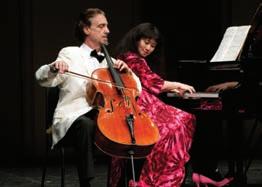
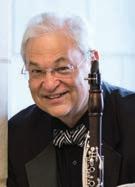
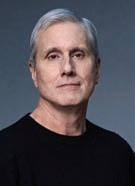
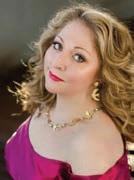

JOIN US FOR OUR 50TH ANNIVERSARY YEAR
JULY 11 – AUGUST 8, 2024
Nestled in the beautiful Green Mountains of Southern Vermont, Manchester Music Festival celebrates 50 years of premier chamber music with a season that honors its rich history and looks forward to an exciting future. Featuring world-renowned artists, emerging talents, and premieres of new works, MMF’s golden anniversary is a testament to the enduring power and beauty of music.
JENNY LIN, Executive Director
Connect with us:
WWW.MMFVT.ORG
• 802-362-1956
@mmfvt_1974 @mmfvt
Vermont
Central Vermont Chamber Music Festival
SPRING SUMMER
April 6–7; August 5–11
Randolph
Peter Sanders, Artistic Director petersvcl@aol.com cvcmf.org
This year marks the 32nd season of the festival with concerts in April and August. More information about artists and programs can be found on the website. Experience world-class music in the heart of Vermont.
Green Mountain Chamber Music Festival SUMMER
June 23–July 21
Colchester
Amanda Stenroos info@gmcmf.org gmcmf.org
Student Ages: 14–30
Level(s): Intermediate to Advanced
Green Mountain Chamber Music Festival was founded in 2004 by violinist Kevin Lawrence in the Lake Champlain and Burlington area. Now in residency at St. Michael’s College in Colchester, Vermont, the Festival brings together young string musicians from around the United States and several other countries with professional string teachers from many conservatories and universities to work together for a month each summer. Student and faculty concerts during late June and most of July offer a rich assortment of chamber music experiences to our audience members, both on campus and in the surrounding community.
Kinhaven Music School SUMMER
June 3–August 25
Weston
Tony Mazzocchi
admin@kinhaven.org
kinhaven.org
Student Ages: 10+
Level(s): Varies Based on Program
Kinhaven is a unique residential summer music camp in the rolling green hills of Weston, Vermont. Classical chamber music in a collaborative, noncompetitive environment is at the heart of our programs for children and adults.
Lake Champlain Chamber Music Festival
SUMMER
August 17–25
Burlington Area
Peter Espenshade peter@lccmf.org lccmf.org
Now in our 16th season, the Lake Champlain Chamber Music Festival is known for outstanding musicians, innovative programming, and educational activities under the leadership of violinist Soovin Kim and pianist Gloria Chien. Join us in Vermont for world-class music and our special sense of community!
Manchester and the Mountains Chamber Music Workshop SPRING
May 9–12
Manchester
Janet Hoffman mmworkshops2008@gmail.com musicallymotivating workshops.com
Student Ages: 18+
Level(s): All
A non-competitive learning and playing experience for amateur musicians. Housed in the beautiful Inn at Manchester, the program is mostly stringoriented, but also accepts some winds and piano. Groups and repetoire are assigned and sent four weeks prior to workshop. The focus is on playing chamber music repertoire authentically.
64 SPRING 2024
50
season
PhilipSetzer, ArtisticDirector Manchester Music F estival @ 50
•
•
•
•
Philip Setzer
•
David Finckel and Wu Han
Christine Goerke Sarah Kirkland Snider
David Shifrin
Lawrence Dutton
Jeewon Park
Expect many hands-on coached hours, master classes, pick-up groups, and excellent food and accommodations.
Manchester Music Festival
SUMMER
July 11–August 8
Manchester
Robin Pomerance, Festival Manager office@mmfvt.org mmfvt.org
Student Ages: 18+
Established in 1974, Manchester Music Festival (MMF) has been a beacon for classical music enthusiasts for half a century, showcasing both established artists and young talents. Nestled in the beautiful Green Mountains of Southern Vermont, MMF plays a pivotal role in the cultural enrichment of our community and beyond. The Festival celebrates its Golden Anniversary in 2024 with a curated season of more than 30 events, including performances, masterclasses, open rehearsals, talks, and outreach programs. Under the leadership of our artistic director, Philip Setzer, founder and violinist of the Emerson String Quartet, season 50 celebrates “The Romantic Journey,” a theme that cuts to the heart of how art reflects our humanity.
Point CounterPoint
Adult Chamber Workshop/ Pianos on the Point
SUMMER
August 28–September 7
Leiceseter
Jenny Beck pointcp@gmail.com pointcp.com
Student Ages: 25+
Level(s): All
The Adult Chamber Workshop welcomes string, piano, and wind players of all levels of experience. Our resident faculty
are all music teaching and performing professionals. Faculty coach both preset groups and those that apply individually.
Rochester Chamber Music Society
SUMMER
June–July Rochester
Lesley Straus lesley@rcmsvt.org rcmsvt.org
Student Ages: 5–14
Level(s): Beginner to Advanced
Summer Chamber Music Series with a one-week Suzuki Institute in July, known as Green Mountain Suzuki Institute. For strings and piano.
Vermont Music and Arts Center
SUMMER
June 30–July 21
Vermont State University, Lyndon
Judy Terwilliger, VMAC Coordinator vmacinfo@gmail.com vermontmusicandarts.org
Student Ages: 21+
Level(s): Intermediate and Advanced
Vermont Music and Arts Center (VMAC) is a magical, welcoming place for adult amateur chamber musicians to play as much as they like, or as little. Invite our coaches to play with you and play what you like. Relax in our well-stocked, coached art studio, or enjoy the majesty of Vermont’s Northeast Kingdom. We offer three one-week sessions for strings, winds, piano, and voice. Come celebrate 70 years of VMAC!
Virginia
Appalachian Chamber Music Festival Strings Chamber Music Camp
SUMMER
August 5–9
Hillsboro
Mayme Kugler manager@appalachian chamber.org
appalachianchamber.org
Student Ages: 12–18
Level(s): Intermediate to Advanced
Each day, students will spend time with the all-camp chamber ensemble and their small assigned chamber music groups. Guest musicians will stop by throughout the week for learning sessions, and students will have the opportunity to sit in on an ACMF rehearsal. The week concludes with an invited concert featuring the different groups who prepared music throughout the week. Students will receive their small-group assignments and music to begin rehearsing in early July ahead of the first day of camp. Small pre-formed groups are also welcome. Attend together and bring a piece you have been rehearsing and receive coaching—or select a new piece to explore!
Charlottesville Chamber Music Festival FALL
September 8–19
Charlottesville
Natalie Hokanson info@cvillechambermusic.org cvillechambermusic.org
Founded in 2000 by Raphael Bell and Timothy Summers, the Charlottesville Chamber Music Festival presents an annual chamber music festival in September (as well as occasional concerts throughout the year). The artistic directors invite virtuoso musicians from the United States and around the world to perform standard repertoire and contemporary works in multiple venues around Charlottesville, including
local theaters, area vineyards, art spaces, and churches. Outreach events include a free Community Concert and school programs.
GreenSpring
Summer Music Institutes
SUMMER
July 15–26
Richmond
Trey Nunnally academy@greenspringmusic.org greenspringmusic.org/summer-1
Student Ages: 8–22
Level(s): Beginner/ Intermediate; Advanced
GreenSpring Summer Music Institutes attract students from around the world for intensive music study in Richmond, Virginia. Two weeks of programming feature focus areas including chamber music, piano, harp, choir, and strings (violin, viola, cello, bass). Opportunities are available for students in two tracks: Track 1 for beginner/intermediate students, and Track 2 for advanced students, by audition only. Options include half-day and full-day sessions, as well as overnight boarding options. Summer is the perfect time to be inspired by world-class faculty, hone practice and performance skills, and have a great time making music with new friends and fellow musicians.
Northern Neck Chamberfest
SUMMER
June 24–30
Kilmarnock
Moises Cunha
moisesbonella@gmail.com
northernneckorchestra.org/ chamberfest-2024
Student Ages: 18+
Level(s): Intermediate and Advanced
Hosted by the Northern Neck Orchestra since 2022, the Northern Neck Chamberfest is a summer festival of chamber
65
2024 DIRECTORY OF FESTIVALS, SCHOOLS & WORKSHOPS
KILLINGTON MUSIC FESTIVAL
2024 RESIDENCY *June 23 – July 19
STRINGS • WINDS • BRASS • PIANO • GUITAR
solo & chamber performance opportunities
• masterclasses • lessons • coachings *various sessions available
DANIEL ANDAI, Artistic Director

music featuring instruction, performance, and community outreach. Drawing a faculty of internationally recognized musicians from across the country, the Northern Neck Chamberfest provides an exceptional week of chamber music masterclasses, personal coaching, and concert opportunities for aspiring musicians. Chamberfest fills a special need for participants who seek to expand their individual skills, learn new music, and build confidence in their abilities through in-depth instruction by professionals and valuable interaction with other students in a welcoming and enjoyable environment.
Virginia Arts Festival
SPRING SUMMER
April 13–June 23
Coastal Virginia Robert W. Cross info@vafest.org vafest.org
The largest performing arts organization in Southeastern Virginia, the Virginia Arts Festival (VAF) has presented great performers from across the globe since 1997. Under the direction of Perry Artistic Director Robert W. Cross, VAF has presented world premieres and new productions of classical music, dance, and theater from some of today’s most influential composers, choreographers, and playwrights. The Festival’s leadership team also includes: Olga Kern, director of chamber music; and Rob Fisher, artistic advisor for musical theater and American songbook.
Williamsburg Youth Orchestra Summer Music Chamber Camp Concert SUMMER
August 9
Williamsburg Tanya Song manager@wyomusic.org wyomusic.org
Student Ages: 8–18
Level(s): Beginner to Advanced
Join us for an enchanting afternoon at WYO’s Summer Chamber Music Camp Concert! Experience the young musicians’ impressive performances of seven ensembles, including trios, quartets, and quintets, weaving together the harmonious melodies of strings, wind, and brass instruments. All are invited to this free and open-to-the-public event at the Williamsburg Presbyterian Church at 3:00 PM.
66 SPRING 2024
IN THE MOUNTAINS
YEARS
24/2025 BROOKLYN RIDER WILD UP KRONOS QUARTET BANG ON A CAN ALL-STARS AUSTRALIAN CHAMBER ORCHESTRA www.dlartists.com
MUSIC
kmfest.org kmfest@kmfest.org I 802.773.4003 42
20
info@dlartists.com
Washington
Chamber Music Guild
Summer Student Festival
SUMMER
July 8–13
Seattle
Virginia Wright
vwright@chambermusicguild.org chambermusicguild.org
Student Ages: 13–24
Level(s): Intermediate to Advanced
An incomparable week-long musical learning experience for middle school, high school, and college students, our festival presents a unique opportunity to explore chamber music by working with a professional string quartet. String and piano students develop their confidence and individual expressive skills through multiple daily coaching sessions, masterclasses, and theater arts enrichment. The application includes a video audition.
Midsummer Musical Retreat
SUMMER
July 29–August 4
Walla Walla
Gennie Winkler
midsummer@musicalretreat.org musicalretreat.org
Student Ages: 18+
Level(s): All
Midsummer Musical Retreat (MMR) provides a noncompetitive but challenging curriculum for adult singers and instrumentalists. The week-long festival workshop includes orchestra, band, string orchestra, chorus, jazz big band, chamber ensembles, and electives in a hospitable, “retreat” atmosphere. The strength of MMR lies at the exciting intersection of a committed, supportive, professional faculty, thrilling repertoire, and enthusiastic campers.
Orcas Island Chamber Music Festival
SUMMER
August 2–17
Orcas Island
Anita Orne info@oicmf.org oicmf.org
The 27th season of the Orcas Island Chamber Music Festival once again brings the finest musicians from across the country and beyond to Orcas Island for 10 mainstage concerts (in person and livestream) plus concerts across the island and on neighboring Lopez Island, a Children’s Concert, Open Rehearsal for Seniors, and many other events.
Puget Sound Chamber Music Workshop
SUMMER
July 8–12
Seattle
Miriam Shames, Director pscwdirector@musiccenter nw.org
musiccenternw.org/workshops
Student Ages: 18+
Level(s): Intermediate to Advanced
Puget Sound Chamber Music Workshop offers an array of ways to experience playing chamber music—from concentrated study to sight reading with fantastic faculty. Participants play in three arranged groups: Group A studies one work and meets daily; Groups B and C meet for two days each, with flexibility to sight read, explore repertoire, and play with faculty. Daily activities also include masterclasses, informal run-throughs, faculty presentations/discussions, morning singing and a final program by participants.
Open to individuals only; no pre-formed groups.

West Virginia
Appalachian Chamber Music Festival Adult Intensive Chamber Music Workshop
SUMMER
August 3–4
Charles Town
Mayme Kugler manager@appalachian chamber.org
appalachianchamber.org/ education
Student Ages: 18+
Level(s): All (Intermediate to Advanced Recommended)
Open to pre-formed groups or individuals who will be matched with partners, this two-day workshop offers musicians the chance to spend time with their ensemble and receive coaching from our professional ACMF musicians. Activities may also include individual one-on-one work with a coach, group work to develop and refine skills needed by small ensemble musicians, and more! The weekend concludes with an invited concert for family and friends.
Wisconsin
Bach Dancing & Dynamite Society
Summer Chamber Music Festival
SUMMER
June 7–23
Madison
Samantha Crownover crownover@bachdancingand dynamite.org bachdancing.org
This summer Bach Dancing & Dynamite Society celebrates 33 years. Let’s see . . . 33 1/3 RPM records . . . LPs, long playing . . . we’re calling it “High Fidelity.” We’ve always been faithful to the highest standards of performance, bringing you riveting performances with luminous sound. “Fidelity” also characterizes our relationship with you, our enthusiastic audience. We are proud to be one of Madison’s longplaying musical institutions with nine concerts in the Hamel Music Center.
67
OF FESTIVALS, SCHOOLS & WORKSHOPS
2024 DIRECTORY
Orcas Island Chamber Music Festival
Photo: Barry Carlton



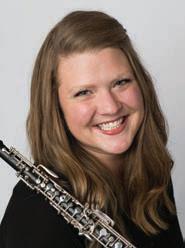

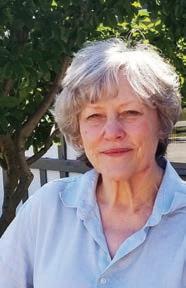

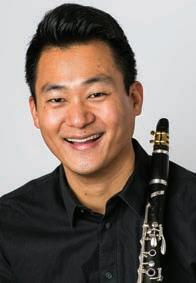
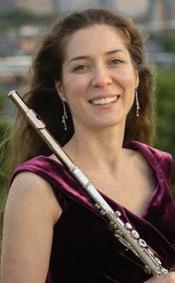

In scenic Door County, Wisconsin, Midsummer’s Music presents an enticing variety of chamber music for wind, strings, and piano, drawing on the extraordinary talents of musicians from Lyric Opera Chicago, the symphonies of Chicago, Milwaukee, Detroit, and Ravinia Festival, and members of the Pro Arte Quartet.
2024 Season
June through October
Madeline Island Chamber Music
SUMMER
June 15–July 28
La Pointe Alyssa Saint micm@macphail.org micm.org
Student Ages: 14+
Madeline Island Chamber Music is an intensive chamber music summer program for wind quintet, string quartets, and piano chamber music. Each summer, a rotating faculty of renowned ensembles and individual instructors join us for a unique, retreat-like experience. Programs take place June 15–22 (winds); June 23–July 14 (strings); June 23–July 28 (fellowship strings); and July 14–28 (fellowship piano).
Madison Bach Musicians Summer Chamber Music Workshop
SUMMER
July 9–12
Madison Kangwon Kim madisonbachmusicians.manager @gmail.com
madisonbachmusicians.org/ summer-chamber-music -workshop
Student Ages: 13+ Level(s): Beginning to Advanced
South Beach
South Beach Up North SUMMER
July 25–August 3
Wausau, Marshfield & Minocqua
Michael Andrews
mandrews1002@icloud.com sobechamberensemble.org
North Central Wisconsin’s 18th annual summer chamber music festival features Mendelssohn String Quartet no. 2 in A minor, op. 13; Shostakovich String Quartet #8 in C minor, op. 110; Beethoven Piano Trio no. 1 in E-flat major, op. 1 no. 1; Beach Piano Trio in A minor, op. 150; and an appearance on Wisconsin Public Radio’s Rt. 51 with Shereen Siewert. Sheena Gutierrez, violin; Rochelle Pearson, violin; Angela Kratchmer, viola; Michael Andrews, cello; and Rie Tanaka, piano.
INTERNATIONAL
Canada
BISQFest SUMMER
August 30–September 1
Banff, Alberta, Canada
Lisa Ramsey bisqc@banffcentre.ca
Banff International String Quartet Festival is a three-day festival showcasing the finest in international classical music to audiences through a completely immersive experience. Started in 2017, BISQFest commenced in non-competition years. Led by Barry Shiffman, director of the Banff International String Quartet Competition, the festival features competition alumni alongside special guests exploring repertoire from across the centuries. midsummersmusic.com •
Madison Bach Musicians Summer Chamber Music Workshop offers a unique opportunity for amateur musicians to participate in extensive chamber music playing as well as informative lectures, technique classes, and large group ensembles. We focus on performance of early music from the Renaissance, Baroque, and Classical periods. It is our mission to provide a place where amateur chamber music lovers can come together and work intensely for a week with highly skilled faculty.
68 SPRING 2024
920-854-7088
Session Sonates Violon-Piano
SUMMER
June 16–22
Saguenay-Lac-Saint-Jean, Quebec, Canada
Violaine Melançon violaine@duom.ca campmusical-slsj.qc.ca/project/ sonates-violon-piano/
Student Ages: 16–22
Level(s): Advanced
Under the auspices of the Camp Musical Saguenay Lac-Saint-Jean, Duo M (Violaine Melançon and Meagan Milatz) with colleagues
Uliana Drugova and Carson Becke, run a unique, intensive, and intimate bilingual program dedicated to the art of violin-piano sonata playing. Daily coachings, private lessons, and interactive group classes, ending with a public concert. Individuals and pre-formed duos can apply; scholarships are available. The location is extraordinary, and the atmosphere is both stimulating and convivial.
Czech Republic
La Pellegrina:
Reicha’s Requiem, for orchestra, choir and soloists
SUMMER
July 25–August 4
České Budějovice, Czechia Dirkjan Horringa info@pellegrina.net pellegrina.net/EN/
Student Ages: 10+
Level(s): Advanced to Professional
This program is for choral and solo singers, strings, winds and pianists; existing chamber music ensembles are welcome. Intensive coaching by experienced teachers: Martina Bernášková, Petr Bernášek, Pavel Hořejší, Dirkjan Horringa, Libor Nováček, Mitchell Sandler, Rudolf Sternadel, Jitka Vlašánková and others. Everyone plays in two
pre-formed chamber music ensembles.
France
Zodiac Music Academy & Festival
SUMMER
July 2–15
South of France
Kliment Krylovskiy info@zodiacfestival.com zodiacfestival.com
Student Ages: 17–35 Level(s): Advanced High School/College/ Pre-professional
The Zodiac Music Academy & Festival invites students and young professionals to spend 12 days of intense musical training and performing in one of the most stunningly beautiful corners of the world: the South of France, Côte d’Azur. With a special emphasis on chamber music, this highly personal course offers young musicians the opportunity to explore the French school of music-making via masterclasses with renowned French guest artists, perform for European audiences, and be inspired by an international faculty, all in an informal setting.
Italy
Altschuler Summer Music Institute
SUMMER
July 15–28
Premilcuore, Italy
Emil Altschuler altschulersummermusicinstitute @gmail.com altschulersummermusic institute.com
Student Ages: All Level(s): All
Altschuler Summer Music Institute will be hosted in Premilcuore, Italy, open to all
orchestral instruments, voice, guitarists, pianists, composers, and conductors. It is inclusive, diverse, and focuses on the students’ betterment and creates opportunities for their musical development. Students receive private lessons, chamber coachings, orchestra, access to all masterclasses, seminars, and many performance opportunities, and collaborate with principals of the Bologna Philharmonic. Teachers hail from The Juilliard School, New England Conservatory, Royal College of Music, Bologna Conservatory, and pupils of the Leopold Auer legacy.
Innovation in Chamber Music at Accademia Chigiana SUMMER
August 5–10 Siena, Italy
B. Valdambrini allievi@chigiana.it chigiana.org/en/innovation -in-chamber-music-2024
Student Ages: Under 35 Level(s): Advanced
This course for classical, jazz, and world musicians—both soloists and pre-formed ensembles—is taught by renowned Grammynominated classical/world artist David Krakauer. It is designed to help musicians broaden their horizons, expand their concepts of multifaceted programming, and find their own unique voice both as soloists and ensemble players. Joining Krakauer is longtime collaborator of Kathleen Tagg. Together they have created a highly personal, genre-crossing body of work, appearing on leading stages including the Boulez Saal in Berlin, Carnegie Hall in New York, and Théâtre du Châtelet in Paris.
Ischia Chamber Music Festival SPRING SUMMER
May 5–July 27
Ischia, Italy
Aldo de Vero
aldo@ischiachambermusic.org ischiachambermusic.org
Student Ages: 18+
Level(s): Intermediate to Advanced
Have you ever played in paradise? At the Ischia Chamber Music Festival, you will experience the perfect mix of music and relaxation in the heart of one of Italy’s most breathtaking locations. Join a supportive, accepting, international community fostered for 20 years. You will be coached by professionals with decades of experience, immersed in the beautiful sights and smells of Italy. Email now to reserve your spot—only a few remain.
Lago Maggiore Festival
SPRING WINTER
May 5–19; December 11–15
Verbania, Lago Maggiore, Italy
Christian Cocolicchio
christian.cocolicchio@gmail.com lagomaggiorefestival.it
Student Ages: 8+
Level(s): All
Dedicated to chamber music, the Lago Maggiore Festival IX edition is open to all participants and the following instrumentation: Classical guitar, violin, violoncello, pianoforte, flute, voice (canto lirico). Enjoy chamber music meetings and concerts in the beautiful city of Verbania at the Lago Maggiore.
Orfeo Music Festival SUMMER
July 2–13
Vipiteno, Italy
Maria Gomez
info@orfeomusicfestival.com
https://www.orfeomusic festival.com
Student Ages: Pre-college to Adult
Level(s): All
Orfeo Academy Program, held in the enchanting Italian Alps, provides standard classical repertory training with world-
69
2024 DIRECTORY OF FESTIVALS, SCHOOLS & WORKSHOPS
renowned performers and teachers to students of piano, strings, woodwinds, brass, and voice.
Students have the opportunity to attend a dazzling array of professional festival concerts and to perform solo and chamber repertoire.
Tuscany Adult Amateur Cello Workshop
SUMMER
July 8–22
Cortona & Tuscany, Italy
Peter Lewy
PeterLewyCellist@gmail.com tuscanycelloworkshop.com
Student Ages: 17+
Level(s): All
Develop your playing and learn in a supportive, friendly atmosphere amongst scenic splendor. For more than 25 years, cellist Peter Lewy has run workshops dedicated to helping amateur adult cello players improve their skills. This year he will be offering his highly acclaimed workshop in beautiful Tuscany, Italy. Students will practice and play with others up to 12 hours a day. A professional pianist is available for exploring the repertoire.
Tutti Cambristi
SUMMER
June 22–23
Lodi, Italy
Clarice Zdanski vicepresidente@aimamusic.it aimamusic.it/workshop-di -musica-da-camera-tutticambristi-2024
Student Ages: 18+
Level(s): Intermediate to Professional
The workshop is open to amateur musicians, individuals, and pre-formed groups of three or more. For all groups, activities are scheduled in three-hour shifts, including 90 minutes with a tutor and 90 minutes for independent study. On Saturday evening after class, there will be
a party—a chance to meet other people and play more pieces in a collective play-in. The workshop ends on Sunday with a concert open to family and friends.
Netherlands
Chamber Music Atelier Delft
SUMMER
July 24-28
Delft, The Netherlands info@kamermuziekateliers.nl kamermuziekateliers.nl
Student Ages: 6+
Level(s): All
An intensive, five-day chamber music course for string players, pianists, wind players, and singers in the unique ambiance of the Delft. The Festival comprises inscription as ensemble or individually, daily ensemble lesson(s) and rehearsals, improvisation, folk music workshops, jamsessions, free-play, street music activities, and final concerts with additional opportunities to perform. Tutors include Mirsa Adami, Jelte Althuis, Pavel Fischer, Donald Grant, Raaf Hekkema, Sidonie Riha, and Charles Watt.
La Pellegrina
Baroque music in 415 Hz: Vivaldi’s Venetian Vespers
SUMMER
August 11–17
Klooster Nieuw Sion, The Netherlands
Dirkjan Horringa info@pellegrina.net pellegrina.net/EN/baroque/ index.php
Student Ages: 10+
Level(s): Advanced to Professional
For: singers (soloists and very experienced choral singers), instrumentalists (baroque strings,
viola da gamba, recorder/traverso, baroque oboe, baroque bassoon, harpsichord/organ, theorbo; period instruments only, tuning pitch 415 Hz). With Dirkjan Horringa (singers and artistic direction), Femke Huizinga (orchestra, violin), Hanna Lindeijer (baroque winds), Ricardo Rodríguez Miranda (viola da gamba, cello, double bass, baroque dance), Mitchell Sandler (singers), and Edoardo Valorz (basso continuo). Central works for all: a Venetian Vesper for the Virgin, composed of works by Vivaldi (including his Magnificat), Galuppi, and Cavalli. Baroque chamber music every morning for instrumental, vocal, or combined vocal-instrumental ensembles.
Switzerland
Festival of Chapels Chamber Music Course SUMMER
July 20–29
Blatten bei Naters, Valais, Switzerland
Gwilym Hooson soundsoftrusera@gmail.com festivalofchapels.com
Student Ages: 14–24
Music making surrounded by the beauty of the Swiss Alps. The course aims to encourage and confirm musical friendships, where sharing is vital to the outcome. All string instruments welcome, and woodwinds, too.
United Kingdom
Basically Quartets, Opus 1 and Opus 2 SUMMER
Opus 1: August 8–13; Opus 2: August 15–20
Penmanemawr, North Wales, United Kingdom
Christine Gale Harrison info@basicallyquartets.net basicallyquartets.net
Student Ages: 18+ Level(s): Intermediate+
At Basically Quartets, you will enjoy workshops and lectures designed to encourage and enlighten, a high tutor-toparticipant ratio, and an intimate, supportive atmosphere, all set in an idyllic location in North Wales. If you are an amateur adult string player passionate about chamber music, interested in improving your skills, and want to discover more about the nuts and bolts of chamber music, come and immerse yourself in learning and music-making at Basically Quartets.
Virtual
Online Solo Strings Intensive SPRING SUMMER
May 24–June 2; August 9–18
Alyssa Tong alyssa@stringinsiders.com stringinsiders.com
Student Ages: 15–28
Level(s): Pre-professional
The Online Solo Strings Intensive (OSSI) is a 10-day program for classical music students preparing for serious study in violin, viola, cello, and double bass. Students will take part in daily workshops/seminars as well as receive private lessons, watch or participate in masterclasses, and play in studio classes. The Intensive’s goals are not only to expand the musical knowledge and prowess of each participant, but also to deepen their understanding of classical music as well as connect serious musicians across the globe. OSSI is conducted online, significantly reducing costs to study intensely with the best professors in the United States.
70 SPRING 2024
2024 DIRECTORY OF FESTIVALS, SCHOOLS & WORKSHOPS




71 TICKETS ON SALE NOW! WEEKLY NEWS FOR THE ENSEMBLE MUSIC PROFESSIONAL Chamber Music America
place
BE SEEN IN
To
your digital ad in an upcoming issue, contact Brenden O’Hanlon at bohanlon@chambermusicamerica.org. Arrive in the inboxes of over 8,000 performers, concert presenters, artist managers, educators, composers, and ensemble music enthusiasts!
CMA Scores
From Jon Irabagon’s
Recharge the Blade
(2020)
For soprano saxophone, trombone, piano, bass, and drums
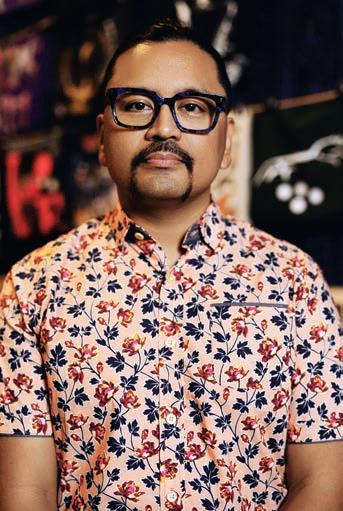
Jon Irabagon describes 2020, when he composed his Recharge the Blade suite, as a “pretty dark period.”
He laughs ruefully at how those distressing months affected his mindset. In the face of the COVID-19 pandemic, the government’s response to it, and mounting tensions around social issues, the saxophonist and bandleader says, “I became fascinated with how ingenious humans are in coming up with ways of killing each other. I had to give it up for how imaginative people from every culture have been in devising new, horrible, scary, intimidating, and merciless ways to warn their enemies to stay away.
As I’m thinking about the different instruments of destruction that have been used over history, I began envisioning that, in playing the soprano saxophone, I’m wielding this thing like a sword.”
However dark his inspiration, the nine-part suite he composed, Recharge the Blade, ended up energetic and, for the most part, uplifting. That suite forms the majority of Irabagon’s most recent release, which bears the same name. And it is the third installment of his “Outright!” trilogy, which involved one album devoted to each of three saxophones— alto, tenor, and soprano.
“I have a love-hate relationship with the soprano saxophone,” he says. “For me, it’s the most challenging of the horns. It’s untamable. You have to spend serious time on it just to make it functional. I’ve gone through spurts where I practice it for months, but then I think, ‘What am I doing this for? I hate this instrument.’ So I put it away. But a few months later, I realize I owe it to myself and the horn to re-examine it.” In that way, this suite
also reflects a recharging of Irabagon’s commitment to this instrument.
For Irabagon, the titular section, the sixth in the suite, is the “highlight” of the work. (A sparkling performance of the piece can be found on YouTube.)
Written with the members of his working band—with Matt Mitchell on keyboards, Chris Lightcap on acoustic and electric basses, and Dan Weiss on drums—in mind, the piece also features a prominent trombone part played by Ray Anderson, who is a longtime hero for Irabagon.
Described by Irabagon as “a fast, circus-like thing,” this section, the opening of which is shown here, balances his penchant for intricate writing with personal improvisations from all involved. Its structure and harmony are guided by a variation on the chord progression found in George Gershwin’s “I Got Rhythm,” which served as a template for much of jazz composition during bebop’s nascent period.
“The melody uses the iii-VI-ii-V-I progression throughout,” he says, “with the tonal centers moving from Bb to A to Db to B to C, and with stop-time rhythms, extended bars, and chromatic and hectic melodies hiding the sound of the transitions and key changes.” The solo section is constructed, he says, “to enable the soloist to use the actual chord changes, the general tonal center, or to veer off into a freer, chromatic world.” Within this scheme, Irabagon relied on his bandmates’ familiarity with both a fast-swing feel and Gershwin’s form as well as “their overall aesthetic of boundary pushing and no-net approach to improvising.”
72 SPRING 2024
Recharge the Blade has been made possible with support from Chamber Music America’s New Jazz Works program funded through the generosity of the Doris Duke Foundation.
Photo: Courtesy of the Artist
73 & ? & ? # # 4 4 4 4 4 4 4 4 Soprano Sax Trombone Double Bass ∑ U ∑ U ∑ U ∑ U Open drum solo Up Swing/Circus Vibe Œ ˙ œ Œ ˙ œ Œ . | Œ . ˙ b B b B b A œ œ n œ # œ œ œ b œ œ ˙ ˙ # œ œ b œ n œ œ œ b œ œ ’ ’ ’ ’ C -7 F 7#9 C -7 F 7#9 œ œ œ # œ œ œ œ n œ ˙ ˙ b œ œ œ # œ œ œ œ b œ ’ ’ ’ ’ D -7 G 7b9 D -7 G 7b9 & ? & ? # # S. Sx. Tbn. D.B. 5 w 5 ˙ ˙ b 5 ’ ’ ’ ’ 5 ’ ’ ’ ’ C -7 F 7b9 C -7 F 7b9 w ˙ ˙ ’ ’ ’ ’ ’ ’ ’ ’ D -7 G 13 D -7 G 13 ∑ ˙ b ˙ ’ ’ ’ ’ ’ ’ ’ ’ C -7 F 7#11 C -7 F 7#11 Œ ˙ # œ # Œ ˙ # œ Œ | œ œ # Œ ˙ # œ # F # 7 F # 7 œ # œ œ n œ œ # œ œ # œ œ œ # # œ œ œœ b b œ n œ œ # œ œ B 7 B 7 Recharge the Blade Irabagon © 2020 F Magellan Music (ASCAP) C Piano CMA Scores ■
74 SPRING 2024 & ? & ? # # S. Sx. Tbn. D.B. 10 Œ ˙ n œ 10 Œ ˙ b œ n 10 Œ . | 10 Œ . ˙ F 7#9 F 7#9 w . ˙ b œ œ ’ ’ ’ ’ ’ ’ ’ ’ E + 7 E + 7 w . ˙ b œ œ n ’ ’ ’ ’ ’ ’ ’ ’ w . œ b J œ ˙ b ’ ’ ’ ’ ’ ’ ’ ’ w w ’ ’ ’ ’ ’ ’ ’ ’ & ? & ? # # S. Sx. Tbn. D.B. Œ ˙ œ # 15 Œ ˙ # œ 15 Œ . | 15 Œ . ˙ A A B œ # œ œ # œ œ # œ n œ œ # ˙ b ˙ n œ # œ œ # œ œ # œ n œ œ # ’ ’ ’ ’ B -7 E 7#9 B -7 E 7#9 œ œ # œ œ n œ œ œ n œ ˙ ˙ b œ œ # œ œ b œ œ œ b œ ’ ’ ’ ’ C -7 F 7b9 C -7 F 7b9 œ œ # œ œ # œ œ n œ œ n ˙ ˙ b œ œ # œ œ # œ œ b œ œ b ’ ’ ’ ’ C # 7 F # 7 C # 7 F # 7 2 Recharge the Blade
CMA Scores
■
75 & ? & ? # # 4 6 4 6 4 6 4 6 4 4 4 4 4 4 4 4 S. Sx. Tbn. D.B. Ÿ~~~~~~~~~~~~~~~~~~~~~~~~~~~~~~~~~~~~~~ 19 w b 19 ˙ ˙ b 19 ’ ’ ’ ’ 19 ’ ’ ’ ’ D #m7b5 A b 7 D #m7b5 A b 7 w ˙ ˙ ’ ’ ’ ’ ’ ’ ’ ’ D -7 G 9 D -7 G 9 w # ˙ ˙ b ’ ’ ’ ’ ’ ’ ’ ’ C #-7 F # 7 C #-7 F # 7 Œ ˙ œ Œ ˙ œ b Œ . | Œ . ˙ F 7 F 7 œ # œ œ n œ n œ œ b œ œ b œ n œ œ b œ n œ œ # œ œ b œ œ n n œ œ b œ œ # œœ b œ b œ n œ œ b œ n œ B b 7 & ? & ? # # 4 4 4 4 4 4 4 4 S. Sx. Tbn. D.B. 24 Œ ˙ n œ n 24 Œ . ˙ 24 Œ . | 24 Œ . ˙ b E b 7 E b 7 w w b ’ ’ ’ ’ ’ ’ ’ ’ E 7 E 7 w w ’ ’ ’ ’ ’ ’ ’ ’ F 7 F 7 w w b ’ ’ ’ ’ ’ ’ ’ ’ F # 7 F # 7 w w ’ ’ ’ ’ ’ ’ ’ ’ G 7 G 7 3 Recharge the Blade & ? & ? # # 4 6 4 6 4 6 4 6 4 4 4 4 4 4 4 4 S. Sx. Tbn. D.B. Ÿ~~~~~~~~~~~~~~~~~~~~~~~~~~~~~~~~~~~~~~ 19 w b 19 ˙ ˙ b 19 ’ ’ ’ ’ 19 ’ ’ ’ ’ D #m7b5 A b 7 D #m7b5 A b 7 w ˙ ˙ ’ ’ ’ ’ ’ ’ ’ ’ D -7 G 9 D -7 G 9 w # ˙ ˙ b ’ ’ ’ ’ ’ ’ ’ ’ C #-7 F # 7 C #-7 F # 7 Œ ˙ œ Œ ˙ œ b Œ . | Œ . ˙ F 7 F 7 œ # œ œ n œ n œ œ b œ œ b œ n œ œ b œ n œ œ # œ œ b œ œ n n œ œ b œ œ # œœ b œ b œ n œ œ b œ n œ B b 7 & ? & ? # # 4 4 4 4 4 4 4 4 S. Sx. Tbn. D.B. 24 Œ ˙ n œ n 24 Œ . ˙ 24 Œ . | 24 Œ . ˙ b E b 7 E b 7 w w b ’ ’ ’ ’ ’ ’ ’ ’ E 7 E 7 w w ’ ’ ’ ’ ’ ’ ’ ’ F 7 F 7 w w b ’ ’ ’ ’ ’ ’ ’ ’ F # 7 F # 7 w w ’ ’ ’ ’ ’ ’ ’ ’ G 7 G 7 3 Recharge the Blade CMA Scores ■
76 SPRING 2024 ■ CMA Scores & ? & ? # # . . . . . . . . S. Sx. Tbn. D.B. Œ ˙ b œ 29 Œ ˙ b œ b 29 Œ | Û 29 Œ ˙ b œ D b D b C œ b œ n œ œ b œ œ b œ n œ b œ œ b œ œ b b œœ n œ b œ b œ n œ b œ n Œ ˙ œ b Œ ˙ b œ Œ | Û Œ ˙ b œ b F #Maj7 F #Maj7 œ Œ Ó œ Œ Ó Û Œ Ó œ Œ Ó A 7 A 7 Œ ˙ b œ Œ ˙ b œ b Œ | Û Œ ˙ b œ D b D b & ? & ? # # . . . . . . . . S. Sx. Tbn. D.B. 34 œ b œ œ n œ 34 œ œ œ b œ n 34 œ œ b œ œ œ œ b b œœ n 34 œ b œ n œ b œ n w b w b ’ ’ ’ ’ ’ ’ ’ ’ B b7#9 A b7#9 A b7#9 A b7#9 Improvise 1st X Improvise 2nd X and continue... w w b ’ ’ ’ ’ ’ ’ ’ ’ w n ’ ’ ’ ’ ’ ’ ’ ’ ’ ’ ’ ’ G # 7 F # 7 F # 7 F # 7 w b ’ ’ ’ ’ ’ ’ ’ ’ ? ’ ’ ’ ’ 4 Recharge the Blade
BORROMEO
JULY 22 - AUGUST 5, 2024
ALTDORF, SWITZERLAND

Music Brings us Together!
The Borromeo Music Festival is an exhilarating music-making and learning experience in the majestic Swiss Alps. Nestled in the idyllic town of Altdorf near Lake Lucerne, Borromeo is in a one-of-a-kind setting where talented young musicians thrive and bond with the support of an internationally acclaimed artist faculty.
APPLY NOW!
Application Deadline: APRIL 15 or until filled
INSTRUMENTAL PROGRAM
Individual lessons
Chamber music coachings
Performance classes
Masterclasses
Solo & chamber music concerts

STRING FACULTY
Lina Bahn
Lorenz Gamma
Juan-Miguel Hernandez
Ben Hong
Joan Kwuon
Vicki Powell
Sæunn Thorsteinsdóttir
PIANO FACULTY
Enrico Elisi
Jean-Louis Haguenauer
Ming Tsu
Amy Yang

MUSIC FESTI VAL
Angela Answers
Have a question about how to move forward in your professional or creative life? Email angelaanswers@chambermusicamerica.org.
Whatever Happened to My Summer Break?
Dear Angela: Every summer I travel to and perform in three festivals. One of them is my own, and includes a host of administrative and interpersonal duties. It’s a lot, and though I love most of this, I end up feeling totally depleted. Any suggestions?
I’m exhausted just hearing what you pack into your summers!
When we’re young, being busy may feel just right. We’re out to “prove” ourselves and we want to build our bio with performance credits and noteworthy projects. But eventually, we start to consider our quality of life. And since COVID, musicians of all ages have been rethinking their priorities.
How we use our time and attention matters
Angela Myles Beeching is a career consultant and the author of Beyond Talent: Creating a Successful Career in Music. Angela works with individuals, ensembles, and organizations to facilitate positive change.

. . . because these are our most precious resources. Summer is especially important because it’s prime time for renewing body, mind, and spirit. This can happen through traditional R&R, like being more physically active and connected to nature, or spending quality time with family and friends. Or it can be a time to recharge your inspiration, such as by reading and dreaming, seeing films and plays, experimenting with fresh ideas, planning projects for the coming year, and clarifying goals—for your artistry, your career, and your life.
Even during the busy summer festival season, it’s possible to work some of these renewal activities into your schedule. But you need to prioritize this to make it happen. That means turning off screens and interacting with people, nature, art, and your inner world. In other words, connecting with life itself.
And if the festival workload is so hectic that the stress erases the benefits of your renewal activities, then it’s time to rethink your commitments.
BY Angela Myles Beeching
The real reasons we stay busy
See which of these fit. You may be . . .
• Afraid to say no and disappoint others, or worried you won’t be invited back
• Unwilling to delegate tasks and responsibilities (especially with our own festival)
• Uncomfortable with change, so you stick with what’s familiar
• Perfectionistic: you work harder and longer instead of working smarter
• Reluctant to negotiate for a better schedule or lighter workload, for fear of being regarded as “difficult”
• Secretly proud of how busy you are— believing that being busy is a badge of honor, as though there’s a prize for sacrificing your wellbeing for your work
Focus on the long-term
In the end, it’s not about how many concerts you play, how much money you make, or how much applause you get.
In the long-term, it’s about living a life committed to ongoing artistic growth. So, if you were to prioritize your own artistic growth, how would you choose to spend this summer? What changes would you make in how you spend your days and weeks? What would you do differently to enhance your artistic growth and wellbeing?
Would you play fewer concerts or teach fewer students? Play different repertoire or take on different projects? Work in more time for friends and family? Actively seek out new inspiration? Or make time to read, swim, hike, and fall in love with life again?
In the end, summertime—and life itself—is short. Plant what you need to make your summers into a garden of artistic growth.
End
Note
The Game Within the Game
BY Jasper Shogo Dutz
THE IDEA OF A VIDEO GAME Music
(VGM) jam session entered my life six years ago, when saxophonist Patrick Bartley told me about a monthly event he was hosting at a café on Manhattan’s Lower East Side called Black Cat LES. It was a super-hip scene. Like any jazz jam, the house band would work through songs and then open it up to anyone who brought their horn. But the Black Cat house band, usually led by Pat, played a version of jazz drawn from VGM, the soundtracks to video games. They even had their own Real Book, just like the one filled with standards that is a Bible for gigging musicians, but filled with only VGM compositions.
Musicians of all disciplines understand the importance of passing down traditions, both academically and aurally, and very often pop culture acts as a vehicle for this transmission. In the middle of the 20th century, jazz musicians often arranged and recorded themes from Broadway shows and popular movies Many of these songs—“My Favorite Things” from the Broadway musical The Sound of Music (1959), for instance, and “Someday My Prince Will Come” from the Disney film Snow White and the Seven Dwarves (1937)— are now considered standards of jazz repertoire. Much like our predecessors, we use video game songs—modern standards (for our community, anyway)— to pass on the spirit of our musical tradition to a younger crowd.
As a jazz musician who grew up gaming, I was deeply moved when I heard Patrick and his band solo over “Lost Woods” from the game Legend of Zelda: Ocarina of Time (1998), playing bebop and other jazz vocabulary atop the song’s familiar chord changes. In fact, much of the VGM canon uses song forms and harmonies found in jazz repertoire. The second half of “Lost Woods” is a series of 1-6-2-5 chord progressions— exactly like the A section of “I Got Rhythm,” a George Gershwin song from the 1930 musical Girl Crazy that went on to form the template for much of the bebop canon.
Another time at Black Cat we played some of Pat’s arrangements from Chrono Trigger (1995), which I spent hundreds of hours playing as a kid. That game is about time travel; it requires the player to board a time machine and then travel across several eras in order to prevent an impending calamity. Its music reflects that concept through recurring themes that get re-orchestrated for each era. The other musicians in the house band were also Chrono Trigger fans. Nerding out together on both the game and its music helped us bond. It made the performance tighter and better.
Those Black Cat VGM jams ended during the COVID-19 pandemic, but we had many transformative musical experiences during its short run. Once venues reopened in late 2021, a few of us

decided to restart these sessions. That urge sparked VGM Jam Sessions NYC— a grassroots community that partners with New York City venues to cultivate an environment for people from all walks of life to express their love for music, video games, and the intersection of the two. Our overarching goal is to raise musical awareness, interest, and practice by way of video games; our concerts and jam sessions foster collaboration between professional artists, hobbyists, and video game lovers. The musicians at our monthly jam sessions range from students and educators to Grammy-winning musicians.
Studies have shown that nearly half the world’s population identify as current or former gamers, making video games among the most widespread hobbies on earth. VGM, a musical genre that now spans over 40 years, contains aesthetic and cultural references to countless global music styles ranging from classical to heavy metal. The track “Korok Forest” from The Legend of Zelda: Breath of the Wild (2017) uses light acoustic instruments such as the English horn, flute, and shakers, with a melody similar to a
79
Photo: Addie Vogt
Jasper Shogo Dutz
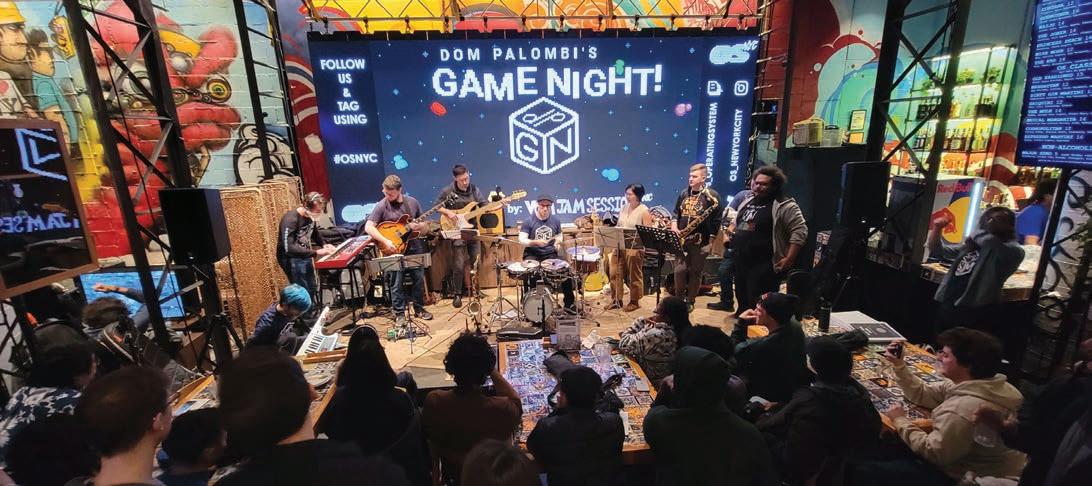
Musicians of all disciplines understand the importance of passing down traditions, both academically and aurally, and very often pop culture acts as a vehicle for this transmission. Much like our predecessors, we use video game songs—modern “standards” of our day.
Tchaikovsky ballet; “Area Zero” from Pokémon 6: Scarlet and Violet (2022) boasts a raging soundscape of electric guitars and synthesizers. In 2022, the VGM community also marked a milestone: Charlie Rosen and Jake Silverman won the first Grammy for a VGM song, in the category of “Best Arrangement, Instrumental or A Cappella,” for their take on “Meta Knight’s Revenge” from the 1996 video game Kirby Super Star.
Studying VGM has helped me greatly as a composer, especially in terms of working within limitations. The old Pokémon games had soundtracks that sounded like full ensembles but were composed on just three instrumental lines. Working within the boundaries of a Game Boy or video game console’s technical limitations forced older VGM composers to innovate orchestrally using
techniques like cross-voicing and multivoice counterpoint. (The secrets to achieving this fullness were broken down by a YouTuber called “8-bit Music Theory” in a video that any aspiring composer should check out: “Ya Got TRICKED: That Full Band was really just 3 Channels!”)
I’m now working on a feature-length film score for which I have a limited budget. While most composers in a similar situation would elect to use synthesizers to emulate real instruments, I’ve been able to produce a full-sounding score with a limited number of real instruments employing similar methods.
Musicians always look for new ways to connect with their audiences in search of a special kind of fulfillment that makes them feel understood. Too often, traditional
jazz jam sessions perpetuate an overly competitive environment where young musicians can feel judged or even silenced rather than celebrated by their colleagues and seniors, and where they are sometimes led to believe that they must play only music from a distant past. The VGM community is a nurturing space, where we can perform for one another free of judgment and misunderstanding and in which we revel in our shared inspiration.
Multi-reedist and composer Jasper Shogo Dutz serves as artistic director for VGM Jam Sessions NYC. He freelances with his own quartet, co-leads Catbus Collective (a six-piece ensemble specializing in Japanese pop and cinematic music), and is a full-time member of Arturo O’Farrill’s Grammy-winning Afro Latin Jazz Orchestra.
80 SPRING 2024
■ End Note
Photo: Brian Astronaut
The scene at a VGM jam session on February 3, 2023.
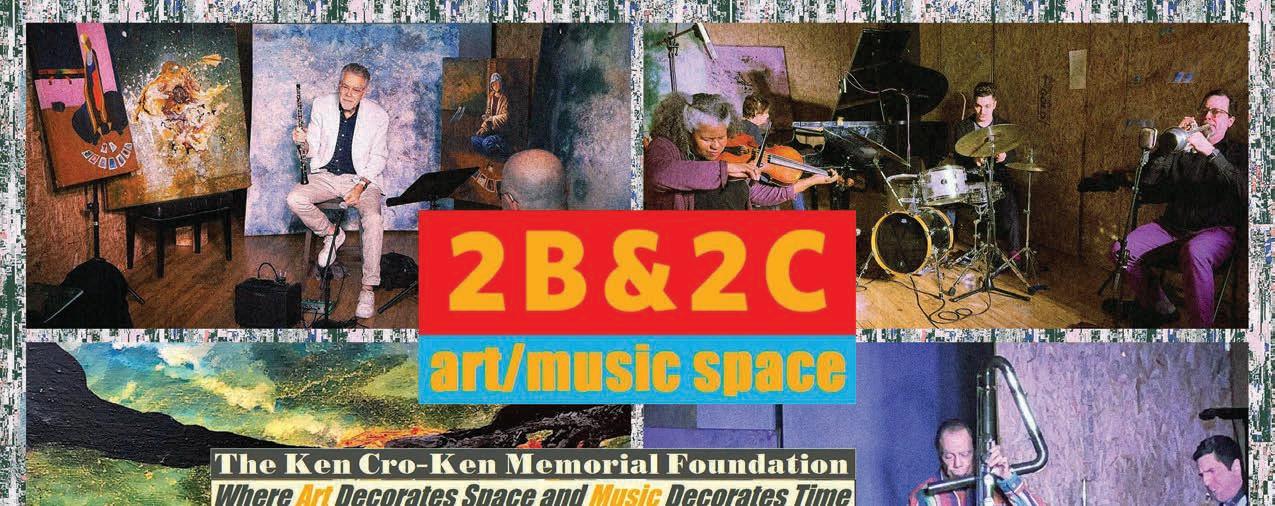
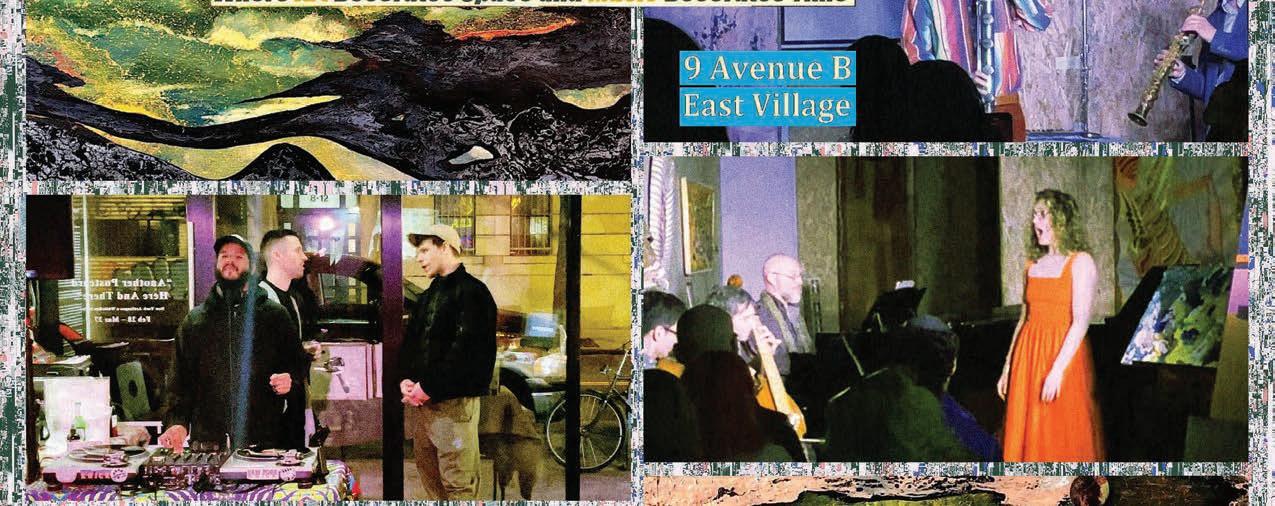














































 Aviram
Aviram














 BY Emery Kerekes
BY THE YELLOW LIGHT
BY Emery Kerekes
BY THE YELLOW LIGHT
















 page (clockwise from top left):
Kevin
page
from top):
page (clockwise from top left):
Kevin
page
from top):




































 Bassists Edgar Meyer (left) and Christian McBride (right)
Bassists Edgar Meyer (left) and Christian McBride (right)















 Sandbox Percussion
Joan Tower
Jennifer Frautschi
Jörg Widmann
Sandbox Percussion
Joan Tower
Jennifer Frautschi
Jörg Widmann


 Clockwise from top left: Min Xiao-Fen at Big Ears, 2024; Henry Threadgill, 2024; the electronic rock group Silver Apples, 2015.
Clockwise from top left: Min Xiao-Fen at Big Ears, 2024; Henry Threadgill, 2024; the electronic rock group Silver Apples, 2015.










 A student ensemble at the Sarasota Music Festival
Photo: Kim Gagnon
A student ensemble at the Sarasota Music Festival
Photo: Kim Gagnon




















































